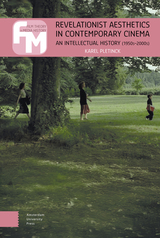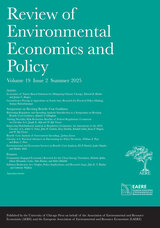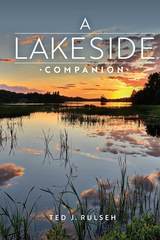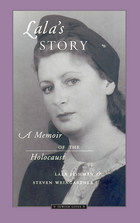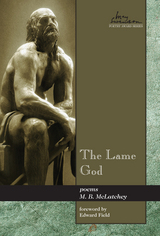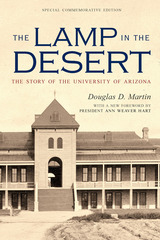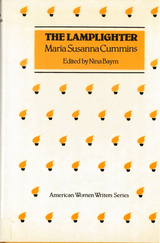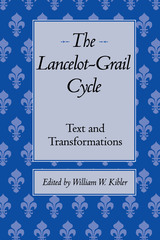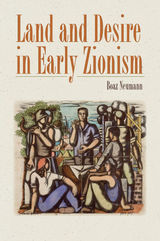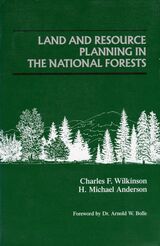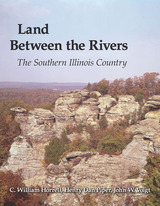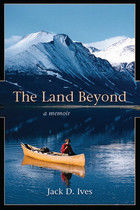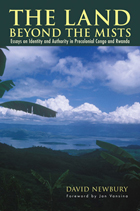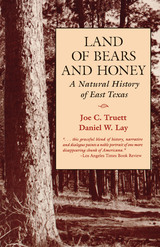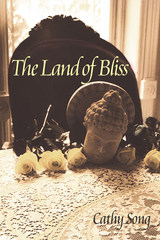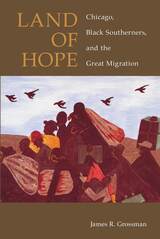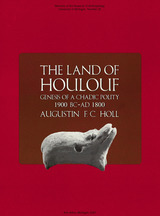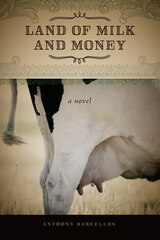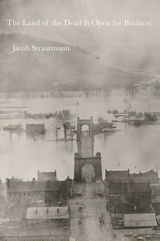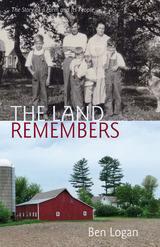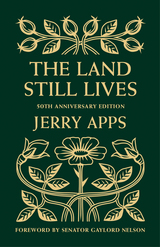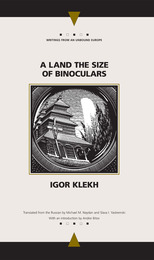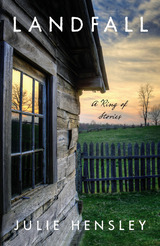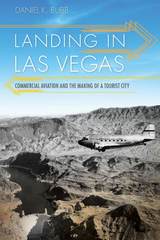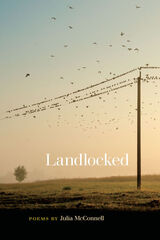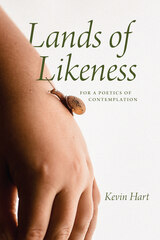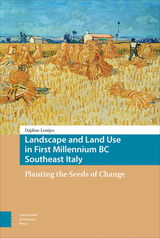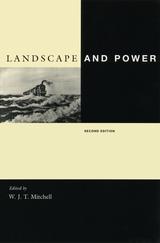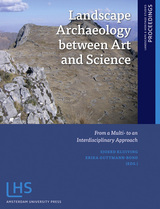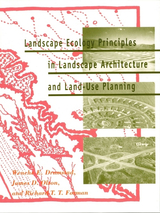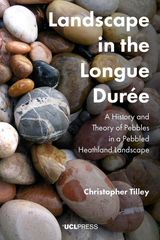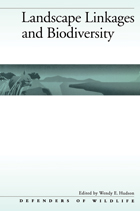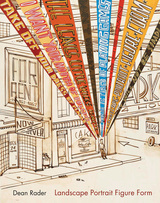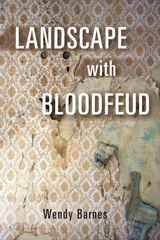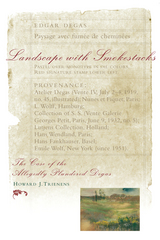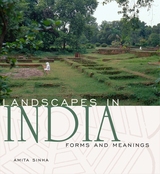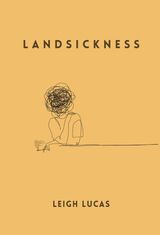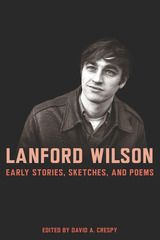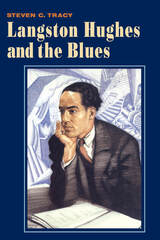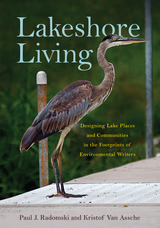 Lakeshore Living: Designing Lake Places and Communities in the Footprints of Environmental Writers
Paul J. Radomski
Michigan State University Press, 2014 In this remarkable and remarkably accessible synthesis of ecology, landscape design, and social sciences, the authors present an approach to lakeshore living that addresses the need to create rich, sustainable places and communities on the water, where both the loon and the family find a place, and where the cabin can be handed down with integrity to the grandchildren. Fragile shorelands require care, and that caring comes from knowledge, experience, and an environmental ethic. Radomski and Van Assche argue that an environmentally sensitive lakeshore place and community design is the way forward. While many factors affect the quality of lakes and lakeshore living, property owners and local communities do not have to wait until policies are perfect: the design approach advocated here can be applied in any place people living lakeside can get together and collaborate. The approach presented here is proactive and context sensitive: new designs have to fit the existing ecological, cultural, and policy landscapes. Development is always re-development in this sense. The authors introduce the reader step-by-step to this approach and carefully discuss leverage points that can be helpful in implementation and system change.
A Lakeside Companion
Ted J. Rulseh
University of Wisconsin Press, 2018 Why do fish jump? Why don't lakes freeze all the way down to the bottom? Which lake plants are invasive? What are those water bugs? Is that lake healthy? Whether you fish, paddle, swim, snowshoe, ski, or just gaze upon your favorite lake, A Lakeside Companion will deepen your appreciation for the forces that shape lakes and the teeming life in and around them.
You'll discover the interconnected worlds of a lake: the water; the sand, gravel, rocks, and muck of the bottom; the surface of the lake; the air above; and the shoreline, a belt of land incredibly rich in flora and fauna. Explained, too, are the physical, biological, and chemical processes that determine how many and what kinds of fish live in the lake, which plants grow there, the color and clarity of the water, how ice forms in winter and melts in spring, and much more. Useful advice will help you look out for your lake and advocate for its protection.
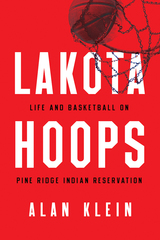 Lakota Hoops: Life and Basketball on Pine Ridge Indian Reservation
Alan Klein
Rutgers University Press, 2020 For over 150 years the Lakota have tenaciously defended their culture and land against white miners, settlers, missionaries, and the U.S. Army, and paid the price. Their economy is in shambles and they face serious social issues, but their culture and outlook remain vibrant. Basketball has a role to play in the way that people on Pine Ridge Indian Reservation configure their hopes for a better future, and for pride in their community.
In Lakota Hoops, anthropologist Alan Klein trains his experienced eye on the ways that Lakota traditions find a seamless expression in the sport. In a variety of way such as weaving time-honored religious practices into the game or extending the warrior spirit of Crazy Horse to the players on the court, basketball has become a preferred way of finding continuity with the past. But the game is also well suited to the present and has become the largest regular gathering for all Lakota, promoting national pride as well as a venue for the community to creatively and aggressively confront white bigotry when needed.
Richly researched and filled with interviews with Pine Ridge residents, including both male and female players, Lakota Hoops offers a compelling look at the highs and lows of a community that has made basketball its own.
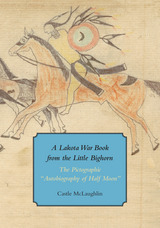 A Lakota War Book from the Little Bighorn: The Pictographic "Autobiography of Half Moon"
Castle McLaughlin
Harvard University Press, 2013 Houghton Library and Harvard’s Peabody Museum Press collaborated on the publication of this fourth volume in the Houghton Library Studies series, an innovative cultural analysis of the extraordinary composite document known as “The Pictographic Autobiography of Half Moon, an Unkpapa Sioux Chief.” At its core is a nineteenth-century ledger book of drawings by Lakota Sioux warriors found in 1876 in a funerary tipi on the Little Bighorn battlefield after Custer’s defeat. Journalist Phocion Howard later added an illustrated introduction and had it bound into the beautiful manuscript that is reproduced in complete color facsimile here.
Howard attributed all seventy-seven Native drawings to a “chief” named Half Moon, but anthropologist Castle McLaughlin demonstrates that these dramatic scenes, mostly of war exploits, were drawn by at least six different warrior-artists. Their vivid first-person depictions make up a rare Native American record of historic events that likely occurred between 1866 and 1868 during Red Cloud’s War along the Bozeman Trail.
McLaughlin probes the complex life history of this unique artifact of cross-cultural engagement, uncovering its origins, ownership, and cultural and historic significance, and compares it with other early ledger books. Examining how allied Lakota and Cheyenne warriors valued these graphic records of warfare as both objects and images, she introduces the concept of “war books”—documents that were captured and altered by Native warrior-artists to appropriate the strategic power of Euroamerican literacy.
Lala's Story: A Memoir of the Holocaust
Lala Fishman
Northwestern University Press, 1997 Winner of 1998 Carl Sandburg Award
Born into a middle-class Jewish family in 1932, Lala Weintraub grew up in Lvov, Poland. When the Nazis came, Lala—who had blond hair and blue eyes—survived by convincing them she was a Christian. This book tells her remarkable story. Fiercely determined and greatly aided by her Aryan looks, she managed to convince everyone—German soldiers, interrogators, fellow Poles—that she was a Polish gentile. Within a year after the Germans captured Lvov, many of Lala's family members were missing and presumed dead.
Lala's Story follows her as she moves from town to town, driven by her fear of being discovered. More than a story of survival, this is the story of a young girl's resolute struggle to defy, resist, and ultimately defeat the evil forces pursuing her.
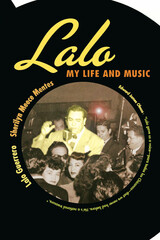 Lalo: My Life and Music
Lalo Guerrero and Sherilyn Meece Mentes
University of Arizona Press, 2002 He has been called "the father of Chicano music" and "the original Chicano hepcat." A modest man in awe of his own celebrity, he has sung of the joys and sorrows, dreams and frustrations of the Mexican American community over a sixty-year career. Lalo Guerrero is an American original, and his music jubilantly reflects the history of Chicano popular culture and music.
Lalo's autobiography takes readers on a musical rollercoaster, from his earliest enjoyment of Latino and black sounds in Tucson to his burgeoning career in Los Angeles singing with Los Carlistas, the quartet with which he began his recording career in 1938. During the fifties and sixties his music dominated the Latin American charts in both North and South America, and his song "Canción Mexicana" has become the unofficial anthem of Mexico. Through the years, Lalo mastered boleros, rancheras, salsas, mambos, cha-chas, and swing; he performed protest songs, children's music, and corridos that told of his people's struggles. Riding the crest of changing styles, he wrote pachuco boogies in one period and penned clever Spanish parodies of American hit songs in another. For all of these contributions to American music, Lalo was awarded a National Medal of the Arts from President Clinton.
Lalo's story is also the story of his times. We meet his family and earliest musical associates—including his long relationship with Manuel Acuña, who first got Lalo into the recording studio—and the many performers he counted as friends, from Frank Sinatra to Los Lobos. We relive the spirit of the nightclubs where he was a headliner and the one-night stands he performed all over the Southwest. We also discover what life was like in old Tucson and in mid-century L.A. as seen through the eyes of this uniquely creative artist. "In 1958," Guerrero recalls, "I wrote a song about a Martian who came to Earth to clear up certain misunderstandings about Mars. Now I have decided that it is time to set some things straight about Lalo Guerrero." Lalo does just that, in an often funny, sometimes sentimental story that traces the musical genius of a man whose talent has taken him all over the world, but who still believes in giving back to the community. His story is a gift to that community.
The book also features a detailed discography, compiled by Lalo's son Mark, tracing his recorded output from the days of 78s to his most recent CDs.
 The Lama Question: Violence, Sovereignty, and Exception in Early Socialist Mongolia
Christopher Kaplonski
University of Hawaii Press, 2014 Before becoming the second socialist country in the world (after the Soviet Union) in 1921, Mongolia had been a Buddhist feudal theocracy. Combatting the influence of the dominant Buddhist establishment to win the hearts and minds of the Mongolian people was one of the most important challenges faced by the new socialist government. It would take almost a decade and a half to resolve the “lama question,” and it would be answered with brutality, destruction, and mass killings. Chris Kaplonski examines this critical, violent time in the development of Mongolia as a nation-state and its ongoing struggle for independence and recognition in the twentieth century.
Unlike most studies that explore violence as the primary means by which states deal with their opponents, The Lama Question argues that the decision to resort to violence in Mongolia was not a quick one; neither was it a long-term strategy nor an out-of control escalation of orders but the outcome of a complex series of events and attempts by the government to be viewed as legitimate by the population. Kaplonski draws on a decade of research and archival resources to investigate the problematic relationships between religion and politics and geopolitics and biopolitics in early socialist Mongolia, as well as the multitude of state actions that preceded state brutality. By examining the incidents and transformations that resulted in violence and by viewing violence as a process rather than an event, his work not only challenges existing theories of political violence, but also offers another approach to the anthropology of the state. In particular, it presents an alternative model to philosopher Georgio Agamben’s theory of sovereignty and the state of exception.The Lama Question will be of interest to scholars and students of violence, the state, biopolitics, Buddhism, and socialism, as well as to those interested in the history of Mongolia and Asia in general.
 The Lama Who Flew: and Other Tales from My Village
Sange Dorjee Thongdok
Seagull Books, 2025 Step into the fireside glow of a Himalayan village, where the supernatural feels ordinary and every story is a spell waiting to be cast.
The Flying Lama: Tales Around the Hearth invites readers into the enchanting world of a small Himalayan village in Arunachal Pradesh, where the past lingers in every rustling leaf and the supernatural feels as close as the wind against one’s skin. Drawing from his Shertukpen heritage, Sange Dorjee Thongdok crafts a collection of stories brimming with mysticism and an unshakable connection to the rhythms of nature. A lama who seems to defy gravity, a village where tradition and modernity stand in quiet conversation—each tale is steeped in folklore and rendered with cinematic detail, divulging a world that is both remote and deeply familiar. Blending wry humor with profound emotion, Thongdok’s storytelling captures the essence of a place often overlooked, yet teeming with life.
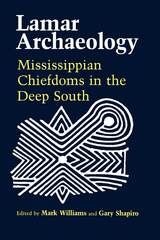 Lamar Archaeology: Mississippian Chiefdoms in the Deep South
Edited by Mark Williams and Gary Shapiro
University of Alabama Press, 1990 A Dan Josselyn Memorial Publication
Lamar Archaeology provides a comprehensive and detailed review of our knowledge of the late prehistoric Indian societies in the Southern Appalachian area and its peripheries. These Lamar societies were chiefdom-level groups who built most of the mounds in this large region and were ancestors of later tribes, including the Creeks and Cherokees. This book begins with a history of the last 50 years of archaeological and historical research and brings together for the first time all the available data on this early culture. It also provides an invaluable model for books about Southeastern Indian societies by combining purely descriptive information with innovative analyses, advancing our knowledge of the past while remaining firmly grounded in the archaeological evidence as fact.
Contributors include:
Frankie Snow, Chad O. Braley, James B. Langford Jr., Marvin T. Smith, Daniel T. Elliott, Richard R. Polhemus, C. Roger Nance, Gary Shapiro, Mark Williams, John F. Scarry, David G. Anderson, andCharles M. Hudson
The Lamarck Manuscripts at Harvard
William M. Wheeler
Harvard University Press This volume contains a transcript of the original French text and an English translation of the six manuscripts of Lamarck in the library of the Museum of Comparative Zoology. The first manuscript, a lecture on Gall’s conception of the human brain, is of unusual interest because so little is known concerning Lamarck’s medical education. The sixth manuscript contains an account of an eighteenth century botanical excursion. A few of the drawings which accompany the text of one of the manuscripts are reproduced, and a general account of the various manuscripts, with Crookshank’s comparison of the life-plans of Lamarck and Darwin, is given in the Introduction.
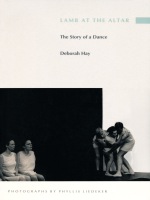 Lamb at the Altar: The Story of a Dance
Deborah Hay
Duke University Press, 1994 "The intention of my work is to dislodge assumptions about the fixity of the three-dimensional body."—Deborah Hay Her movements are uncharacteristic, her words subversive, her dances unlike anything done before—and this is the story of how it all works. A founding member of the famed Judson Dance Theater and a past performer in the Merce Cunningham Dance Company, Deborah Hay is well known for choreographing works using large groups of trained and untrained dancers whose surprising combinations test the limits of the art. Lamb at the Altar is Hay’s account of a four-month seminar on movement and performance held in Austin, Texas, in 1991. There, forty-four trained and untrained dancers became the human laboratory for Hay’s creation of the dance Lamb, lamb, lamb . . . , a work that she later distilled into an evening-length solo piece, Lamb at the Altar. In her book, in part a reflection on her life as a dancer and choreographer, Hay tells how this dance came to be. She includes a movement libretto (a prose dance score) and numerous photographs by Phyllis Liedeker documenting the dance’s four-month emergence.
In an original style that has marked her teaching and writing, Hay describes her thoughts as the dance progresses, commenting on the process and on the work itself, and ultimately creating a remarkable document on the movements—precise and mysterious, mental and physical—that go into the making of a dance. Having replaced traditional movement technique with a form she calls a performance meditation practice, Hay describes how dance is enlivened, as is each living moment, by the perception of dying and then involves a freeing of this perception from emotional, psychological, clinical, and cultural attitudes into movement. Lamb at the Altar tells the story of this process as specifically practiced in the creation of a single piece.
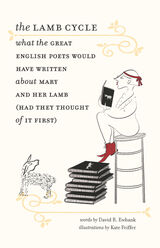 The Lamb Cycle: What the Great English Poets Would Have Written About Mary and Her Lamb (Had They Thought of It First)
David R. Ewbank
Brandeis University Press, 2023 The rhyme “Mary Had a Little Lamb” told in the style—and substance—of the great English poets from Edmund Spenser to Stevie Smith.
In The Lamb Cycle, David R. Ewbank achieves the unthinkable—he writes so convincingly in the style of the great English poets that one could be lulled into thinking that Shakespeare himself was inspired to muse upon the subject of “Mary Had a Little Lamb.” Ewbank captures not only the style of each of the poets he chooses, but also their preoccupations and subject matter. So D.H. Lawrence’s Mary longs for her lamb as any woman longing for her lover, whilst T.S. Eliot’s Mary is recollected by an old man looking back on his life. Alexander Pope writes an “An Essay on Lambs,” and Tennyson’s lotus eaters become “The Clover Eater.” Brilliantly written, sophisticated, and laugh-out-loud funny, these poems, enhanced by Kate Feiffer’s charming illustrations, will enchant anyone who has ever read an English poem.
 Lambs in Winter: Sketches of a Vermont Life Through Seasons of Change
Alexis Lathem
University of Massachusetts Press, 2025 Finding hope in a small farm, an engaged community, and an age-old connection to the earth
After half a lifetime spent moving from place to place, Alexis Lathem at last settled down with her husband on a small farm near Vermont’s largest city. The lyric essays of Lambs in Winter take readers through the seasonal cycles of raising sheep and hens and growing fruits and vegetables while confronting the challenges of winter storms, summer floods, invasive weeds, and pests and diseases.
Ever conscious of her place in a historically colonized and ecologically degraded landscape, Lathem wrestles with ethical questions that come to many rural dwellers who—following Thoreau—set out to “live deliberately,” in a time of climate crisis, persistent racial inequity, and growing economic inequality. Likewise, she grapples with the moral complexities of small-scale animal husbandry. Through her efforts at self-provisioning, without holding illusions of the self-reliant individual, Lathem finds herself deeply embedded in the community and reliant on others, especially as her region deals with repeated catastrophic flooding brought on by climate change.
Through elegant prose and insightful investigations into pressing contemporary issues, Lathem evokes the world of her farm and the surrounding countryside with a spiritual awareness of the human journey on this earth. Living in place, attuned to the unfolding changes in the world around her, gives her much to grieve, but the pages of Lambs in Winter are luminous with moments of joy and beauty.
The Lame God
M. B. McLatchey
Utah State University Press, 2013 Winner of 2013 May Swenson Poetry Award
In The Lame God, author M. B. McLatchey reminds us of the inevitable bond between art and empathy. With a controlled language that finds its echo chamber in the immortal themes and characters of classical literature, this courageous work accompanies the author on her journey through a parent’s anguish in the face of a horrific crime. Using the art of poetry she gives voice to a suffering—and a love—that might otherwise go unheard. The May Swenson Poetry Award, an annual competition named for May Swenson, honors her as one of America's most provocative and vital writers. During her long career, Swenson was loved and praised by writers from virtually every school of American poetry. She left a legacy of fifty years of writing when she died in 1989. She is buried in Logan, Utah, her hometown.
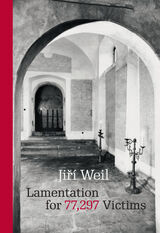 Lamentation for 77,297 Victims
Jirí Weil
Karolinum Press, 2020 “Smoke from nearby factories shrouds a countryside as flat as a table, a countryside stretching off to infinity. Covering it are the ashes of millions of dead. Scattered throughout are fine pieces of bone that ovens were not able to burn. When the wind comes, ashes rise to the heavens, bone fragments remain on the ground. And rain falls on the ashes, and rain turns them to good fertile soil, as befits the ashes of martyrs. And who can find the ashes of those from my native land, of whom there were 77,297? I gather some ashes with my hand, for only a hand can touch them, and I pour them into a linen sack, just as those who once left for a foreign country would gather their native soil so as never to forget, so as always to return to it.”
So begins Jiří Weil’s unforgettable prose poem, Lamentation for 77, 297 Victims, his literary monument to the Czech Jews killed during the Holocaust. A Czech-Jewish writer who worked at Prague’s Jewish Museum both during and after the Nazi Occupation—he survived the Holocaust by faking his own death and hiding out until the war had ended—Weil wrote Lamentation while he served as the museum’s senior librarian in the 1950s. This remarkable literary experiment presents a number of innovative approaches to writing about a horror many would deem indescribable, combining a narrative account of the Shoah with newspaper-style reportage on a handful of the lives ended by the Holocaust and quotes from the Hebrew Bible to create a specific and powerful portrait of loss and remembrance. Translated by David Lightfoot, Lamentation for 77,297 Victims is a startling and singular introduction to a writer whose works have been acclaimed by Philip Roth, Michiko Kakutani, and Siri Hustvedt.
 Lamentations of Youth: The Diaries of Gershom Scholem, 1913-1919
Gershom Scholem
Harvard University Press, 2007 For decades, Gershom Scholem kept these diaries locked away, returning to them only to refresh his memory of past events and eloquent observations. They remained unread by others until the meticulously edited German edition of this book appeared in 2002.
Lamentations of Youth gives insight into a crucial stage in Scholem's life, beginning when he was a student in Berlin during the First World War, a time of incubation and growth for his later ideas. Much of the journal writing, however, took place in Switzerland, a magnet for radical artists, socialist intellectuals, and revolutionaries fleeing war. The diaries are where Scholem forges his anarchic orthodoxy, and where he chronicles his intense relationship with Walter Benjamin. Many entries have the crisp quality of literary aphorisms crafted in the great German tradition of Kafka and Canetti.
For Scholem and Benjamin, the time they spent together in Switzerland spawned an astoundingly original view of literary criticism, interpretation, and cultural transmission. More personally, the themes of friendship, love, and heartbreak that dominate these pages later reemerge in Scholem's scholarship. No longer is the inner life of the critic seen as distinct from his textual criticism--they are deeply and esoterically intertwined.
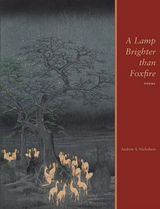 A Lamp Brighter than Foxfire
Andrew S. Nicholson
University Press of Colorado, 2015 "In Andrew S. Nicholson’s A Lamp Brighter than Foxfire, what is most alive is color, that which gives itself freely, generously: ‘Follow the hopeful as they green the day’ (‘My Garage Fills with an Ever-Increasing Number of Dandelions’). Threaded throughout with Genesis, wherein Jacob wrestles an angel, this gorgeous debut collection builds a ladder firmly rooted here: in sun and earth; in varying and multiple shades of orange; in trials of father and son; in books and paintings; in abandoned casinos; in countries far from home; and/or in the sound of a door closing. Nicholson’s poems come from a man standing by himself, in what George Oppen called the ‘shipwreck of the singular,’ which includes everybody. I’m moved by the luminous generosity, the moral clarity of this work. A Lamp Brighter than Foxfire is news that will stay news.”
—Claudia Keelan, author of The Devotion Field, Missing Her, and O, Heart
"'Who doesn’t nurse a secret love?' asks Andrew S. Nicholson in visionary poems that reveal secret worlds cradled inside this one. Whether considering the casinos of Las Vegas, a fresco in Pompeii, or scenes from the Hebrew Bible, the poet endures one of desire’s more fraught paradoxes: its unchanging ability to bring change, to turn the known into the unknown. These poems bravely attend to such transformations the way Jacob—the book’s patron saint—wrestles with the angel, 'lifting all the flesh / that he can lose.' I admire this poet who knows that blessing doesn’t arrive without loss, who remembers 'I was loved once. / Beneath that love, a kindness took root.' The same sweet feeling lingers long after this book is closed. Dear reader: savor it."
—Brian Teare
"Andrew S. Nicholson’s A Lamp Brighter than Foxfire is a gorgeous book. His graceful, playful poems enchant us ('I try to make out the stranger’s face, but he’s shrinking: / a melting gray blur, an ever-smaller thorn.') and transform us ('Sink into the bathwater, any way is a way / to journey toward that joining'). Nicholson has become one of the great poets of a new and radical kind of pastoral."
—Joseph Lease Opening the space between the ordinary and the visionary, the poems in A Lamp Brighter than Foxfire uncover an intimate relationship with the world, from Las Vegas to Italy to the American Midwest. From a lime glowing in an orchard to a miraculous childhood attempt at levitation, Andrew S. Nicholson’s poems ground themselves in the commonplace and leap for the luminous. Central to this collection are poems that retell stories of Jacob from the Old Testament, relocated behind casinos, glimpsed in miniature on kitchen floors, and heard speaking in a moment of decay. Through these retellings, Nicholson examines the creation of self, family relationships, and a generative sense of the divine.
The Lamp in the Desert: The Story of the University of Arizona
Douglas D. Martin, With a New Foreword by President Ann Weaver Hart
University of Arizona Press, 1960 With six teachers, no books, and thirty-two students, Old Main opened its doors to the first pupils of the University of Arizona in 1891. A rugged beacon among the cacti, the campus emerged from a forty-acre donation from two gamblers and a saloonkeeper. The Lamp in the Desert is Douglas D. Martin’s history of the first seventy-five years of the University of Arizona. From early football wins by Coach McKale to the work of celebrated scholars, this is a story of the places and the people whose names are still visible reminders of the early innovators that helped to build a world-class institution.
'The Lamplighter' by Maria Susanna Cummins
Baym, Nina
Rutgers University Press, 1988 The Lamplighter was the first novel by twenty-seven-year-old Maria Susanna Cummins. It propelled her into a prominence that continued until her early death at the age of thirty-nine. A novel of female development, The Lamplighter is a woman's version of the quest story. Its heroine, Gerty, comes on the scene as a child abandoned in the slums of Boston. Rescued by the kindly lamplighter Trueman Flint, she learns to meet life with courage and honesty. The novel touched the hearts, validated the ideals, and assuaged the anxieties of a huge readership, and it remained continuously in print until the 1920s.
 Lamps at High Noon
Jack S. Balch
University of Illinois Press, 1941 The Federal Arts Projects were created by FDR in the summer of 1935. A year later, a handful of writers employed in the St. Louis office of the Missouri Writers' Project, including Jack Balch, went out on strike. Lamps at High Noon is the only novel about this strike and the only one to treat comprehensively any aspect of the Federal Writers' Project, whose participants included some of the country's most accomplished and promising authors.
Charlie Gest, the wide-eyed and well-intentioned protagonist of the novel, confronts firsthand the project's sometimes underhanded efforts to monitor the political views of its writers. Named assistant director of the project in Monroe (a fictional St. Louis), Gest is vaguely aware that the program's good intentions do not always overshadow the abuses it tolerates, which include shielding corporate interests and avoiding hiring highly qualified black writers. Gest is hounded by a nagging suspicion that, like lamps that burn in broad daylight, the issues at stake in the work stoppage are not the ones that most need addressing.
Part radical socialist commentary, part absurdist theater, Balch's novel offers a peerless critical engagement of the economic constraints and political exigencies surrounding debates over the federal funding of art since the New Deal.
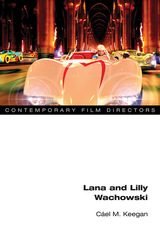 Lana and Lilly Wachowski
Cael M. Keegan
University of Illinois Press, 2018 Lana and Lilly Wachowski have redefined the technically and topically possible while joyfully defying audience expectations. Visionary films like The Matrix trilogy and Cloud Atlas have made them the world's most influential transgender media producers, and their coming out retroactively put trans* aesthetics at the very center of popular American culture. Cáel M. Keegan views the Wachowskis' films as an approach to trans* experience that maps a transgender journey and the promise we might learn "to sense beyond the limits of the given world." Keegan reveals how the filmmakers take up the relationship between identity and coding (be it computers or genes), inheritance and belonging, and how transgender becoming connects to a utopian vision of a post-racial order. Along the way, he theorizes a trans* aesthetic that explores the plasticity of cinema to create new social worlds, new temporalities, and new sensory inputs and outputs. Film comes to disrupt, rearrange, and evolve the cinematic exchange with the senses in the same manner that trans* disrupts, rearranges, and evolves discrete genders and sexes.
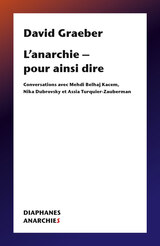 L’anarchie – pour ainsi dire: Conversations avec Mehdi Belhaj Kacem, Nika Dubrovsky et Assia Turquier Zauberman
David Graeber
Diaphanes, 2020 David Graeber n’est pas seulement l’un des plus importants penseurs vivants. Il est aussi l’un des plus influents, mais, au contraire de bien d’intellectuels « engagés », l’un des très rares à avoir fait preuve d’une efficacité militante à répercussion mondiale. Nul n’a peut-être autant « impacté » sur la gauche internationale que cet homme.Tant par ses grands concepts comme ceux de la dette, de la bureaucratie ou des bullshit jobs, que par son implication cruciale dans le mouvement Occupy Wall Street, qui lui a valu un exil quasi forcé de son pays d’origine, il est peut-être l’intellectuel vivant à offrir le plus de pistes crédibles pour la sortie du capitalisme.
Se revendiquant depuis toujours anarchiste, dans ce livre d'entretiens avec Assia Turquier Zauberman et Mehdi Belhaj Kacem, Graeber parle tant sur l’histoire de l’anarchie que sur sa pertinence contemporaine et sur son avenir; tant sur les liens qui unissent l’anthropologie à l’anarchisme qu’aux « traces ADN » de celui-ci dans le mouvement d’OWS ou dans celui des gilets jaunes; sur la signification de l’éthique anarchiste non seulement dans sa portée politique, mais esthétique et artistique, sexuelle et amoureuse, etc.
Avec une verve étonnante de vivacité, de drôlerie et d’érudition, le présent livre contribue à redéfinir les contours de ce que pourrait être, comme le disait Kropotkine, une « morale anarchiste » aujourd’hui.
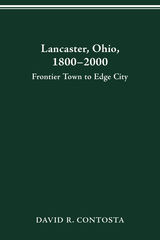 Lancaster, Ohio, 1800–2000: FRONTIER TOWN TO EDGE CITY
David R. Contosta
Ohio State University Press, 2000 In Lancaster, Ohio, 1800–2000, David R. Contosta tells the story of one American town as it has evolved over a two-hundred year period. Contosta has found that Lancaster was never the sort of idyllic community that writers once imagined for small towns; nor was it the social and cultural wasteland that social critics portrayed during most of the twentieth century.
In explaining why Lancaster has remained a small but relatively successful community for some twenty decades, Contosta looks at various factors, including location, natural resources, technology, transportation systems, local leaders, historic preservation, awareness of local history, and national as well as international events.
As the twenty-first century begins, the widespread use of the automobile, advances in technology, and Lancaster’s proximity to the state capital, Columbus, are transforming the community into something new—part town, part city, and part suburb—a phenomenon that is emerging in hundreds of older communities throughout the United States. Contosta’s history of the development of one small town, and the over one hundred illustrations enhancing the text, offer a microcosm of the profound changes in American life over two centuries.
The Lancelot-Grail Cycle: Text and Transformations
Edited by William W. Kibler
University of Texas Press, 1994 Composed in Old French between about 1220 and 1240, the Lancelot-Grail Cycle is a group of five prose romances centered on the love affair between Lancelot and Guenevere. It consists of an immense central core, the Lancelot Proper, introduced by The History of the Holy Grail and The Story of Merlin and concluded by The Quest for the Holy Grail and The Death of Arthur. This volume brings together thirteen essays by noted scholars from the first symposium ever devoted exclusively to the Lancelot-Grail Cycle. Exploring the cycle's evolution across the literatures of medieval France, Italy, Spain, Catalonia, and England, the authors take a variety of approaches that highlight a broad range of cultural, social, historical, and political concerns and offer a comparative and interdisciplinary vision of this great romance.
Land and Desire in Early Zionism
Boaz Neumann
Brandeis University Press, 2011 This innovative study examines the responses of early-twentieth-century pioneers to “the Land” of Palestine. Early Zionist historiography portrayed these young settlers as heroic; later, more critical studies by the “new” historians and sociologists focused on their failures and shortcomings. Neumann argues for something else that historians have yet to identify—desire. Desire for the Land and a visceral identification with it begin to explain the pioneer experience and its impact on Israeli history and collective memory, as well as on Israelis’ abiding connection to the Land of Israel. His close readings of archival documents, memoirs, diaries, poetry, and prose of the period develop new understandings—many of them utterly surprising—of the Zionist enterprise. For Neumann, the Zionist revolution was an existential revolution: for the pioneers, to be in the Land of Israel was to be!
Land and Resource Planning in the National Forests
Charles F. Wilkinson
Island Press, 1987 This comprehensive, in-depth review and analysis of planning, policy, and law in the National Forest System is the standard reference source on the National Forest Management Act (NFMA) of 1976. It is a clearly written, nontechnical book that offers an insightful analysis of the Fifty Year Plans and how to participate in and influence them.
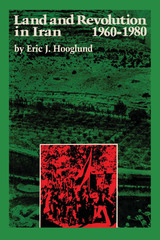 Land and Revolution in Iran, 1960–1980
By Eric J. Hooglund
University of Texas Press, 1982 Carried out by the government of the shah between 1962 and 1971, the Iranian land reform was one of the most ambitious such undertakings in modern Middle Eastern history. Yet, beneath apparent statistical success, the actual accomplishments of the program, in terms of positive benefits for the peasantry, were negligible. Later, the resulting widespread discontent of thousands of Iranian villagers would contribute to the shah's downfall. In the first major study of the effects of this widely publicized program, Eric Hooglund's analysis demonstrates that the primary motives behind the land reform were political. Attempting to supplant the near-absolute authority of the landlord class over the countryside, the central government hoped to extend its own authority throughout rural Iran. While the Pahlavi government accomplished this goal, its failure to implement effective structural reform proved to be a long-term liability. Hooglund, who conducted field research in rural Iran throughout the 1970s and who witnessed the unfolding of the revolution from a small village, provides a careful description of the development of the land reform and of its effects on the main groups involved: landlords, peasants, local officials, merchants, and brokers. He shows how the continuing poverty in the countryside forced the migration of thousands of peasants to the cities, resulting in serious shortages of agricultural workers and an oversupply of unskilled urban labor. When the shah's government was faced with mass opposition in the cities in 1978, not only did a disillusioned rural population fail to support the regime, but thousands of villagers participated in the protests that hastened the collapse of the monarchy.
 Land and Sea: The Lyric Poetry of Philip Freneau
Richard C. Vitzthum
University of Minnesota Press, 1978 Land and Sea was first published in 1978. Minnesota Archive Editions uses digital technology to make long-unavailable books once again accessible, and are published unaltered from the original University of Minnesota Press editions. Although Philip Freneau is best known as the poet of the American Revolution, half his poems had nothing to do with the war, Professor Vitzthum points out, and this, the first systematic, in-depth study of Freneau's lyric poetry, provides a fresh perspective on the poet's non-political work. Demonstrating that there is a heretofore unrecognized pattern of land-sea imagery and symbolism in Freneau's best work. Professor Vitzthum traces changes reflected in this imagery to developments in the poet's thought, which in turn related to major intellectual and literary trends in revolutionary and early republican America. An introductory chapter assesses twentieth century biographical and critical estimates of Freneau, outlines the key themes in his work, and links his thirty-year career as sailor and ship captain to his creation of a covert, symbolistic poetic method. The following five chapters chronologically discuss Freneau's non-political poems from 1772 through 1815. Professor Vitzthum concludes that Freneau was not the derivative and unsuccessful artist he is currently thought to have been but, rather, one of America's genuinely important poets.
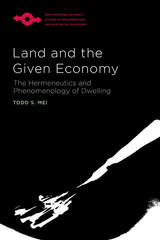 Land and the Given Economy: The Hermeneutics and Phenomenology of Dwelling
Todd S. Mei
Northwestern University Press, 2017 Alarming environmental degradation makes ever more urgent the reconciliation of political economy and sustainability. Land and the Given Economy examines how the landed basis of human existence converges with economics, and it offers a persuasive new conception of land that transcends the flawed and inadequate accounts in classical and neoclassical economics. Todd S. Mei grounds this work in a rigorous review of problematic economic conceptions of land in the work of John Locke, Adam Smith, David Ricardo, John Stuart Mill, Karl Marx, Henry George, Alfred Marshall, and Thorstein Veblen. Mei then draws on the thought of Martin Heidegger to posit a philosophical clarification of the meaning of land—its ontological nature. He argues that central to rethinking land is recognizing its unique manner of being, described as its "givenness." Concluding with a discussion of ground rent, Mei reflects on specific strategies for incorporating the philosophical account of land into contemporary economic policies. Revivifying economic frameworks that fail to resolve the impasse between economic development and sustainability, Land and the Given Economy offers much of interest to scholars and readers of philosophy, environmentalism, and the full spectrum of political economy.
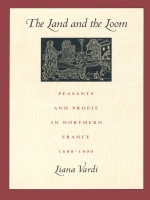 The Land and the Loom: Peasants and Profit in Northern France, 1680–1800
Liana Vardi
Duke University Press, 1993 In the modern imagination the peasant survives as a creature of the land, suspicious of the outside world and resistant to change, either the repository of pristine innocence and virtue or the manifestation of everything nasty, brutish, and at best dull. The Land and the Loom replaces this picture with a richly textured, deeply researched portrait of the peasant's life and world in northern France in the early modern period.
Drawing on evidence culled from parish registers, notarial records, and judicial archives, Liana Vardi outlines the development of the linen weaving trade in Montigny and details the local peasants' participation. The peasants that emerge from her study are not the figures of tradition, driven solely by symbolic attachment to the land and unreasonably devoted to village solidarities. Instead they reveal remarkable flexibility and diversity, not only improving farming methods and raising yields during the eighteenth century, but also using land to finance investments in industry and to develop local business, far-flung commercial networks and complex credit mechanisms. The eighteenth-century French countryside appears as a region and time of capitalist experimentation, cut short by pre-Revolutionary and Revolutionary crises.
Meticulously documented, broadly interpretive, and beautifully written, this fascinating book will permenantly alter conventional perceptions of peasant life and rural industry and, ultimately, the way ordinary people are seen in seemingly distant times and places.
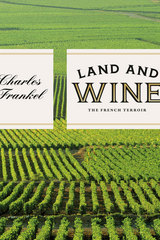 Land and Wine: The French Terroir
Charles Frankel
University of Chicago Press, 2014 A tour of the French winemaking regions to illustrate how the soil, underlying bedrock, relief, and microclimate shape the personality of a wine.
For centuries, France has long been the world’s greatest wine-producing country. Its wines are the global gold standard, prized by collectors, and its winemaking regions each offer unique tasting experiences, from the spice of Bordeaux to the berry notes of the Loire Valley. Although grape variety, climate, and the skill of the winemaker are essential in making good wine, the foundation of a wine’s character is the soil in which its grapes are grown. Who could better guide us through the relationship between the French land and the wine than a geologist, someone who deeply understands the science behind the soil? Enter scientist Charles Frankel.
In Land and Wine, Frankel takes readers on a tour of the French winemaking regions to illustrate how the soil, underlying bedrock, relief, and microclimate shape the personality of a wine. The book’s twelve chapters each focus in-depth on a different region, including the Loire Valley, Alsace, Burgundy, Champagne, Provence, the Rhône valley, and Bordeaux, to explore the full meaning of terroir. In this approachable guide, Frankel describes how Cabernet Franc takes on a completely different character depending on whether it is grown on gravel or limestone; how Sauvignon yields three different products in the hills of Sancerre when rooted in limestone, marl, or flint; how Pinot Noir will give radically different wines on a single hill in Burgundy as the vines progress upslope; and how the soil of each château in Bordeaux has a say in the blend ratios of Merlot and Cabernet-Sauvignon. Land and Wine provides a detailed understanding of the variety of French wine as well as a look at the geological history of France, complete with volcanic eruptions, a parade of dinosaurs, and a menagerie of evolution that has left its fossils flavoring the vineyards.
Both the uninitiated wine drinker and the confirmed oenophile will find much to savor in this fun guide that Frankel has spiked with anecdotes about winemakers and historic wine enthusiasts—revealing which kings, poets, and philosophers liked which wines best—while offering travel tips and itineraries for visiting the wineries today.
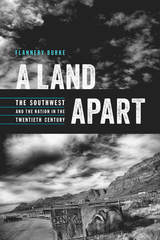 A Land Apart: The Southwest and the Nation in the Twentieth Century
Flannery Burke
University of Arizona Press, 2017 Winner, Spur Award for Best Contemporary Nonfiction (Western Writers of America)
A Land Apart is not just a cultural history of the modern Southwest—it is a complete rethinking and recentering of the key players and primary events marking the Southwest in the twentieth century. Historian Flannery Burke emphasizes how indigenous, Hispanic, and other non-white people negotiated their rightful place in the Southwest. Readers visit the region’s top tourist attractions and find out how they got there, listen to the debates of Native people as they sought to establish independence for themselves in the modern United States, and ponder the significance of the U.S.-Mexico border in a place that used to be Mexico. Burke emphasizes policy over politicians, communities over individuals, and stories over simple narratives. Burke argues that the Southwest’s reputation as a region on the margins of the nation has caused many of its problems in the twentieth century. She proposes that, as they consider the future, Americans should view New Mexico and Arizona as close neighbors rather than distant siblings, pay attention to the region’s history as Mexican and indigenous space, bear witness to the area’s inequalities, and listen to the Southwest’s stories. Burke explains that two core parts of southwestern history are the development of the nuclear bomb and subsequent uranium mining, and she maintains that these are not merely a critical facet in the history of World War II and the militarization of the American West but central to an understanding of the region’s energy future, its environmental health, and southwesterners’ conception of home. Burke masterfully crafts an engaging and accessible history that will interest historians and lay readers alike. It is for anyone interested in using the past to understand the present and the future of not only the region but the nation as a whole.
 Land Back: Relational Landscapes of Indigenous Resistance across the Americas
Heather Dorries and Michelle Daigle
Harvard University Press Relationships with land are fundamental components of Indigenous worldviews, politics, and identity. The disruption of land relations is a defining feature of colonialism; colonial governments and capitalist industries have violently dispossessed Indigenous lands, and have undermined Indigenous political authority through the production of racialized and gendered hierarchies of difference. Consequently, Indigenous resistance and visions for justice and liberation are bound up with land and land-body relationships that challenge colonial power. “Land back” has become a slogan for Indigenous land protectors across the Americas, reflecting how relations to land are foundational to calls for decolonization and liberation.
Land Back highlights the ways Indigenous peoples and anti-colonial co-resistors understand land relations for political resurgence and freedom across the Americas. Contributors place Indigenous practices of freedom within the particularities of Indigenous place-based laws, cosmologies, and diplomacies, while also demonstrating how Indigeneity is shaped across colonial borders. Collectively, they examine the relationships among language, Indigenous ontologies, and land reclamation; Indigenous ecology and restoration; the interconnectivity of environmental exploitation and racial, class, and gender exploitation; Indigenous diasporic movement; community urban planning; transnational organizing and relational anti-racist place-making; and the role of storytelling and children in movements for liberation.
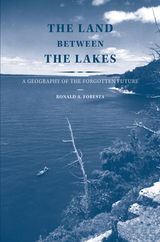 The Land Between the Lakes: A Geography of the Forgotten Future
Ronald A. Foresta
University of Tennessee Press, 2013 Between Barkley and Kentucky Lakes—two great, artificial bodies of water in western Tennessee and western Kentucky—lies a wooded land that looks from above like the flattened thumb of a green giant. Once a land of marginal farms and small settlements, this 240-square-mile peninsula, known as the Land Between the Lakes, has been a national recreation area for the last half-century. Its rolling, wooded hills and open bottomlands give the place charm but little majesty. The place swallows up its few campgrounds and visitors they attracts, creating a vacuous tranquility. In this volume, Foresta explores how this forgotten and bypassed region became a national recreation area. He uses its history to retrieve our old attitudes toward nature, progress, and personal development. He also uses its history to retrieve a vision of the future that rallied idealists, intellectuals, and even public officials to its banner.
In the early 1960s, the Tennessee Valley Authority set out to create a great park for posterity at the Land Between the Lakes. The park was to host the vast stretches of leisure that wealthy, secure, and more equal Americans of the late twentieth and early twenty-first centuries would have at their disposal. It would be a place where such Americans could turn that leisure into happiness, psychic well-being, and strength of character. The TVA cleared the land of its inhabitants to create the park, removing people from their homes and severing their roots, thus effacing the history of the place. It then set about reshaping the land in the image of an anticipated future. But when that future never arrived, managers struggled to fit the place to the America that actually came into being. In the end they failed, leaving the Land Between the Lakes enveloped in a haunting sense of emptiness.
A deft blend of environmental history, geography, politics, and cultural history, Land Between the Lakes demonstrates both the idealism of mid-twentieth-century planners and how quickly such idealism can fall out of alignment with the flow of history. In so doing it explores a forgotten vision of the future that was in many ways more appealing than the present that came into being in its place.
Land Between the Rivers: The Southern Illinois Country
C. William Horrell, Henry Dan Piper, John W. Voigt
Southern Illinois University Press, 1973 Situated between the Wabash, Ohio and Mississippi Rivers, the Southern Illinois country is rich in history, folklore, scenery, and natural resources. At about the latitude of southern Virginia, and extending from the flat prairie farmland of central Illinois to the rugged Illinois Ozarks, the area is the natural terminal boundary for hundreds of plant species reaching out to all points of the compass. It is also the oldest and most sparsely populated part of Illinois, a region of small towns and independent people.
Surveying the area in words and pictures, the authors sensitively and appreciatively portray the region’s special qualities. Land Between the Rivers, a perennial classic since it was first published in 1973, provides an uncommon portrayal of American life in a distinct region, a memorable journey in both time and place.
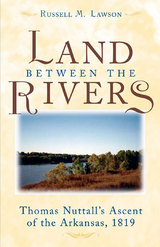 The Land between the Rivers: Thomas Nuttall's Ascent of the Arkansas, 1819
Russell M. Lawson
University of Michigan Press, 2004 An adventure story from the wilds of early America, The Land between the Rivers recreates the journeys of the English botanist Thomas Nuttall, one of American history's most well-traveled scientists.
During the early nineteenth century, Nuttall explored the waters, valleys, plains, and mountains of the Great Lakes, Ohio River, Mississippi River, as well as the Missouri, Arkansas, Red, and Canadian river valleys of the former Louisiana Territory.
In this fascinating account of Nuttall's travels through the wilderness of the middle west, author Russell Lawson-using Nuttall's own journal-captures the sense of excitement of the early wanderer. As much a delight for the mind as the senses, The Land between the Rivers details the unremitting weather and rugged geography of uncharted lands within the Louisiana Territory. A sense of discovery pervades the narrative as Nuttall's odyssey builds to its climax in the prairie wilderness of what is now Oklahoma. Sickened by "ague"-in his case, malaria-Nuttall at times was barely able to go on; yet he continued to search for and catalog plants and animals.
The Land between the Rivers expands our knowledge of the work of one of the country's earliest botanists. We also learn a great deal about the early explorers, the inhabitants of the unsettled land, and about the land and culture of the times.
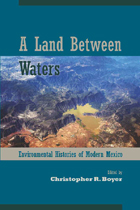 A Land Between Waters: Environmental Histories of Modern Mexico
Edited by Christopher R. Boyer
University of Arizona Press, 2012 Mexico is one of the most ecologically diverse nations on the planet, with landscapes that range from rainforests to deserts and from small villages to the continent’s largest metropolis. Yet historians are only beginning to understand how people’s use of the land, extraction of its resources, and attempts to conserve it have shaped both the landscape and its inhabitants.
A Land Between Waters explores the relationship between the people and the environment in Mexico. It heralds the arrival of environmental history as a major area of study within the field of Mexican history. This volume brings together a dozen original works of environmental history by some of the foremost experts in Mexican environmental history from both the United States and Mexico.
The contributions collected in this seminal volume explore a wide array of topics, from the era of independence to the present day. Together they examine how humans have used, abused, and attended to nature in Mexico over more than two hundred years. Written in clear, accessible prose, A Land Between Waters showcases the breadth of Mexican environmental history in a way that defines the key topics in the field and suggests avenues for subsequent work. Most importantly, it assesses the impacts of environmental changes that Mexico has faced in the past with an eye to informing national debates about the challenges that the nation will face in the future.
The Land Beyond: A Memoir
Jack Ives
University of Alaska Press, 2010 Geographer Jack Ives moved to Canada in 1954, and soon after he played an instrumental role in the establishment of the McGill Sub-Arctic Research Laboratory in central Labrador-Ungava. This fascinating account of his fifty-plus years living and working in the arctic is simultaneously a light-hearted, winning memoir and a call to action on the issues of environmental awareness and conservation that are inextricably intertwined with life in the north. Mixing personal impressions of key figures of the postwar scientific boom with the intellectual drama of field research, The Land Beyond is a memorable depiction of a life in science.
The Land beyond the Mists: Essays on Identity and Authority in Precolonial Congo and Rwanda
David Newbury
Ohio University Press, 2009 The horrific tragedies of Central Africa in the 1990s riveted the attention of the world. But these crises did not occur in a historical vacuum. By peering through the mists of the past, the case studies presented in The Land Beyond the Mists illustrate the significant advances to have taken place since decolonization in our understanding of the pre-colonial histories of Rwanda, Burundi, and eastern Congo. Based on both oral and written sources, these essays are important both for their methods—viewing history from the perspective of local actors—and for their conclusions, which seriously challenge colonial myths about the area.
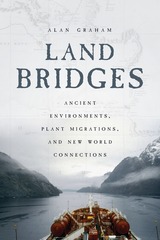 Land Bridges: Ancient Environments, Plant Migrations, and New World Connections
Alan Graham
University of Chicago Press, 2018 Land bridges are the causeways of biodiversity. When they form, organisms are introduced into a new patchwork of species and habitats, forever altering the ecosystems into which they flow; and when land bridges disappear or fracture, organisms are separated into reproductively isolated populations that can evolve independently. More than this, land bridges play a role in determining global climates through changes to moisture and heat transport and are also essential factors in the development of biogeographic patterns across geographically remote regions.
In this book, paleobotanist Alan Graham traces the formation and disruption of key New World land bridges and describes the biotic, climatic, and biogeographic ramifications of these land masses’ changing formations over time. Looking at five land bridges, he explores their present geographic setting and climate, modern vegetation, indigenous peoples (with special attention to their impact on past and present vegetation), and geologic history. From the great Panamanian isthmus to the boreal connections across the North Atlantic and North Pacific Oceans that allowed exchange of organisms between North America, Europe, and Asia, Graham’s sweeping, one-hundred-million-year history offers new insight into the forces that shaped the life and land of the New World.
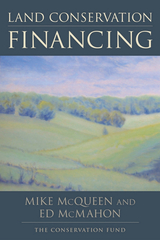 Land Conservation Financing
Mike McQueen and Ed McMahon; The Conservation Fund
Island Press, 2003 Written by two of the nation's leading experts on land conservation, Land Conservation Financing provides a comprehensive overview of successful land conservation programs -- how they were created, how they are funded, and what they've accomplished -- along with detailed case studies from across the United States. The authors present important new information on state-of-the-art conservation financing, showcasing programs in states that have become the nation's leaders in open-space protection: California, Colorado, Florida, Illinois, Maryland, Massachusetts, Minnesota, and New Jersey. They look at key local land protection efforts by examining model programs in DeKalb County, Georgia; Douglas County, Colorado; Jacksonville, Florida; Lake County, Illinois; Lancaster County, Pennsylvania; Marin County, California; the St. Louis metro area in Missouri and Illinois, and on Cape Cod, Massachusetts. The authors then examine how hundreds of communities have created hundreds of millions of dollars in funding by developing successful campaigns to win land conservation ballot measures. They offer case studies and pull together lessons learned as they lay out how to run a successful campaign. The authors also consider the role of private foundations, which have made immense contributions to land conservation over the past two decades. The book concludes with an examination of the emerging concept of green infrastructure -- a strategic approach to conservation that involves planning and managing a network of parks, natural areas, greenways, and working lands that can help support native species, maintain ecological processes, and contribute to the health and quality of life for America's people and its communities. Land Conservation Financing is an indispensable resource for land conservationists in the public and private sectors who are looking for a detailed, national portrait of the state of land conservation in America today.
Land Conservation Through Public/Private Partnerships
Edited by Eve Endicott; Foreword by Senator John H. Chafee
Island Press, 1993
Today, rarely is a significant land acquisition accomplished without at least one private- and one public-sector participant. This book provides a detailed, inside look at those public- private partnerships.
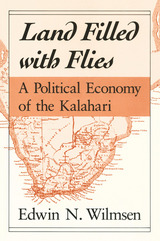 Land Filled with Flies: A Political Economy of the Kalahari
Edwin N. Wilmsen
University of Chicago Press, 1989 "The image of a pristine isolation has been almost as common in research on foragers as in the popular media. Land filled with Flies is a sustanined argument against such views. Wilmsen marshals an enormous quantity of historical, archival, archeological, ethnographic, and survey data on the Kalahari Zhu to show how far from the reality these images are, how they have their own historical provenance, how they have been analytically distorting, and how they have proven politically pernicious for living groups like the Zhu."—Pauline Peters, Science
"[A] major work. . . . Anthropologists will, and should, use Wilmsen's meticulously detailed study to revise their early lectures in the introductory course, and no future study of African 'foragers' should ignore it."—Parker Shipton, American Anthropologist
"An impressive book. . . . The reader need only read the first few pages to judge both the quality and ambitiousness of the work. . . . Essential reading."—David R. Penna, Africa Today
 Land for the People: The State and Agrarian Conflict in Indonesia
Anton Lucas
Ohio University Press, 2013 Half of Indonesia’s massive population still lives on farms, and for these tens of millions of people the revolutionary promise of land reform remains largely unfulfilled. The Basic Agrarian Law, enacted in the wake of the Indonesian revolution, was supposed to provide access to land and equitable returns for peasant farmers. But fifty years later, the law’s objectives of social justice have not been achieved. Land for the People provides a comprehensive look at land conflict and agrarian reform throughout Indonesia’s recent history, from the roots of land conflicts in the prerevolutionary period and the Sukarno and Suharto regimes, to the present day, in which democratization is creating new contexts for people’s claims to the land. Drawing on studies from across Indonesia’s diverse landscape, the contributors examine some of the most significant issues and events affecting land rights, including shifts in policy from the early postrevolutionary period to the New Order; the Land Administration Project that formed the core of land policy during the late New Order period; a long-running and representative dispute over a golf course in West Java that pitted numerous local farmers against the government and local elites; Suharto’s notorious “million hectare” project that resulted in loss of access to land and resources for numerous indigenous farmers in Kalimantan; and the struggle by Bandung’s urban poor to be treated equitably in the context of commercial land development. Together, these essays provide a critical resource for understanding one of Indonesia’s most pressing and most influential issues. Contributors: Afrizal, Dianto Bachriadi, Anton Lucas, John McCarthy, John Mansford Prior, Gustaaf Reerink, Carol Warren, and Gunawan Wiradi.
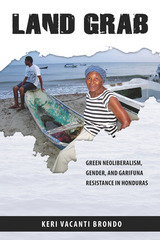 Land Grab: Green Neoliberalism, Gender, and Garifuna Resistance in Honduras
Keri Vacanti Brondo
University of Arizona Press, 2013 Land Grab is a rich ethnographic account of the relationship between identity politics, neoliberal development policy, and rights to resource management in Garifuna communities on the north coast of Honduras, before and after the 2009 coup d’état. The Garifuna are a people of African and Amerindian descent who were exiled to Honduras from the British colony of St. Vincent in 1797 and have long suffered from racial and cultural marginalization.
Employing approaches from feminist political ecology, critical race studies, and ethnic studies,Keri Vacanti Brondo illuminates three contemporary development paradoxes in Honduras: the recognition of the rights of indigenous people at the same time as Garifuna are being displaced in the name of development; the privileging of foreign research tourists in projects that promote ecotourism but result in restricting Garifuna from traditional livelihoods; and the contradictions in Garifuna land-rights claims based on native status when mestizos are reserving rights to resources as natives themselves.
Brondo’s book asks a larger question: can “freedom,” understood as well-being, be achieved under the structures of neoliberalism? Grounding this question in the context of Garifuna relationships to territorial control and self-determination, the author explores the “reregulation” of Garifuna land; “neoliberal conservation” strategies like ecotourism, research tourism, and “voluntourism;” the significant issue of who controls access to property and natural resources; and the rights of women, who have been harshly impacted by “development.” In her conclusion, Brondo points to hopeful signs in the emergence of transnational indigenous, environmental, and feminist organizations.
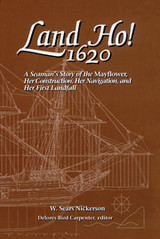 Land Ho! 1620: A Seaman's Story of the Mayflower, Her Construction, Her Navigation, and Her First Landfall
W. Sears Nickerson
Michigan State University Press, 1997 With an original 1931 press run of only seven hundred and fifty, surviving copies of Land Ho! 1620 are now either in archives or exist as valued collector's editions. Acclaimed by the Cape Cod Pilgrim Memorial Association in 1957 as "the most authentic, interesting, and best written book on the voyage of the Pilgrims and their lives," Nickerson's work is now available in this handsome paperback edition, complete with all original illustrations and maps. Nickerson scholar Delores Bird Carpenter updated all one hundred and seventy- nine annotations, checking them against original sources. In addition, she has prepared a new bibliography and an extensive, new introduction that places Land Ho! 1620 into its historical and historiographical context.
Divided into four parts, the first describes "the Voyage"; the second, told with the skill of a shipbuilder, describes "the Ship," which includes drawings of the deck plan, the passenger quarters, and the elevation and the sail plan. Also included in this section are discussions of the ship's speed, instruments, and personnel. The Third, "the backside of Cape Cod," addresses the problem of where the Mayflower first saw land, and its subsequent course. Nickerson concludes with "the Landfall and the Landing." Of great significance is his map, The Back Side of Cape Cod Today—1930 and Yesterday—1620.
 Land Hunger: Ohio and the Western Frontiers
Mansel G. Blackford
Ohio University Press, 2025 In Land Hunger, Mansel G. Blackford explores the central role of land use in the experiences of Native Americans, African Americans, and Euro Americans as the new nation expanded westward from Ohio to the Oregon Country. Blackford emphasizes how people adapted to new and changed environments and focuses on key themes related to environmental and frontier studies: the land-use interactions between Native Americans and outsiders, the influence of government policies, and the impact of earlier concepts about the ownership and use of land and water that continue to affect us today in the face of climate change. The first part of the book delves into Euro American and African American settlement in the Ohio Country during the late 1700s and early 1800s. Driven by “Ohio fever” and influenced by a blend of pragmatic, romantic, and capitalistic ideals, tens of thousands crossed the Appalachian Mountains to settle and farm in an unfamiliar land. It was in Ohio and the Midwest that many Americans developed their views on land and the environment, and where the new federal government devised methods for surveying and selling claimed lands. Subsequent chapters analyze how Ohioans and others attempted to apply Midwest-born ideas and practices in the Oregon Country and the Great Plains—regions with significantly different environments—with limited success. Land Hunger defines “frontiers” as zones of interaction between distinct groups of people, offering a broad interpretation of these contested spaces. The book explores how frontiers were depicted in fiction, where their portrayal helped establish their meaning and significance to incoming Americans. Blackford examines diaries, letters, and reminiscences, as well as a broad range of scholarly studies in this historical synthesis.
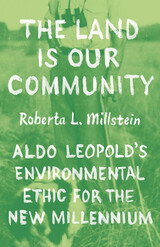 The Land Is Our Community: Aldo Leopold’s Environmental Ethic for the New Millennium
Roberta L. Millstein
University of Chicago Press, 2024 A contemporary defense of conservationist Aldo Leopold’s vision for human interaction with the environment.
Informed by his experiences as a hunter, forester, wildlife manager, ecologist, conservationist, and professor, Aldo Leopold developed a view he called the land ethic. In a classic essay, published posthumously in A Sand County Almanac, Leopold advocated for an expansion of our ethical obligations beyond the purely human to include what he variously termed the “land community” or the “biotic community”—communities of interdependent humans, nonhuman animals, plants, soils, and waters, understood collectively. This philosophy has been extremely influential in environmental ethics as well as conservation biology and related fields.
Using an approach grounded in environmental ethics and the history and philosophy of science, Roberta L. Millstein reexamines Leopold’s land ethic in light of contemporary ecology. Despite the enormous influence of the land ethic, it has sometimes been dismissed as either empirically out of date or ethically flawed. Millstein argues that these dismissals are based on problematic readings of Leopold’s ideas. In this book, she provides new interpretations of the central concepts underlying the land ethic: interdependence, land community, and land health. She also offers a fresh take on of his argument for extending our ethics to include land communities as well as Leopold-inspired guidelines for how the land ethic can steer conservation and restoration policy.
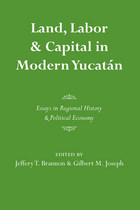 Land, Labor, and Capital in Modern Yucatan: Essays in Regional History and Political Economy
Jeffrey T. Brannon
University of Alabama Press, 1991 Owing to Yucatan’s relative isolation, many assume that the history and economy of the peninsula have evolved in a distinctive way, apart from the central government in Mexico City and insulated from world social and economic factors. The essays in this volume suggest that this has not been the case: the process of development in Yucatan has been linked firmly to national and global forces of change over the past two centuries. The essays are by U.S., Mexican, Canadian, and Belizean social scientists representing both well-established and younger scholars. The result is a perspective on Yucatan’s historical development that is at once international, interdisciplinary, and intergenerational. In this volume, all of the contributors are genuinely comfortable with the theories and approaches of several disciplines—economics, history, and anthropology, and sociology. All have used largely untapped, primary, archival sources, and the result is a fascinating offering of new information.
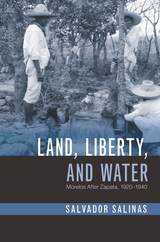 Land, Liberty, and Water: Morelos After Zapata, 1920–1940
Salvador Salinas
University of Arizona Press, 2018 Following the death of Emiliano Zapata in 1919, the Zapatistas continued to lead the struggle for land reform. Land, Liberty, and Water offers a political and environmental history of the aftermath of the 1910 Mexican Revolution by examining the outcomes of the insurgency in the state of Morelos.
Salvador Salinas takes readers inside the diverse pueblos of the former Zapatistas during the 1920s and 1930s and recounts the first statewide land reform carried out in postrevolutionary Mexico. Based on extensive archival research, he reveals how an alliance with the national government that began in 1920 stimulated the revival of rural communities after ten years of warfare and helped once-landless villagers reclaim Morelos’s valley soils, forested mountains, and abundant irrigation waters.
During the presidency of Plutarco Elías Calles (1924–1928), pueblos forged closer ties to the centralized government in Mexico City through a plethora of new national institutions, such as ejidos, forestry cooperatives, water juntas, credit societies, and primary schools. At the same time, the expansion of charcoal production in the Sierra de Ajusco and rice cultivation in the lowland valleys accelerated deforestation and intensified water conflicts.
Salinas recounts how the federal reforms embraced by the countryside aided the revival of the pueblos, and in return, villagers repeatedly came to the defense of an embattled national regime. Salinas gives readers interested in modern Mexico, the Zapatista revolution, and environmental history a deeply researched analysis of the outcomes of the nation’s most famous revolutionary insurgency.
 The Land Lies Open
Theodore Blegen
University of Minnesota Press, 1949
The Land Lies Open was first published in 1949. Minnesota Archive Editions uses digital technology to make long-unavailable books once again accessible, and are published unaltered from the original University of Minnesota Press editions.In The Land Lies Open some of the thousands of characters and incidents that made up the panorama of exploration and settlement in the Upper Mississippi Valley are recreated. Although the author is an outstanding professional historian, he writes with the narrative skill of a novelist; his history is never dry and remote, but always vividly alive.Here are the stories of a few of the many thousands who, when the land at last lay open, moved in to people it. From the rich mosaic of their lives Mr. Blegen has set down tales that stir the imagination. Some of the men Mr. Blegen writes about have famous names – Father Louis Hennepin, La Vérendrye, Hernando de Soto, Louis Jolliet – but most of them were jjust plain people unknown to present-day Americans. There are stories of adventurous sons of New France, England, and America who slowly, over a period of more than two centuries, opened to knowledge and usefulness the river channels leading into the great Midwest.The tales set down in The Land Lies Open vary from an exciting buffalo hunt to the story of immigrant farmers who came to the Midwest and patiently coaxed new kinds of fruit and grain to maturity. There are stories of bitter townsite rivalries, of a covered wagon heroine, of the Yankees who moved westward to leave the stamp of New England on the midwestern frontier, and of “pioneers of the second line” who developed new forms of social organization and action as these were needed.Once more, as in Grass Roots History, Mr. Blegen gives eloquent proof that history is not made by spectacular events or the experiences of a few exceptional people, but by all the small, everyday people whose names are unfamiliar.
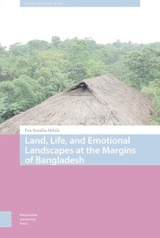 Land, Life, and Emotional Landscapes at the Margins of Bangladesh
Éva Rozália Hölzle
Amsterdam University Press, 2022 Drawing on two years of ethnographic research in the north-eastern borderlands of Bangladesh, this book focuses on the everyday struggles of indigenous farmers threatened with losing their land due to such state programmes as the realignment of the national border, ecotourism, social forestry and the establishment of a military cantonment. In implementing these programmes, state actors challenge farmers’ right to land, instituting spaces of violence in which multiple forms of marginalisation overlap and are reinforced. Mapping how farmers react to these challenges emotionally and practically, the book argues that these land conflicts serve as a starting point for existentially charged disputes in which the survival efforts of farmers clash with the political imaginations and practices of the nation-state. The analysis shows that losing land represents more than being deprived of a material asset: it is nothing less than the extinction of ways of life.
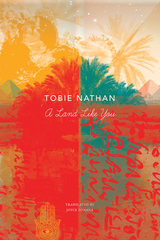 A Land Like You
Tobie Nathan
Seagull Books, 2020 A riveting and revealing tale of an Egypt caught between tradition and modernity, multiculturalism and nationalism, oppression and freedom.
Cairo 1925, Haret al-Yahud, the old Jewish Quarter. Esther, a beautiful young woman believed to be possessed by demons, longs to give birth after seven blissful years of marriage. Her husband, blind since childhood, does not object when, in her effort to conceive, she participates in Muslim zar rituals. Zohar, the novel’s narrator, comes into the world, but because his mother’s breasts are dry, he is nursed by a Muslim peasant—also believed to be possessed—who has just given birth to a girl, Masreya. Suckled at the same breasts and united by a rabbi’s amulet, the milk-twins will be consumed by a passionate, earth-shaking love.
Part fantastical fable, part realistic history, A Land Like You draws on ethno-psychiatrist Tobie Nathan’s deep knowledge of North African folk beliefs to create a glittering tapestry in which spirit possession and religious mysticism exist side by side with sober facts about the British occupation of Egypt and the rise of the Muslim Brotherhood and the Free Officers’ Movement. Historical figures such as Gamel Abdel Nasser, Anwar Sadat, and King Farouk mingle with Nathan’s fictional characters in this engaging story.
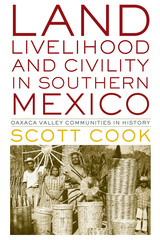 Land, Livelihood, and Civility in Southern Mexico: Oaxaca Valley Communities in History
By Scott Cook
University of Texas Press, 2014 In the Valley of Oaxaca in Mexico’s Southern Highland region, three facets of sociocultural life have been interconnected and interactive from colonial times to the present: first, community land as a space to live and work; second, a civil-religious system managed by reciprocity and market activity wherein obligations of citizenship, office, and festive sponsorships are met by expenditures of labor-time and money; and third, livelihood. In this book, noted Oaxacan scholar Scott Cook draws on thirty-five years of fieldwork (1965–1990) in the region to present a masterful ethnographic historical account of how nine communities in the Oaxaca Valley have striven to maintain land, livelihood, and civility in the face of transformational and cumulative change across five centuries. Drawing on an extensive database that he accumulated through participant observation, household surveys, interviews, case studies, and archival work in more than twenty Oaxacan communities, Cook documents and explains how peasant-artisan villagers in the Oaxaca Valley have endeavored over centuries to secure and/or defend land, worked and negotiated to subsist and earn a living, and striven to meet expectations and obligations of local citizenship. His findings identify elements and processes that operate across communities or distinguish some from others. They also underscore the fact that landholding is crucial for the sociocultural life of the valley. Without land for agriculture and resource extraction, occupational options are restricted, livelihood is precarious and contingent, and civility is jeopardized.
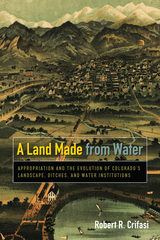 A Land Made from Water: Appropriation and the Evolution of Colorado's Landscape, Ditches, and Water Institutions
Robert R. Crifasi
University Press of Colorado, 2016 A Land Made from Water chronicles how the appropriation and development of water and riparian resources in Colorado changed the face of the Front Range—an area that was once a desert and is now an irrigated oasis suitable for the habitation and support of millions of people. This comprehensive history of human intervention in the Boulder Creek and Lefthand Creek valleys explores the complex interactions between environmental and historical factors to show how thoroughly the environment along the Front Range is a product of human influence. Author Robert Crifasi examines the events that took place in nineteenth-century Boulder County, Colorado, and set the stage for much of the water development that occurred throughout Colorado and the American West over the following century. Settlers planned and constructed ditches, irrigation systems, and reservoirs; initiated the seminal court decisions establishing the appropriation doctrine; and instigated war to wrest control of the region from the local Native American population. Additionally, Crifasi places these river valleys in the context of a continent-wide historical perspective.
By examining the complex interaction of people and the environment over time, A Land Made from Water links contemporary issues facing Front Range water users to the historical evolution of the current water management system and demonstrates the critical role people have played in creating ecosystems that are often presented to the public as “natural” or “native.” It will appeal to students, scholars, professionals, and general readers interested in water history, water management, water law, environmental management, political ecology, or local natural history.
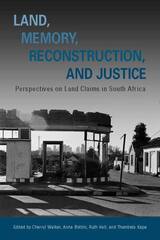 Land, Memory, Reconstruction, and Justice: Perspectives on Land Claims in South Africa
Cherryl Walker
Ohio University Press, 2010 Land is a significant and controversial topic in South Africa. Addressing the land claims of those dispossessed in the past has proved to be a demanding, multidimensional process. In many respects the land restitution program that was launched as part of the county’s transition to democracy in 1994 has failed to meet expectations, with ordinary citizens, policymakers, and analysts questioning not only its progress but also its outcomes and parameters. Land, Memory, Reconstruction, and Justice brings together a wealth of topical material and case studies by leading experts in the field who present a rich mix of perspectives from politics, sociology, geography, social anthropology, law, history, and agricultural economics. The collection addresses both the material and the symbolic dimensions of land claims, in rural and urban contexts, and explores the complex intersection of issues confronting the restitution program, from the promotion of livelihoods to questions of rights, identity, and transitional justice. A valuable contribution to the field of land and agrarian studies, both in South Africa and internationally, it is undoubtedly the most comprehensive treatment to date of South Africa’s postapartheid land claims process and will be essential reading for scholars and students of land reform for years to come.
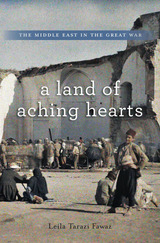 A Land of Aching Hearts: The Middle East in the Great War
Leila Tarazi Fawaz
Harvard University Press, 2014 The Great War transformed the Middle East, bringing to an end four hundred years of Ottoman rule in Arab lands while giving rise to the Middle East as we know it today. A century later, the experiences of ordinary men and women during those calamitous years have faded from memory. A Land of Aching Hearts traverses ethnic, class, and national borders to recover the personal stories of the civilians and soldiers who endured this cataclysmic event.
Among those who suffered were the people of Greater Syria—comprising modern Syria, Lebanon, Jordan, Israel, and Palestine—as well as the people of Turkey, Iraq, and Egypt. Beyond the shifting fortunes of the battlefield, the region was devastated by a British and French naval blockade made worse by Ottoman war measures. Famine, disease, inflation, and an influx of refugees were everyday realities. But the local populations were not passive victims. Fawaz chronicles the initiative and resilience of civilian émigrés, entrepreneurs, draft-dodgers, soldiers, villagers, and townsmen determined to survive the war as best they could. The right mix of ingenuity and practicality often meant the difference between life and death.
The war’s aftermath proved bitter for many survivors. Nationalist aspirations were quashed as Britain and France divided the Middle East along artificial borders that still cause resentment. The misery of the Great War, and a profound sense of huge sacrifices made in vain, would color people’s views of politics and the West for the century to come.
Land of Bears and Honey: A Natural History of East Texas
By Joe C. Truett and Daniel W. Lay
University of Texas Press, 1994 Winner, Ottis Lock Endowment Award for the best book on East Texas, East Texas Historical Association, 1985
Texas Literary Festival Award for Nonfiction (Southwestern Booksellers Association & Dallas Times Herald), 1985
Annual Publication Award, Texas Chapter of the Wildlife Society, 1984 The story of the land, wildlife, and ecology of East Texas.
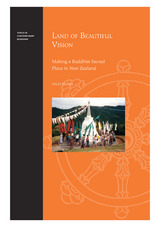 Land of Beautiful Vision: Making a Buddhist Sacred Place in New Zealand
Sally McAra
University of Hawaii Press, 2007 Land of Beautiful Vision is the first book-length ethnography to address the role of material culture in contemporary adaptations of Buddhism and the first to focus on convert Buddhists in New Zealand. Sally McAra takes as her subject a fascinating instance of an ongoing creative process whereby a global religion is made locally meaningful through the construction of a Buddhist sacred place. She uses an in-depth case study of a small religious structure, a stupa, in rural New Zealand to explore larger issues related to the contemporary surge in interest in Buddhism and religious globalization. Her research extends beyond the level of public discourse on Buddhism to investigate narratives of members of the Friends of the Western Buddhist Order (FWBO) about their relationship with the land, analyzing these and the FWBO’s transformative project through a thematic focus on key symbolic landmarks at their site, Sudarshanaloka.
In considering cross-cultural interactions resulting in syncretism or indigenization of alien religions, many anthropological studies concentrate on the unequal power relations between colonizing and colonized peoples. McAra extrapolates from this literature to look at a situation where the underlying power relations are quite different. She focuses on individuals in an organization whose members seek to appropriate knowledge from an "Eastern" tradition to remake their own society—one shaped by its unresolved colonizing past.
 Land of Big Rivers: French and Indian Illinois, 1699-1778
M. J. Morgan
Southern Illinois University Press, 2010 Drawing on research from a variety of academic fields, such as archaeology, history, botany, ecology, and physical science, M. J. Morgan explores the intersection of people and the environment in early eighteenth-century Illinois Country—a stretch of fecund, alluvial river plain along the Mississippi river. Arguing against the traditional narrative that describes Illinois as an untouched wilderness until the influx of American settlers, Morgan illustrates how the story began much earlier.
She focuses her study on early French and Indian communities, and later on the British, nestled within the tripartite environment of floodplain, riverine cliffs and bluffs, and open, upland till plain/prairie and examines the impact of these diverse groups of people on the ecological landscape. By placing human lives within the natural setting of the period—the abundant streams and creeks, the prairies, plants and wildlife—she traces the environmental change that unfolded across almost a century. She describes how it was a land in motion; how the occupying peoples used, extracted, and extirpated its resources while simultaneously introducing new species; and how the flux and flow of life mirrored the movement of the rivers. Morgan emphasizes the importance of population sequences, the relationship between the aboriginals and the Europeans, the shared use of resources, and the effects of each on the habitat.
Land of Big Rivers is a unique, many-themed account of the big-picture ecological change that occurred during the early history of the Illinois Country. It is the first book to consider the environmental aspects of the Illinois Indian experience and to reconsider the role of the French and British in environmental change in the mid-Mississippi Valley. It engagingly recreates presettlement Illinois with a remarkable interdisciplinary approach and provides new details that will encourage understanding of the interaction between physical geography and the plants, animals, and people in the Illinois Country. Furthermore, it exhibits the importance of looking at the past in the context of environmental transformation, which is especially relevant in light of today’s global climate change.
The Land Of Bliss
Cathy Song
University of Pittsburgh Press, 2001 Cathy Song’s fourth collection of poetry unveils glimpses of the elusive but ever-present power of wisdom and compassion. Recognizing that we have the ability to create our own misery as well as our own bliss, she finds the unexpected in broken lives, despair, and even seemingly joyous occasions. Song’s poems are often, like a handful of water, "cold and impossibly / clear, unlike anything / you’ve ever held before."
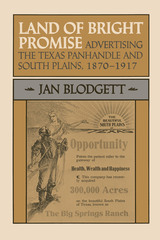 Land of Bright Promise: Advertising the Texas Panhandle and South Plains, 1870-1917
By Jan Blodgett
University of Texas Press, 1988 “It shall be the chosen land, perpetual sunshine shall kiss its trees and vines, and, being storied in luscious fruits and compressed into ruddy wine, will be sent to the four points of the compass to gladden the hearts of all mankind . . . They will breathe the pure and bracing air, bask in the healing sunshine, drink the invigorating wine, and eat the life prolonging fruit.” —from a brochure advertising the Staked Plains from the Missouri Pacific Railway Company, 1889 Land of Bright Promise is a fascinating exploration of the multitude of land promotions and types of advertising that attracted more than 175,000 settlers to the Panhandle–South Plains area of Texas from the late years of the nineteenth century to the early years of the twentieth. Shunned by settlers for decades because of its popular but forbidding image as a desert filled with desperados, savage Indians, and solitary ranchers, the region was seen as an agricultural and cultural wasteland. The territory, consequently, was among the last to be settled in the United States. But from 1890 to 1917, land companies and agents competed to attract new settlers to the plains. To this end, the combined efforts of local residents, ranchers and landowners, railroads, and professional real estate agents were utilized. Through brochures, lectures, articles, letters, fairs, and excursion trips, midwestern farmers were encouraged to find new homes on what was once feared as the “Great American Desert.” And successful indeed were these efforts: from 13,787 in 1890, the population grew to 193,371 in 1920, with a corresponding increase in the amount of farms and farm acreage. The book looks at the imagination, enthusiasm, and determination of land promoters as they approached their task, including their special advertisements and displays to show the potential of the area. Treating the important roles of the cattlemen, the railroads, the professional land companies, and local boosters, Land of Bright Promise also focuses on the intentions and expectations of the settlers themselves. Of special interest are the fifteen historical photographs and reproductions of promotional pieces from the era used to spur the land boom. What emerges is an engaging look at a critical period in the development of the Texas Panhandle and an overview of the shift from cattle to agriculture as the primary industry in the area.
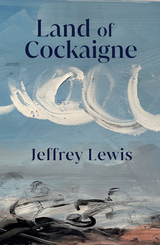 Land of Cockaigne
Jeffrey Lewis
Haus Publishing, 2023 A novel written as a sharp parable of American society, addressing love, purpose, discrimination, and poverty.
In Jeffrey Lewis’s novel, the Land of Cockaigne, once an old medieval peasants’ vision of a sensual paradise on earth, is reimagined as a plot on the coast of Maine. In efforts to assuage their grief over their son’s death and to make meaning of his life, Walter Rath and Catherine Gray build what they hope will be a version of paradise for a group of young men from the Bronx. As Walter and Catherine work to reinvent this land, formerly a summer resort, the surrounding town of Sneeds Harbor proves resistant. The residents’ well-meaning doubts lead to well-hidden threats, and the Raths’ marriage unravels as Walter loses faith in democracy. Meanwhile, the Bronx boys, who have only ever known the city, try to navigate this new land that is completely alien to them. Written as a parable of contemporary American society, Land of Cockaigne is by turns furious, funny, subversive, tragic, and horrifying. Faced with the question of what to do amid disastrous times, Walter Rath offers a clue: Love is an action, not a feeling. Once you go down this path of faith, there is much to be done.
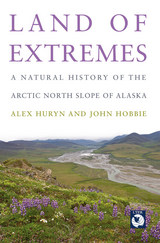 Land of Extremes: A Natural History of the Arctic North Slope of Alaska
Alex Huryn and John Hobbie
University of Alaska Press, 2012 This book is a comprehensive guide to the natural history of the North Slope, the only arctic tundra in the United States. The first section provides detailed information on climate, geology, landforms, and ecology. The second provides a guide to the identification and natural history of the common animals and plants and a primer on the human prehistory of the region from the Pleistocene through the mid-twentieth century. The appendix provides the framework for a tour of the natural history features along the Dalton Highway, a road connecting the crest of the Brooks Range with Prudhoe Bay and the Arctic Ocean, and includes mile markers where travelers may safely pull off to view geologic formations, plants, birds, mammals, and fish. Featuring hundreds of illustrations that support the clear, authoritative text, Land of Extremes reveals the arctic tundra as an ecosystem teeming with life.
 Land of Famished Beings: West Papuan Theories of Hunger
Sophie Chao
Duke University Press, 2025 In Land of Famished Beings, Sophie Chao examines how Indigenous Marind communities understand and theorize hunger in lowland West Papua, a place where industrial plantation expansion and settler-colonial violence are radically reconfiguring ecologies, socialities, and identities. Instead of seeing hunger as an individual, biophysical state defined purely in nutritional, quantitative, or human terms, Chao investigates how hunger traverses variably situated humans, animals, plants, institutions, infrastructures, spirits, and sorcerers. When approached through the lens of Indigenous Marind philosophies, practices, and protocols, hunger reveals itself to be a multiple, more-than-human, and morally imbued modality of being—one whose effects are no less culturally crafted or contested than food and eating. In centering Indigenous feminist theories of hunger, Chao offers new ways of thinking about the relationship between the environment, food, and nourishment in an age of self-consuming capitalist growth. She also considers how Indigenous theories invite anthropologists to reimagine the ethics and politics of ethnographic writing and the responsibilities, hesitations, and compromises that shape anthropological commitments in and beyond the field.
Land of Fire: Poems
Mario Chard
Tupelo Press, 2018 The poems in Mario Chard’s first collection follow three entangled strands — a contemporary immigrant story, echoes of the Fall in Paradise Lost, and meditations on fatherhood in the shadow of Abraham’s command to sacrifice a son. The poet speaks from the American hemisphere, immersed in histories of loss from long before Magellan first glimpsed his tierra del fuego. This Land of Fire is close at hand though we try and insist upon its distance, like the sun, like Milton’s Pandemonium, like the wars outside our borders or within.
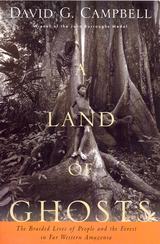 A Land of Ghosts: The Braided Lives of People and the Forest in Far Western Amazonia
Campbell, David G
Rutgers University Press, 2007 For thirty years David G. Campbell has explored the Amazon, an enchanting terrain of forest and river that is home to the greatest diversity of plants and animals to have ever existed, anywhere at any time, during the four-billion-year history of life on Earth. With great artistic flair, Campbell describes a journey up the Rio Moa, a remote tributary of the Amazon River, 2,800 miles from its mouth. Here he joins three old friends: Arito, a caiman hunter turned paleontologist; Tarzan, a street urchin brought up in a bordello; and Pimentel, a master canoe pilot. They travel together deep into the rainforest and set up camp in order to survey every woody plant on a two-hectare plot of land with about as many tree species as in all of North America. Campbell introduces us to two remarkable women, Dona Cabocla, a widow who raised six children on that lonely frontier, and Dona Ausira, a Nokini Native American who is the last speaker of her tribe's ages-old language. These pioneers live in a land whose original inhabitants were wiped out by centuries of disease, slavery, and genocide, taking their traditions and languages with them. He explores the intimate relationship between the extinction of native language and the extirpation of biological diversity. "It's hard for a people to love a place that is not defined in words and thus cannot be understood. And it's easy to give away something for which there are no words, something you never knew existed." In elegant prose that enchants and entrances, Campbell has written an elegy for the Amazon forest and its peoples-for what has become a land of ghosts.
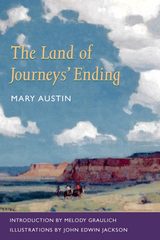 The Land of Journeys' Ending
Mary Austin
University of Illinois Press, 2003
When The Land of Journeys' Ending was first published in 1924, The Literary Reviewwarned, "This book is treacherous, waiting to overwhelm you with its abundant poetry." In it, successful New York author Mary Austin describes the epic journey she undertook in 1923, when left her East Coast home at the age of fifty-five to travel through the southwestern United States, the area where she lived as a child and where she would later retire.
The journey the book describes is a double one. Austin describes her transition from the cosmopolitan North East to the arid and largely unfamiliar land between the Colorado River and the Rio Grande. In telling her own story, Austin also tells the story of those who journeyed there before her-–Native American tribes, Spanish conquistadores, miners, adventurers, and California-bound migrants. The result is both an homage to the magnificence of the desert, mountains, rivers, canyons, plants, and animals of the Southwest and a history of the waves of people who inhabited the region.
Part memoir, part travel narrative, part historical investigation, and part ecological study, The Land of Journeys' Ending is a moving account of a woman coming full circle, finding solace in the broad landscape of her youth.
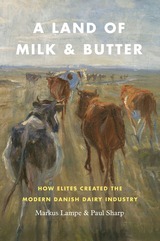 A Land of Milk and Butter: How Elites Created the Modern Danish Dairy Industry
Markus Lampe and Paul Sharp
University of Chicago Press, 2018 How and why does Denmark have one of the richest, most equal, and happiest societies in the world today? Historians have often pointed to developments from the late nineteenth century, when small peasant farmers worked together through agricultural cooperatives, whose exports of butter and bacon rapidly gained a strong foothold on the British market.
This book presents a radical retelling of this story, placing (largely German-speaking) landed elites—rather than the Danish peasantry—at center stage. After acquiring estates in Denmark, these elites imported and adapted new practices from outside the kingdom, thus embarking on an ambitious program of agricultural reform and sparking a chain of events that eventually led to the emergence of Denmark’s famous peasant cooperatives in 1882. A Land of Milk and Butter presents a new interpretation of the origin of these cooperatives with striking implications for developing countries today.
Land of Milk and Money: A Novel
Anthony Barcellos
Tagus Press, 2012 Land of Milk and Money tells the story of the Francisco family, Portuguese immigrants who build a prosperous California dairy farm. With their growing success, plans to return to the Old Country fall by the wayside, and the legacy of the older generation becomes a source of contention among descendants competing to inherit herds of cattle and tracts of farmland. As matriarch, Teresa had devoted her life to keeping the peace in her big family. But when she dies long-simmering resentments and feuds burst into the open—and into the courtroom. Teresa, however, had seen it all coming, and her will contains a few surprises.
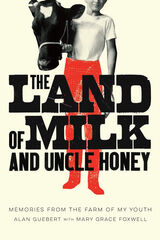 The Land of Milk and Uncle Honey: Memories from the Farm of My Youth
Alan Guebert with Mary Grace Foxwell
University of Illinois Press, 2015 "The river was in God's hands, the cows in ours." So passed the days on Indian Farm, a dairy operation on 700 acres of rich Illinois bottomland. In this collection, Alan Guebert and his daughter-editor Mary Grace Foxwell recall Guebert's years on the land working as part of that all-consuming collaborative effort known as the family farm. Here are Guebert's tireless parents, measuring the year not in months but in seasons for sewing, haying, and doing the books; Jackie the farmhand, needing ninety minutes to do sixty minutes' work and cussing the entire time; Hoard the dairyman, sore fingers wrapped in electrician's tape, sharing wine and the prettiest Christmas tree ever; and the unflappable Uncle Honey, spreading mayhem via mistreated machinery, flipped wagons, and the careless union of diesel fuel and fire. Guebert's heartfelt and humorous reminiscences depict the hard labor and simple pleasures to be found in ennobling work, and show that in life, as in farming, Uncle Honey had it right with his succinct philosophy for overcoming adversity: "the secret's not to stop." https://www.youtube.com/watch?v=DooGQqUlXI4&index=1&list=FLPxtuez-lmHxi5zpooYEnBg
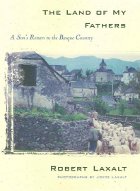 The Land of My Fathers: A Son's Return to the Basque Country
Robert Laxalt
University of Nevada Press, 2024 In 1960, renowned Nevada writer Robert Laxalt moved himself and his family to a small Basque village in the French Pyrenees. The son of Basque emigrants, Laxalt wanted to learn as much as he could about the ancient and mysterious people from which he was descended and about the country from which his parents came. Thanks to his Basque surname and a wide network of family connections, Laxalt was able to penetrate the traditional reserve of the Basques in a way that outsiders rarely can. In the process, he gained rare insight into the nature of the Basques and the isolated, beautiful mountain world where they have lived for uncounted centuries. Based on Laxalt’s personal journals of this and a later sojourn in 1965, The Land of My Fathers is a moving record of a people and their homeland. Through Laxalt’s perceptive eyes and his wife Joyce’s photographs, we observe the Basques’ market days and festivals, join their dove hunts and harvests, share their humor and history, their deep sense of nationalism, their abiding pride in their culture and their homes, and discover the profound sources of the Basques’ strength and their endurance as a people. Photography by Joyce Laxalt.
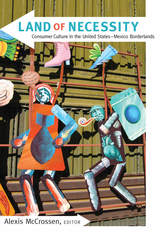 Land of Necessity: Consumer Culture in the United States–Mexico Borderlands
Alexis McCrossen, ed.
Duke University Press, 2009 Published in cooperation with the William P. Clements Center for Southwest Studies, Southern Methodist University. In Land of Necessity, historians and anthropologists unravel the interplay of the national and transnational and of scarcity and abundance in the region split by the 1,969-mile boundary line dividing Mexico and the United States. This richly illustrated volume, with more than 100 images including maps, photographs, and advertisements, explores the convergence of broad demographic, economic, political, cultural, and transnational developments resulting in various forms of consumer culture in the borderlands. Though its importance is uncontestable, the role of necessity in consumer culture has rarely been explored. Indeed, it has been argued that where necessity reigns, consumer culture is anemic. This volume demonstrates otherwise. In doing so, it sheds new light on the history of the U.S.-Mexico borderlands, while also opening up similar terrain for scholarly inquiry into consumer culture. The volume opens with two chapters that detail the historical trajectories of consumer culture and the borderlands. In the subsequent chapters, contributors take up subjects including smuggling, tourist districts and resorts, purchasing power, and living standards. Others address home décor, housing, urban development, and commercial real estate, while still others consider the circulation of cinematic images, contraband, used cars, and clothing. Several contributors discuss the movement of people across borders, within cities, and in retail spaces. In the two afterwords, scholars reflect on the U.S.-Mexico borderlands as a particular site of trade in labor, land, leisure, and commodities, while also musing about consumer culture as a place of complex political and economic negotiations. Through its focus on the borderlands, this volume provides valuable insight into the historical and contemporary aspects of the big “isms” shaping modern life: capitalism, nationalism, transnationalism, globalism, and, without a doubt, consumerism. Contributors. Josef Barton, Peter S. Cahn, Howard Campbell, Lawrence Culver, Amy S. Greenberg, Josiah McC. Heyman, Sarah Hill, Alexis McCrossen, Robert Perez, Laura Isabel Serna, Rachel St. John, Mauricio Tenorio-Trillo, Evan R. Ward
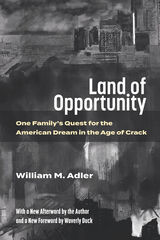 Land of Opportunity: One Family's Quest for the American Dream in the Age of Crack
William M. Adler
University of Michigan Press, 2021 Part true crime, part work of urban sociology, Land of Opportunity is a meticulously researched account of the rise and fall of the Chambers brothers, who ran a multi-million-dollar crack cocaine operation in Detroit in the 1980s. Descended from Arkansas sharecroppers, BJ, Larry, and Willie Chambers moved to Detroit seeking economic opportunity, and built a successful drug empire by applying strict business principles to their trade; their business grossed an estimated $55 million annually until the brothers were sent to prison in 1989. Reading the Chambers brothers in the context of the fall of the Detroit auto-industry and its impact on the city’s economy and residents, Land of Opportunity demonstrates how for the Chambers brothers, crack dealing was a rational career choice; and through the Chambers brothers’ story, Adler provides bottom-up history of late Second Great Migration, deindustrialization, the War on Drugs, and crack era in both Detroit and the United States.
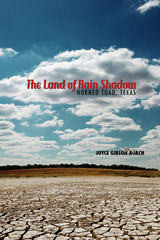 The Land of Rain Shadow: Horned Toad, Texas
Joyce Gibson Roach
Texas Tech University Press, 2015 They came and scattered themselves about the plains and prairies of West Texas like seeds thrown into the constant winds. In clusters or in singles they dug in. Depending on rainfall, they flourished or failed.
Maybe the journeyers arrived in the springtime of a good year and saw the beauty of the place, expecting it to last. Maybe it did last for a season or so before a bad dry spell set in. Maybe it was several years before a real drought appeared, which they foolishly thought would pass. Regardless, there were soon small pockets of people becoming inseparable from the land. Some were made sad, mean, cantankerous, negative; some quiet, kind, patient; but all shared stubbornness, informed by the very land itself.
In these eight stories that share the same setting across time, Joyce Gibson Roach writes of the place that sparked her treasured West Texas sensibility. Her fictive Horned Toad calls to stand and speak itself into existence—to live again in words. The characters are all familiar West Texas–types speaking in the tongues of dry places. All reflect their moments in time, proving that human nature does not change in this land of rain shadow.
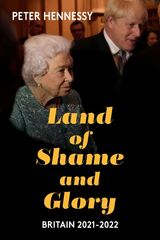 Land of Shame and Glory: Britain 2021–22
Peter Hennessy
Haus Publishing, 2023 A compelling account of the transformative changes Britain is facing today, exploring how we can build a post-COVID society.
2021 and 2022 were two of the most turbulent and disruptive years experienced by Britain in peacetime. Land of Shame and Glory: Britain 2021–22 addresses a series of unprecedented challenges that laid bare the fragility of Britain and the Union during this time. Beginning with the chaotic Fall of Kabul, which exposed Britain's military dependence on the United States, through the prolonged, unsatisfying removal of a prime minister—and the economically catastrophic, short-lived tenure of his successor—that further exposed the vulnerabilities of an unwritten constitution; to the country sweltering in record-breaking temperatures amid dire warnings of climate catastrophe; and finally, to the death of a much-loved monarch, who was a point of consistency during decades of tremendous social and technological change. Peter Hennessy considers the continuities and upheavals of the last seventy years, asking whether there can be said to have been a second Elizabethan Age and lamenting that the post-war period came to its close amid such upheaval and loss.
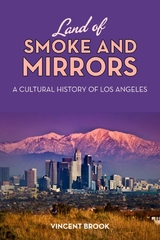 Land of Smoke and Mirrors: A Cultural History of Los Angeles
Brook, Vincent
Rutgers University Press, 2013 Unlike the more forthrightly mythic origins of other urban centers—think Rome via Romulus and Remus or Mexico City via the god Huitzilopochtli—Los Angeles emerged from a smoke-and-mirrors process that is simultaneously literal and figurative, real and imagined, material and metaphorical, physical and textual. Through penetrating analysis and personal engagement, Vincent Brook uncovers the many portraits of this ever-enticing, ever-ambivalent, and increasingly multicultural megalopolis. Divided into sections that probe Los Angeles’s checkered history and reflect on Hollywood’s own self-reflections, the book shows how the city, despite considerable remaining challenges, is finally blowing away some of the smoke of its not always proud past and rhetorically adjusting its rear-view mirrors. Part I is a review of the city’s history through the early 1900s, focusing on the seminal 1884 novel Ramona and its immediate effect, but also exploring its ongoing impact through interviews with present-day Tongva Indians, attendance at the 88th annual Ramona pageant, and analysis of its feature film adaptations. Brook deals with Hollywood as geographical site, film production center, and frame of mind in Part II. He charts the events leading up to Hollywood’s emergence as the world’s movie capital and explores subsequent developments of the film industry from its golden age through the so-called New Hollywood, citing such self-reflexive films as Sunset Blvd.,Singin’ in the Rain, and The Truman Show. Part III considers LA noir, a subset of film noir that emerged alongside the classical noir cycle in the 1940s and 1950s and continues today. The city’s status as a privileged noir site is analyzed in relation to its history and through discussions of such key LA noir novels and films as Double Indemnity, Chinatown, and Crash. In Part IV, Brook examines multicultural Los Angeles. Using media texts as signposts, he maps the history and contemporary situation of the city’s major ethno-racial and other minority groups, looking at such films as Mi Familia (Latinos), Boyz N the Hood (African Americans), Charlotte Sometimes (Asians), Falling Down (Whites), and The Kids Are All Right (LGBT).
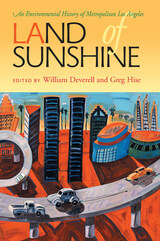 Land of Sunshine: An Environmental History of Metropolitan Los Angeles
William Deverell
University of Pittsburgh Press, 2006
Most people equate Los Angeles with smog, sprawl, forty suburbs in search of a city-the great "what-not-to-do" of twentieth-century city building. But there's much more to LA's story than this shallow stereotype. History shows that Los Angeles was intensely, ubiquitously planned. The consequences of that planning-the environmental history of urbanism--is one place to turn for the more complex lessons LA has to offer.
Working forward from ancient times and ancient ecologies to the very recent past, Land of Sunshine is a fascinating exploration of the environmental history of greater Los Angeles. Rather than rehearsing a litany of errors or insults against nature, rather than decrying the lost opportunities of "roads not taken," these essays, by nineteen leading geologists, ecologists, and historians, instead consider the changing dynamics both of the city and of nature.
In the nineteenth century, for example, "density" was considered an evil, and reformers struggled mightily to move the working poor out to areas where better sanitation and flowers and parks "made life seem worth the living."
We now call that vision "sprawl," and we struggle just as much to bring middle-class people back into the core of American cities. There's nothing natural, or inevitable, about such turns of events. It's only by paying very close attention to the ways metropolitan nature has been constructed and construed that meaningful lessons can be drawn. History matters.
So here are the plants and animals of the Los Angeles basin, its rivers and watersheds. Here are the landscapes of fact and fantasy, the historical actors, events, and circumstances that have proved transformative over and over again. The result is a nuanced and rich portrait of Los Angeles that will serve planners, communities, and environmentalists as they look to the past for clues, if not blueprints, for enhancing the quality and viability of cities.
 Land of the Dacotahs
Bruce Nelson
University of Minnesota Press, 1946 Land of the Dacotahs was first published in 1946. Minnesota Archive Editions uses digital technology to make long-unavailable books once again accessible, and are published unaltered from the original University of Minnesota Press editions.A new story about the American West, Land of the Dacotahs tells the dramatic history of the Upper Missouri Valley from the days of the early French explorers to today’s plan for harnessing the Missouri, America’s most willful river.Here is the land of the Sioux Indians, of Pte the buffalo, of the amazing Black Hills, of the great plains which became the tragic Dust Bowl. Here is this land’s vast natural wealth, its violent extremes of weather, its man-wrought havoc and man-made fortunes – in stories of keelboatmen and Indian fighters, of cattle barons and rustlers, of Scandinavian immigrants and homesteaders, of the steamboats and the railroads, of the Nonpartisan League, and of the fights over the MVA.Bruce Nelson, a young North Dakota newspaperman, writes with a keen sense of historical pattern and a flair for the dramatic. He has made exciting use of little-known Indian lore and pioneer fold tales. Skillfully interwoven with the facts are diverting legends, with a sly bit of debunking besides, about such colorful figures as Hugh Glass, the exotic Marquis de Mores, Teddy Roosevelt, George Armstrong Custer, Sitting Bull, Wild Bill Hickok, Calamity Jane, and many others.The author was awarded a University of Minnesota Fellowship in Regional Writing to assist him in this work.
The Land of the Dead Is Open for Business
Jacob Strautmann
Four Way Books, 2020 The Land of the Dead Is Open for Business is an extended elegy for Jacob Strautmann’s home state of West Virginia and its generations of inhabitants sold out by the false promise of the American Dream. Throughout the book, voices rise up from the page to describe a landscape eroded and plundered by runaway capitalism—its mountain tops leveled by the extractive industries, its waters polluted by runoff from mines—and the fallout from that waste. Those who remain are consigned to life in a ravaged land denuded of nature where birds die and “Sheep / birth limp two-headed things and some / that speak like men if they speak at all.”
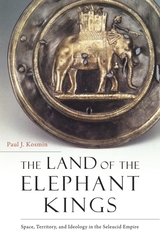 The Land of the Elephant Kings: Space, Territory, and Ideology in the Seleucid Empire
Paul J. Kosmin
Harvard University Press, 2014 A Choice Outstanding Academic Title of the Year
The Seleucid Empire (311–64 BCE) was unlike anything the ancient Mediterranean and Near Eastern worlds had seen. Stretching from present-day Bulgaria to Tajikistan—the bulk of Alexander the Great’s Asian conquests—the kingdom encompassed a territory of remarkable ethnic, religious, and linguistic diversity; yet it did not include Macedonia, the ancestral homeland of the dynasty. The Land of the Elephant Kings investigates how the Seleucid kings, ruling over lands to which they had no historic claim, attempted to transform this territory into a coherent and meaningful space.
“This engaging book appeals to the specialist and non-specialist alike. Kosmin has successfully brought together a number of disparate fields in a new and creative way that will cause a reevaluation of how the Seleucids have traditionally been studied.”
—Jeffrey D. Lerner, American Historical Review
“It is a useful and bright introduction to Seleucid ideology, history, and position in the ancient world.”
—Jan P. Stronk, American Journal of Archaeology
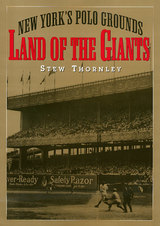 Land of the Giants: New York's Polo Grounds
Stewart Thornley
Temple University Press, 2000 More than thirty years after its demolition, the Polo Grounds -- like some other urban neighborhood parks such as Ebbets Field, Yankee Stadium, Fenway Park, and Wrigley Field -- still holds a place in the hearts of baseball fans.
The Polo Grounds was the home of the New York Giants from John McGraw and Christy Mathewson to Carl Hubbell and Mel Ott to Willie Mays and Leo Durocher. It was also home to the Yankees when Babe Ruth's home run production was soaring (which led to "the House that Ruth built") and home to the Mets in their painful early years.
From "Merkle's Boner," which cost the New York Giants a pennant, to Bobby Thomson's homer, which won them one, Stew Thornley retells the legendary events of the park and its legendary personalities. He reveals little-known facts too:
When the championship Giants and Yankees played in the 1921 and 1922 World Series, it
wasn't a "subway series," because the two teams shared the same ballpark.
The team Bays was playing for when he hit his firstd home run in the Polo Grounds was
not the Giants, but the Birmingham Black Barons. The Polo Grounds was also the site for
the Negro World Series games in 1946 and 1947.
Fans cherish not only the historic moments and team traditions of these stadiums, but treasure their physical peculiarities. Like the "Green Monster" at Fenway Park, the unusual horseshoe shape of the Polo Grounds made the park a special place to play. Stew Thornley analyzes the effect of the very short porches along the foul lines and of a cavernous center field on home run production and hitting in general.
Baseball wasn't the only sport played in the Polo Grounds. The footbal Giants played here from 1925 to 1955, but the stadium was better known for some of the great college games, including the 1924 Army-Notre Dame game in which the "Four Horsemen" of Notre Dame were christened. Numerous boxing title bouts were held at the Polo Grounds, and it also hosted tennis, rodeo, midget auto racing, outdoor opera, ice skating, and religious rallies.
 Land of the Millrats
Richard M. Dorson
Harvard University Press, 1981 Most of Richard Dorson’s thirty years as folklorist have been spent collecting tales and legends in the remote backcountry, far from the centers of population. For this book he extended his search for folk traditions to one of the most heavily industrialized sections of the United States. Can folklore be found, he wondered, in the Calumet Region of northwest Indiana? Does it exist among the steelworkers, ethnic groups, and blacks in Gary, Whiting, East Chicago, and Hammond?
In his usual entertaining style, Dorson shows that a rich and varied folklore exists in the region. Although it differs from that of rural people, it is equally vital. Much of this urban lore finds expression in conversational anecdotes and stories that deal with pressing issues: the flight from the inner city, crime in the streets, working conditions in the steel mills, the maintenance of ethnic identity, the place of blacks in a predominantly white society. The folklore reveals strongly held attitudes such as the loathing of industrial work, resistance to assimilation, and black adoption of middle-class-white values.
Millworkers and mill executives, housewives, ethnic performers, storekeepers, and preachers tell their stories about the region. The concerns that occupy them affect city dwellers throughout the United States. Land of the Millrats, though it depicts a special place, speaks for much of America.
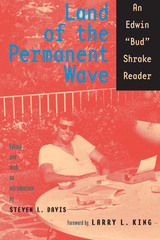 Land of the Permanent Wave: An Edwin "Bud" Shrake Reader
By Bud Shrake
University of Texas Press, 2008 Edwin "Bud" Shrake is one of the most intriguing literary talents to emerge from Texas. He has written vividly in fiction and nonfiction about everything from the early days of the Texas Republic to the making of the atomic bomb. His real gift has been to capture the Texas Zeitgeist. Legendary Harper's Magazine editor Willie Morris called Shrake's essay "Land of the Permanent Wave" one of the two best pieces Morris ever published during his tenure at the magazine. High praise, indeed, when one considers that Norman Mailer and Seymour Hersh were just two of the luminaries featured at Harper's during Morris's reign. This anthology is the first to present and explore Shrake's writing completely, including his journalism, fiction, and film work, both published and previously unpublished. The collection makes innovative use of his personal papers and letters to explore the connections between his journalism and his novels, between his life and his art. An exceptional behind-the-scenes look at his life, Land of the Permanent Wave reveals and reveres the life and calling of a writer whose legacy continues to influence and engage readers and writers nearly fifty years into his career.
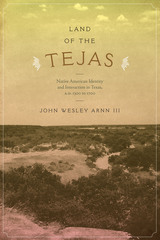 Land of the Tejas: Native American Identity and Interaction in Texas, A.D. 1300 to 1700
By John Wesley Arnn III
University of Texas Press, 2012 Combining archaeological, historical, ethnographic, and environmental data, Land of the Tejas represents a sweeping, interdisciplinary look at Texas during the late prehistoric and early historic periods. Through this revolutionary approach, John Wesley Arnn reconstructs Native identity and social structures among both mobile foragers and sedentary agriculturalists. Providing a new methodology for studying such populations, Arnn describes a complex, vast, exotic region marked by sociocultural and geographical complexity, tracing numerous distinct peoples over multiple centuries. Drawing heavily on a detailed analysis of Toyah (a Late Prehistoric II material culture), as well as early European documentary records, an investigation of the regional environment, and comparisons of these data with similar regions around the world, Land of the Tejas examines a full scope of previously overlooked details. From the enigmatic Jumano Indian leader Juan Sabata to Spanish friar Casanas's 1691 account of the vast Native American Tejas alliance, Arnn's study shines new light on Texas's poorly understood past and debunks long-held misconceptions of prehistory and history while proposing a provocative new approach to the process by which we attempt to reconstruct the history of humanity.
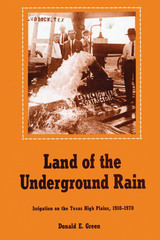 Land of the Underground Rain: Irrigation on the Texas High Plains, 1910-1970
By Donald E. Green
University of Texas Press, 1973 The scarcity of surface water which has so marked the Great Plains is even more characteristic of its subdivision, the Texas High Plains. Settlers on the plateau were forced to use pump technology to tap the vast ground water resources—the underground rain—beneath its flat surface. The evolution from windmills to the modern high-speed irrigation pumps took place over several decades. Three phases characterized the movement toward irrigation. In the period from 1910 to 1920, large-volume pumping plants first appeared in the region, but, due to national and regional circumstances, these premature efforts were largely abortive. The second phase began as a response to the drouth of the Dust Bowl and continued into the 1950s. By 1959, irrigation had become an important aspect of the flourishing High Plains economy. The decade of the 1960s was characterized chiefly by a growing alarm over the declining ground water table caused by massive pumping, and by investigations of other water sources. Land of the Underground Rain is a study in human use and threatened exhaustion of the High Plains' most valuable natural resource. Ground water was so plentiful that settlers believed it flowed inexhaustibly from some faraway place or mysteriously from a giant underground river. Whatever the source, they believed that it was being constantly replenished, and until the 1950s they generally opposed effective conservation of ground water. A growing number of weak and dry wells then made it apparent that Plains residents were "mining" an exhaustible resource. The Texas High Plains region has been far more successful in exploiting its resource than in conserving it. The very success of its pump technology has produced its environmental crisis. The problem brought about by the threatened exhaustion of this resource still awaits a solution. This study is the first comprehensive history of irrigation on the Texas High Plains, and it is the first comprehensive treatment of the development of twentieth-century pump irrigation in any area of the United States.
 Land of Their Choice: The Immigrants Write Home
Theodore C. Blegen, Editor
University of Minnesota Press, 1955 Land of Their Choice was first published in 1955. Minnesota Archive Editions uses digital technology to make long-unavailable books once again accessible, and are published unaltered from the original University of Minnesota Press editions. This collection of "American letters" that immigrants wrote to friends and relatives in the lands they had left tells a little-known human story that is part of the larger saga of America. It constitutes a kind of composite diary of everyday people at the grass roots of American life. The letters published here, written by Norwegian immigrants in the middle of the nineteenth century, are truly representative of a great body of historical material - literally millions of such letters that immigrants of every nationality wrote to the people back home. Describing their journeys, the new country, the problems and pleasures of daily life, the letters afford new insight into the American past and at the same time reflect the image of America that was projected into the minds of Europeans in an era when millions were crossing the seas and moving west. The letters were written from many different parts of the United States. Many relate the experiences of settlers in the Middle West, particularly in Illinois, Wisconsin, Iowa, and Minnesota. But there are also accounts of pioneer life in Texas and as far away from the Atlantic crossing as California. The story of Oleana, the ill-fated Utopian project established in Pennsylvania by the famous Norwegian violinist, Ole Bull, is revealed in a collection of letters written by settlers in this project. An English translation of the amusing ballad of Oleana adds verve to this section. Another fascinating portion of the volume is devoted to first-hand accounts of the transatlantic gold rush that drew Norwegians directly by ship from their native land to California in the 1850's. There are some letters written by leaders in Norwegian-American history, such as Johann R. Reiersen, who was a well-known newspaper editor in Christianssand, Norway, before he migrated to America, and the Rev. J.W. Dietrichson who sought to establish the Church of Norway on American soil and whose letters, now translated into English for the first time, relate his experiences in Wisconsin.
 The Land of Too Much: American Abundance and the Paradox of Poverty
Monica Prasad
Harvard University Press, 2012 The Land of Too Much presents a simple but powerful hypothesis that addresses three questions: Why does the United States have more poverty than any other developed country? Why did it experience an attack on state intervention starting in the 1980s, known today as the neoliberal revolution? And why did it recently suffer the greatest economic meltdown in seventy-five years?
Although the United States is often considered a liberal, laissez-faire state, Monica Prasad marshals convincing evidence to the contrary. Indeed, she argues that a strong tradition of government intervention undermined the development of a European-style welfare state. The demand-side theory of comparative political economy she develops here explains how and why this happened. Her argument begins in the late nineteenth century, when America’s explosive economic growth overwhelmed world markets, causing price declines everywhere. While European countries adopted protectionist policies in response, in the United States lower prices spurred an agrarian movement that rearranged the political landscape. The federal government instituted progressive taxation and a series of strict financial regulations that ironically resulted in more freely available credit. As European countries developed growth models focused on investment and exports, the United States developed a growth model based on consumption.
These large-scale interventions led to economic growth that met citizen needs through private credit rather than through social welfare policies. Among the outcomes have been higher poverty, a backlash against taxation and regulation, and a housing bubble fueled by “mortgage Keynesianism.” This book will launch a thousand debates.
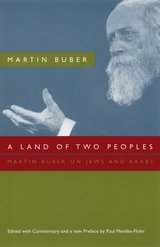 A Land of Two Peoples: Martin Buber on Jews and Arabs
Martin Buber
University of Chicago Press, 2005 Theologian, philosopher, and political radical, Martin Buber (1878–1965) was actively committed to a fundamental economic and political reconstruction of society as well as the pursuit of international peace. In his voluminous writings on Arab-Jewish relations in Palestine, Buber united his religious and philosophical teachings with his politics, which he felt were essential to a life of public dialogue and service to God.
Collected in ALand of Two Peoples are the private and open letters, addresses, and essays in which Buber advocated binationalism as a solution to the conflict in the Middle East. A committed Zionist, Buber steadfastly articulated the moral necessity for reconciliation and accommodation between the Arabs and Jews. From the Balfour Declaration of November 1917 to his death in 1965, he campaigned passionately for a "one state solution.
With the Middle East embroiled in religious and ethnic chaos, A Land of Two Peoples remains as relevant today as it was when it was first published more than twenty years ago. This timely reprint, which includes a new preface by Paul Mendes-Flohr, offers context and depth to current affairs and will be welcomed by those interested in Middle Eastern studies and political theory.
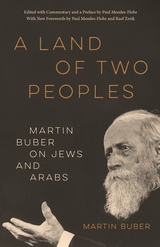 A Land of Two Peoples: Martin Buber on Jews and Arabs
Martin Buber
University of Chicago Press, 2025 A new edition of Martin Buber’s many writings on Arab-Jewish relations in Palestine, with updated forewords by two preeminent Palestinian and Jewish scholars.
The theologian and philosopher Martin Buber (1878–1965) was committed to radical socioeconomic reconstruction in pursuit of international peace. His voluminous writings on Arab-Jewish relations in Palestine interweave his religious and philosophical teachings with his politics, each essential to Buber’s vision of democratic and religious life.
A Land of Two Peoples collects the letters, talks, and essays in which Buber advocated for a binationalism that reconciled Arabs and Jews as a solution to the conflict in the Middle East. As relevant today as when it was first published nearly fifty years ago, this edition of A Land of Two Peoples includes two forewords from the preeminent Jewish and Palestinian scholars Paul Mendes-Flohr and Raef Zreik.
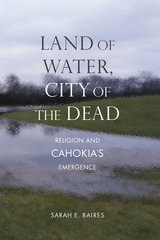 Land of Water, City of the Dead: Religion and Cahokia's Emergence
Sarah E. Baires
University of Alabama Press, 2017 Explores the embodiment of religion in the Cahokia land and how places create, make meaningful, and transform practices and beliefs
Cahokia, the largest city of the Mississippian mound cultures, lies outside present-day East St. Louis. Land of Water, City of the Dead reconceptualizes Cahokia’s emergence and expansion (ca. 1050–1200), focusing on understanding a newly imagined religion and complexity through a non-Western lens. Sarah E. Baires argues that this system of beliefs was a dynamic, lived component, based on a broader ontology, with roots in other mound societies. This religion was realized through novel mortuary practices and burial mounds as well as through the careful planning and development of this early city’s urban landscape.
Baires analyzes the organization and alignment of the precinct of downtown Cahokia with a specific focus on the newly discovered and excavated Rattlesnake Causeway and the ridge-top mortuary mounds located along the site axes. Land of Water, City of the Dead also presents new data from the 1954 excavations of the ridge-top mortuary Wilson Mound and a complete analysis of the associated human remains. Through this skeletal analysis, Baires discusses the ways that Cahokians processed and buried their ancestors, identifying unique mortuary practices that include the intentional dismemberment of human bodies and burial with marine shell beads and other materials.
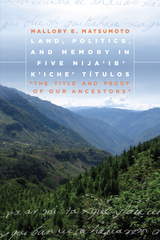 Land, Politics, and Memory in Five Nija'ib' K'iche' Títulos: "The Title and Proof of Our Ancestors"
Mallory Matsumoto
University Press of Colorado, 2017 Land, Politics, and Memory in Five Nija’ib’ K’iche’ Títulos is a careful analysis and translation of five Highland Maya títulos composed in the sixteenth century by the Nija’ib’ K’iche’ of Guatemala. The Spanish conquest of Highland Guatemala entailed a series of sweeping changes to indigenous society, not the least of which were the introduction of the Roman alphabet and the imposition of a European system of colonial government. Introducing the history of these documents and placing them within the context of colonial-era Guatemala, this volume provides valuable information concerning colonial period orthographic practice, the K’iche’ language, and language contact in Highland Guatemala. For each text, author Mallory E. Matsumoto provides a photographic copy of the original document, a transliteration of its sixteenth-century modified Latin script, a transcription into modern orthography, an extensive morphologic analysis, and a line-by-line translation into English, as well as separate prose versions of the transcription and translation. No complete English translation of this set of manuscripts has been available before, nor has any Highland Maya título previously received such extensive analytical treatment. Offering insight into the reality of indigenous Highland communities during this period, Land, Politics, and Memory in Five Nija’ib’ K’iche’ Títulos is an important primary source for linguists, historians, and experts in comparative literature. It will also be of significant interest to students and scholars of ethnohistory, linguistics, Latin American studies, anthropology, and archaeology.
The Land Question and the Irish Economy, 1870-1903
Barbara Lewis Solow
Harvard University Press, 1971 Here is a perceptive and convincing reinterpretation of economic development of Ireland after the Great Famine. Barbara Lewis Solow explodes the myth that Ireland’s economic difficulties were caused by defects in the land tenure system. In fact, she argues, the Irish economy made impressive progress in the decades between the famine of 1845 and the late 1870s. She investigates the sources and patterns of this progress, and, basing her conclusions on new quantitative estimates of significant economic variables, she reveals that there were determinants of Irish economic development much more important than the land system.
The Land Remembers: The Story of a Farm and Its People
Ben Logan, with an introduction by Curt Meine
University of Wisconsin Press, 2017 This beloved American memoir is about a farm and its people, recollections of a boyhood in Wisconsin's Driftless region. Ben Logan grew up on Seldom Seen Farm with his three brothers, father, mother, and hired hand Lyle. The boys discussed and argued and joked over the events around their farm, marked the seasons by the demands of the land, and tested each other and themselves.
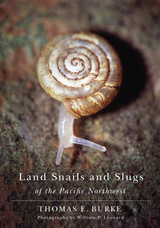 Land Snails and Slugs of the Pacific Northwest
Thomas E. Burke
Oregon State University Press, 2013 Terrestrial mollusks, the second largest phylum in the animal kingdom, are vitally important to the earth’s ecology. With the publication of Land Snails and Slugs of the Pacific Northwest, a definitive and comprehensive guide to snails and slugs of Oregon, Washington, Idaho, and western Montana is finally available.
Primarily an identification guide, this richly illustrated volume offers complete information on the range of terrestrial mollusk shapes, sizes, and characteristics. It presents an overview of their habitat requirements as well as details of land snail and slug ecology, collection and preservation methods, and biogeography.
Land Snails and Slugs of the Pacific Northwest is an essential reference for biologists, horticulturalists, gardeners, and naturalists, and anyone wishing to identify species in the field.
• Identification keys and species accounts for most of the 245 taxa of terrestrial slugs and snails in the region
• 280 full-color photographs of 155 species and subspecies
• Range maps for most species
The Land Still Lives
Jerry Apps
Wisconsin Historical Society Press, 2019 “Apps is a man of ideas who is sensitive to the touch, the smells, and the feel of doing things by hand, today and a hundred years ago.”—from the foreword by Senator Gaylord Nelson
Originally published in 1970, The Land Still Lives is the first book by Wisconsin’s greatest rural philosopher, Jerry Apps. Written when he was still a young agriculture professor at the University of Wisconsin, The Land Still Lives was readers’ first introduction to Jerry’s farm in central Wisconsin, called Roshara, and the surrounding community of Skunk’s Hollow. This special 50th-anniversary edition features a new epilogue, in which Jerry revisits his philosophy of caring for the land so it in turn will care for us. This is vintage Apps, essential reading for Jerry’s legions of fans—and for all who, like Jerry, wish “to develop a relationship with nature and all its mystery and wonder.”
Land Taxation in Imperial China, 1750–1911
Yeh-chien Wang
Harvard University Press, 1973 Imperial China cannot be understood without an examination of its fiscal base. In his pioneering study, Yeh-chien Wang for the first time provides a reliable estimate and an in-depth analysis of China’s principal source of public revenue—the land tax—in the Ch’ing period. The purpose of this study is to inquire how the land-tax system worked and how much revenue was produced from this source. Hence the approach adopted by the author is both institutional and quantitative.
A Land the Size of Binoculars
Igor Klekh
Northwestern University Press, 2004 Igor Klekh emerges as a writer from the crossroads of Europe—Western Ukraine—influenced by the great Russian literary tradition as well as the languages and dialects of both East-Central Europe and his native country. A Land the Size of Binoculars collects his breakthrough 1993 novella Kallimakh's Wake, five short pieces, and two more recent novellas.
Throughout, Klekh studies landscapes as intimate as the terrain between fathers and sons and as broad as the wild, mysterious Carpathian Mountains. His work has been compared to that of Borges, Eco, and the magical realists, and celebrated for its synthesis of numerous literary traditions, its use of esoteric knowledge, and its breathtaking prose.
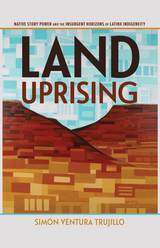 Land Uprising: Native Story Power and the Insurgent Horizons of Latinx Indigeneity
Simón Ventura Trujillo
University of Arizona Press, 2020 Land Uprising reframes Indigenous land reclamation as a horizon to decolonize the settler colonial conditions of literary, intellectual, and activist labor. Simón Ventura Trujillo argues that land provides grounding for rethinking the connection between Native storytelling practices and Latinx racialization across overlapping colonial and nation-state forms.
Trujillo situates his inquiry in the cultural production of La Alianza Federal de Mercedes, a formative yet understudied organization of the Chicanx movement of the 1960s and 1970s. La Alianza sought to recover Mexican and Spanish land grants in New Mexico that had been dispossessed after the Mexican-American War. During graduate school, Trujillo realized that his grandparents were activists in La Alianza. Written in response to this discovery, Land Uprising bridges La Alianza’s insurgency and New Mexican land grant struggles to the writings of Leslie Marmon Silko, Ana Castillo, Simon Ortiz, and the Zapatista Uprising in Chiapas, Mexico. In doing so, the book reveals uncanny connections between Chicanx, Latinx, Latin American, and Native American and Indigenous studies to grapple with Native land reclamation as the future horizon for Chicanx and Latinx indigeneities.
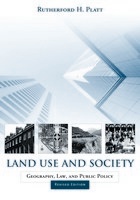 Land Use and Society, Revised Edition: Geography, Law, and Public Policy
Rutherford H. Platt
Island Press, 2004 Land Use and Society is a unique and compelling exploration of interactions among law, geography, history, and culture and their joint influence on the evolution of land use and urban form in the United States. Originally published in 1996, this completely revised, expanded, and updated edition retains the strengths of the earlier version while introducing a host of new topics and insights on the twenty-first century metropolis.
This new edition of Land Use and Society devotes greater attention to urban land use and related social issues with two new chapters tracing American city and metropolitan change over the twentieth century. More emphasis is given to social justice and the environmental movement and their respective roles in shaping land use and policy in recent decades. This edition of Land Use and Society by Rutherford H. Platt is updated to reflect the 2000 Census, the most recent Supreme Court decisions, and various topics of current interest such as affordable housing, protecting urban water supplies, urban biodiversity, and "ecological cities." It also includes an updated conclusion that summarizes some positive and negative outcomes of urban land policies to date.
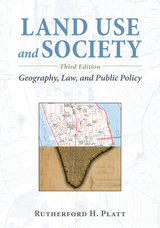 Land Use and Society, Third Edition: Geography, Law, and Public Policy
Rutherford H. Platt
Island Press, 2014 The intersection between geography and law is a critical yet often overlooked element of land-use decisions, with a widespread impact on how societies use the land, water, and biodiversity around them. Land Use and Society, Third Edition is a clear and compelling guide to the role of law in shaping patterns of land use and environmental management. Originally published in 1996 and revised in 2004, this third edition has been updated with data from the 2010 U.S. Census and revised with the input of academics and professors to address the changing issues in land use, policy, and law today. Land Use and Society, Third Edition retains the historical approach of the original text while providing a more concise and topical survey of the evolution of urban land use regulation, from Europe in the Middle Ages through the present day United States. Rutherford Platt examines the “nuts and bolts” of land use decision-making in the present day and analyzes key players, including private landowners, local and national governments, and the courts. This third edition is enhanced by a discussion of the current trends and issues in land use, from urban renewal and demographic shifts in cities to the growing influence of local governance in land use management. Land Use and Society, Third Edition is a vital resource for any student seeking to understand the intersection between law, politics, and the natural world. While Platt examines specific rules, doctrines, and practices from an American context, an understanding of the role of law in shaping land use decisions will prove vital for students, policymakers, and land use managers around the world.
 Land Utilization in Minnesota: A State Program for the Cut-Over Lands
Committee Committee on Land Utilization
University of Minnesota Press, 1934
Land Utilization in Minnesota was first published in 1934. Minnesota Archive Editions uses digital technology to make long-unavailable books once again accessible, and are published unaltered from the original University of Minnesota Press editions.This volume constitutes the final report of the Minnesota Committee on Land Utilization. Appointed in 1932 by Governor Floyd B. Olson, the committee conducted an exhaustive, two-year study of land use in northern Minnesota, paying careful attention to the repopulation of the cut-over lands.Chaired by Lotus D. Coffman, president of the University of Minnesota, the Committee included twelve members representing different geographical locations of Minnesota. The report was prepared for publication by Professors William Anderson and Oscar B. Jesness of the University of Minnesota and Dr. Raphael Zon, director of the Lakes States Forest Experiment Station.Topics discussed include: physical and climatic features affecting land use; social and economic effects of past land development; population trends and land use; present and possible future need for agricultural and forest lands; the use of land for recreation; water and mineral resources as related to land use; taxation as it affects land use; and local government under changed land use conditions.In his foreword to the volume, Governor Olson remarks “The report discusses concretely the direction in which the commonwealth must move to bring our own house in order, and it lays a foundation for action by our state legislature. In my humble opinion, it is the most thorough and constructive research report outlining a land policy that has ever been brought together in this state.”
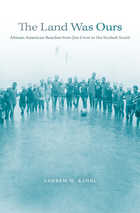 The Land Was Ours: African American Beaches from Jim Crow to the Sunbelt South
Andrew W. Kahrl
Harvard University Press, 2012 Driving along the coasts of the American South, we see miles of luxury condominiums, timeshare resorts, and gated communities. Yet, a century ago, a surprising amount of beachfront property in the Chesapeake, along the Carolina shore, and around the Gulf of Mexico was owned and populated by African Americans. In a pathbreaking combination of social and environmental history, Andrew W. Kahrl shows how the rise and fall of Jim Crow and the growing prosperity of the Sunbelt have transformed both communities and ecosystems along the southern seaboard.
Kahrl traces the history of these dynamic coastlines in all their incarnations, from unimproved marshlands to segregated beaches, from exclusive resorts for the black elite to campgrounds for religious revival. His careful reconstruction of African American life, labor, and leisure in small oceanside communities reveals the variety of ways African Americans pursued freedom and mobility through the land under their feet.
The Land Was Ours makes unexpected connections between two seemingly diverse topics: African Americans' struggles for economic empowerment and the ecology of coastal lands. Kahrl's innovative approach allows him fresh insights into the rise of African American consumers and the widespread campaigns to dispossess blacks of their property. His skillful portrayal of African American landowners and real-estate developers rescues the stories of these architects of the southern landscape from historical neglect. Ultimately, Kahrl offers readers a thoughtful, judicious appraisal of the ambiguous legacy of racial progress in the Sunbelt.
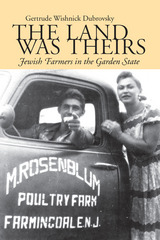 The Land Was Theirs: Jewish Farmers in the Garden State
Gertrude W. Dubrovsky
University of Alabama Press, 1992 Provides a perspective on the pressures, problems, and satisfactions of rural Jewish life as experienced in one community
The Land Was Theirs is about Farmingdale, New Jersey, a community of Jewish farming communities in the United States established with the help of the Jewish Agricultural Society. The 50 year history of Farmingdale provides a perspective on the pressures, problems, and satisfactions of rural Jewish life as experienced in one community.
Beginning in 1919, the community grew around the small town of Farmingdale, when two Jewish families pooled their resources to establish a farm. The community evolved gradually as unrelated individuals with no previous farm experience settled and then created the institutions and organizations they needed to sustain their Jewish life. By 1945 Farmingdale was one of the leading egg-producing communities in the United States, and contributed in large measure to New Jersey’s reputation as the “egg basket of America.”
The Land Was Theirs draws from life-history interviews with 120 farmers, from the author’s personal experiences, and from a variety of private and community papers and documents. They are the pieces from which a full picture of a single Jewish farm community emerges.
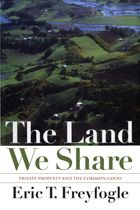 The Land We Share: Private Property And The Common Good
Eric T. Freyfogle
Island Press, 2003 Is private ownership an inviolate right that individuals can wield as they see fit? Or is it better understood in more collective terms, as an institution that communities reshape over time to promote evolving goals? What should it mean to be a private landowner in an age of sprawling growth and declining biological diversity? These provocative questions lie at the heart of this perceptive and wide-ranging new book by legal scholar and conservationist Eric Freyfogle. Bringing together insights from history, law, philosophy, and ecology, Freyfogle undertakes a fascinating inquiry into the ownership of nature, leading us behind publicized and contentious disputes over open-space regulation, wetlands protection, and wildlife habitat to reveal the foundations of and changing ideas about private ownership in America. Drawing upon ideas from Thomas Jefferson, Henry George, and Aldo Leopold and interweaving engaging accounts of actual disputes over land-use issues, Freyfogle develops a powerful vision of what private ownership in America could mean—an ownership system, fair to owners and taxpayers alike, that fosters healthy land and healthy economies.
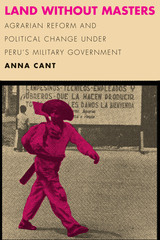 Land without Masters: Agrarian Reform and Political Change under Peru's Military Government
By Anna Cant
University of Texas Press, 2021 In 1969, Juan Velasco Alvarado’s military government began an ambitious land reform program in Peru, transferring holdings from large estates to peasant cooperatives. Fifty years later this reform remains controversial: critics claim it unjustly expropriated land and ruined the Peruvian economy, while supporters emphasize its success in addressing rural inequality and exploitation. Moving beyond agricultural policy to offer a fresh perspective on the agrarian reform, Land without Masters shows how ideological assumptions and state interventions surrounding the reform transformed Peru’s political culture and social fabric. Drawing on fieldwork in three different regions, Anna Cant shows how the government adapted its discourse and interventions to the local context while using the reform as a platform for nation-building. This comparative approach reveals how local actors shaped the regional impact of the agrarian reform and highlights the new forms of agency that emerged, including that of marginalized peasants who helped forge a new social, cultural, and political landscape. Making novel use of both visual and cultural sources, this book is a fascinating look at how the agrarian reform process permanently altered the relationship between rural citizens and the national government—and how it continues to resonate in Peruvian politics today.
 Landbridge: Life in Fragments
Y-Dang Troeung
Duke University Press, 2024 In 1980, Y-Dang Troeung and her family were among the last of the 60,000 refugees from Cambodia that Canada agreed to admit. Their landing was widely documented in newspapers, with photographs of the prime minister shaking Troeung’s father’s hand and patting baby Y-Dang’s head. Troeung became a literal poster child for the benevolence of the Canadian refugee project. She returns to this moment forty years later in her arresting memoir Landbridge, where she explores the tension between that public narrative of happy “arrival,” and the multiple, often hidden truths of what happened to her family. In precise, beautiful prose, Troeung moves back and forth in time to tell stories about her parents and two brothers who lived through the Cambodian genocide, about the lives of her grandparents and extended family, about her own childhood in the refugee camps and in rural Ontario, and eventually about her young son’s illness and her own diagnosis with a terminal disease. Throughout this brilliant and astonishing book, Troeung looks with bracing clarity at refugee existence and dares to imagine a better future, with love.
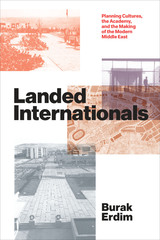 Landed Internationals: Planning Cultures, the Academy, and the Making of the Modern Middle East
By Burak Erdim
University of Texas Press, 2020 2022 On the Brinck Book Award, University of New Mexico School of Architecture + Planning
Special Mention, First Book Prize, International Planning History Society
Landed Internationals examines the international culture of postwar urban planning through the case of the Middle East Technical University (METU) in Ankara, Turkey. Today the center of Turkey's tech, energy, and defense elites, METU was founded in the 1950s through an effort jointly sponsored by the UN, the University of Pennsylvania, and various governmental agencies of the United States and Turkey. Drawing on the language of the UN and its Technical Assistance Board, Erdim uses the phrase "technical assistance machinery" to encompass the sprawling set of relationships activated by this endeavor. Erdim studies a series of legitimacy battles among bureaucrats, academics, and other professionals in multiple theaters across the political geography of the Cold War. These different factions shared a common goal: the production of nationhood—albeit nationhood understood and defined in multiple, competing ways. He also examines the role of the American architecture firm Skidmore, Owings, and Merrill; the New York housing policy guru Charles Abrams; the UN and the University of Pennsylvania; and the Turkish architects Altuğ and Behruz Çinici. In the end, METU itself looked like a model postwar nation within the world order, and Erdim concludes by discussing how it became an important force in transnational housing, planning, and preservation in its own right.
Landfall: A Ring of Stories
Julie Hensley
Ohio State University Press, 2016 In this ring of connected short stories, grounded in the fictional town of Conrad’s Fork, Kentucky, everyone is staging some sort of escape. A woman harboring the dark truth about her youngest daughter’s birth, a new teacher suddenly under suspicion after a student’s disappearance, a young girl witnessing her older sister’s sexual awakening: all the people in this Appalachian community suffer a paralyzed desire in response to the stagnancy and exposure they experience in their small town. Landfall: A Ring of Stories weaves together the voices of two generations of mountain families in which secrets are carefully guarded—even from closest kin. One by one, those who leave confront the pull of the land and the people they’ve left behind. Perhaps Conrad’s Fork will save them, or, perhaps, in the wake of urban encroachment and shifting family systems, they will save it.
Landforms of Iowa
Jean C. Prior
University of Iowa Press, 1991 Here is a captivating, authoritative guide to the Hawkeye State's landscape features and their geologic ingredients. The clearly presented text and superb full-color photographs and maps will inspire all visitors to read and enjoy the story of Iowa's landscape.
Landing in Las Vegas: Commercial Aviation and the Making of a Tourist City
Daniel K. Bubb
University of Nevada Press, 2017 At the beginning of the twentieth century, Las Vegas was a dusty, isolated desert town. By century’s end, it was the country’s fastest-growing city, a world-class travel destination with a lucrative tourist industry hosting millions of visitors a year. This transformation came about in large part because of a symbiotic relationship between airlines, the city, and the airport, facilitated by the economic democratization and deregulation of the airline industry, the development of faster and more comfortable aircraft, and the ambitious vision of Las Vegas city leaders and casino owners. Landing in Las Vegas is a compelling study of the role of fast, affordable transportation in overcoming the vast distances of the American West and binding western urban centers to the national and international tourism, business, and entertainment industries.
Landing Platform Dock Intrepid
Jantinus Mulder
Amsterdam University Press, 2024 One of a two-ship class assault ships commissioned in 1967. Incorporating a large docking well aft, which could accommodate up to four medium landing craft, while four 30 troop light landing craft could be loaded on davits each side of the superstructure. The large flight deck aft could operate up to six helicopters. Both ships operated with the Falkland Task Force in 1982.
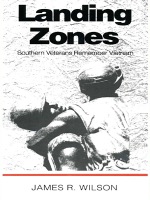 Landing Zones: Southern Veterans Remember Vietnam
James R. Wilson
Duke University Press, 1990 Landing Zones brings to life the dramatic, gripping, and often painful stories of twenty-four Vietnam Veterans from the American South. The men and women interviewed here represent a remarkable range of experience, including a marine rifleman, a helicopter pilot, an army nurse, a prisoner of war, a riverboat gunner, and the commanding general William Westmoreland. Skillfully interviewed by James R. Wilson, a journalist and Army press officer in Vietnam, each narrative explores and describes the war’s events before following the veterans home and carrying them to the present.
These stories focus on a uniquely southern view of Vietnam. In terms of numbers the South shouldered more than its share of human cost—31 percent of Americans who served came from one of the eleven states of the old Confederacy, and 28 percent of the dead were southerners. Southerners also brought to Vietnam certain shared cultural tastes and a particularly southern heritage of honor in military service stemming from the Civil War. For many, as their testimony reveals, a sense of patriotism was tested and questioned by the horrors of war, and for others that patriotism was a continued source of strength.
Individually and collectively, however, these oral histories make up a picture of war that prevents us from forgetting the truth as one veteran put it: “Vietnam was not one war, but a thousand little nasty wars.”
Landlocked
Julia McConnell
Michigan State University Press, 2023 Lesbian bars, libraries, highways, churches, and oil rigs set the scenes for the poems in Landlocked. Whether at work or at play, the speakers in Landlocked live in the space between longing and belonging, wanderlust and homesickness, and explore the intersection of place and identity. In the era of “don’t say gay,” these poems provide a defiantly queer perspective on Oklahoma, one of the reddest of the red states, and its many contradictions.
 Landlord and Labor in Late Imperial China: Case Studies from Shandong
Endymion Wilkinson
Harvard University Press, 1978 This well-documented study discusses the social and economic changes in Shandong province before the influence of the West was felt at the end of the nineteenth century. The authors show that by the sixteenth century, commercial and handicraft towns linked to national and local markets had already begun to emerge. Urban growth was made possible by increased agricultural production, which in turn stimulated specialization and increased commercialization in the agricultural sector. Another important change in rural society at this time was the emergence of a new stratum of wealthy landlords who managed their estates with wage labor. Case studies of managerial landlords, who form the main focus of this study, are included as well as generalizations drawn from questionnaire materials.
Jing Su and Luo Lun wrote this book while they were young researchers at Shandong University in the late 1950s, using data they had gathered in the culturally relaxed period of the Hundred Flowers. In his Introduction, Endymion Wilkinson analyzes the authors’ thesis and concludes that their Leninist model is inapplicable to premodern Chinese history. The value of this study lies not so much in its conclusion that even without the impact of Western imperialism China would of itself have developed a capitalist society, but rather in the wealth of data the authors present, in this first in-depth study of a relatively advanced region in north China.
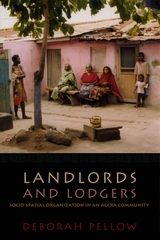 Landlords and Lodgers: Socio-Spatial Organization in an Accra Community
Deborah Pellow
University of Chicago Press, 2008 Landlords and Lodgers analyzes the results of a long-term study of a Ghanaian zongo, or “stranger quarter”—a place of refuge for Hausa migrants from northern Nigeria who have relocated to the city of Accra. Deborah Pellow explores the relationships among community members both in terms of the built structures—rooms, doors, communal structures, and hallways—and of the social networks, institutions, and routine activities that define this unique urban neighborhood. This volume will be useful to students and scholars of the relationships between architecture, migration, and social change.
“This richly observed and lovingly constructed portrait of a distinctive community will be of interest to spatially informed scholars of religion, immigration, minority communities, and gender.”—Gender, Place and Culture
“This theoretically informed, well-researched, and closely written book should be quite useful. . . . A fine case study of urban sense of place in a unique, yet in some ways emblematic, West African neighborhood.”—Gareth Myers, Professional Geographer
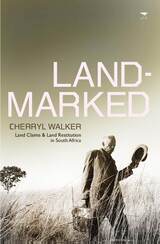 Landmarked: Land Claims and Land Restitution in South Africa
Cherryl Walker
Ohio University Press, 2008 The year 2008 is the deadline set by President Mbeki for the finalization of all land claims by people who were dispossessed under the apartheid and previous white governments. Although most experts agree this is an impossible deadline, it does provide a significant political moment for reflection on the ANC government’s program of land restitution since the end of apartheid.
Land reform (and land restitution within that) remains a highly charged issue in South Africa, one that deserves more in–depth analysis. Drawing on her experience as Rural Land Claims Commissioner in KwaZulu–Natal from 1995 to 2000, Professor Cherryl Walker provides a multilayered account of land reform in South Africa, one that covers general critical commentary, detailed case material, and personal narrative. She explores the master narrative of loss and restoration, which has been fundamental in shaping the restitution program; offers a critical overview of the achievements of the program as a whole; and discusses what she calls the “non–programmatic limits to land reform,” including urbanization, environmental constraints and the impact of HIV/AIDS.
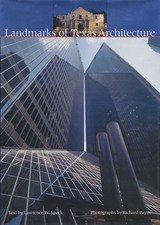 Landmarks of Texas Architecture
Lawrence W. Speck
University of Texas Press, 1986 "This selection of twenty of Texas' proudest architectural achievements is a tiny sampling of the state's rich, but little-heralded, architectural heritage. The visual presentation of these buildings in Richard Payne's insightful photographs is evidence enough to any student of Texas culture that there are deep and meaningful tracks of our civilization in the state's built environment. . . . In the stones of the Alamo and the steel and glass of our downtown skyscrapers lie the silent embodiment of who we are and where we have been."
—from the Introduction Texas architecture has never been, nor is it likely to be in the future, an easily digested whole. This collection, drawn from the 1983 Texas Society of Architects' exhibit "Creating Tomorrow's Heritage," provides a look at twenty of the most interesting responses to the challenges posed by Texas history and geography. It reveals that what Texas architecture lacks in cohesiveness, it more than compensates for in vitality. Variations in circumstance and background, coupled with the kind of freedom which heterogeneity breeds, have produced a lively climate for architectural development in Texas—a place where, in the absence of pat answers, intriguing questions have been raised. The same freedom which has produced a dearth of cohesion has encouraged exploration and invention. The same disparities which have made tidy categorization of historical movements or periods difficult have led to some evocative hybrids—new and telling syntheses which are genuinely of their place. Of interest to anyone who has strolled the Paseo del Rio in San Antonio or admired the dramatically lit State Capitol at night, Landmarks of Texas Architecture is a book to be looked at and enjoyed, a place to start in creating one's own list of architectural favorites. Part of the growing interest in Texas history and culture, Landmarks adds to our understanding of the forces which shaped the Texas of yesterday and will build the Texas of tomorrow.
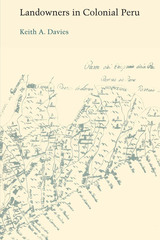 Landowners in Colonial Peru
By Keith A. Davies
University of Texas Press, 1984 In 1540 a small number of Spaniards founded the city of Arequipa in southwestern Peru. These colonists, later immigrants, and their descendants devoted considerable energy to exploiting the surrounding area. At first, like many other Spaniards in the Americas, they relied primarily on Indian producers; by the late 1500s they had acquired land and established small farms and estates. This, the first study to examine the agrarian history of a region in South America from the mid-sixteenth through late-seventeenth century, demonstrates that colonials exploited the countryside as capitalists. They ran their rural enterprises as efficiently as possible, expanded their sources of credit and labor, tapped widespread markets, and lobbied strenuously to influence the royal government. The reasons for such behavior have seldom been explored beyond the colonists’ evident need to sustain themselves and their dependents. Arequipa’s case suggests another fundamental cause of capitalist behavior in colonial South America: rural wealth was inextricably tied to the colonists’ desire to reinforce and improve their stature. Arequipa’s Spanish families of the upper and middle social levels consistently employed land and its proceeds to attract prominent spouses, to acquire prestigious political and military posts, and to enhance their standing by becoming benefactors of the Church. They rarely lost sight of the crucial role that wealth played in their lives. Thus, when the region’s economy flourished, as it did during the late 1500s, they expanded and improved their holdings. When it faltered at the beginning of the next century, they made every effort to retain properties, even fragmenting land to accommodate family members and new spouses. Unlike patterns sometimes suggested for Spanish America, many Arequipan colonial families possessed land and retained it over many generations. Neither the increasingly rich Church nor a few powerful persons managed to build up extensive estates. Landowners in Colonial Peru explains how and why rural property became so important. It emphasizes both the capitalist bent of Hispanics and the manner in which wealth served social aspirations. The approach makes clear that many of the economic and social characteristics so often attributed to eighteenth- and nineteenth-century Latin Americans were present from the early Colonial period.
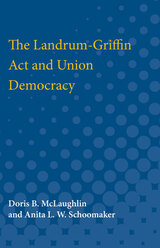 The Landrum-Griffin Act and Union Democracy
Doris B. McLaughlin and Anita L.W. Schoomaker
University of Michigan Press, 1979 The Landrum-Griffin Act and Union Democracy is the result of a two-year study conducted by the authors that involved well over one hundred in-depth interviews with union officers, labor lawyers, dissident union members and their advocates, academicians, and U.S. Department of Labor personnel charged with enforcing the Act, as well as with a few management representatives. In addition, rank-and-file members' knowledge of the Act and their assessment of their ability to exercise the rights accorded them under the Act were studied by means of the inclusion of a set of questions in three separate surveys conducted by the University of Michigan’s Survey Research Center—two nationwide and one involving the greater Detroit Metropolitan area. Participation in the three surveys enabled the authors to reach an additional 677 union members who would have been difficult to contact by any other means.
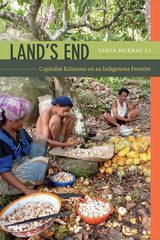 Land's End: Capitalist Relations on an Indigenous Frontier
Tania Murray Li
Duke University Press, 2014 Drawing on two decades of ethnographic research in Sulawesi, Indonesia, Tania Murray Li offers an intimate account of the emergence of capitalist relations among indigenous highlanders who privatized their common land to plant a boom crop, cacao. Spurred by the hope of ending their poverty and isolation, some prospered, while others lost their land and struggled to sustain their families. Yet the winners and losers in this transition were not strangers—they were kin and neighbors. Li's richly peopled account takes the reader into the highlanders' world, exploring the dilemmas they faced as sharp inequalities emerged among them.
The book challenges complacent, modernization narratives promoted by development agencies that assume inefficient farmers who lose out in the shift to high-value export crops can find jobs elsewhere. Decades of uneven and often jobless growth in Indonesia meant that for newly landless highlanders, land's end was a dead end. The book also has implications for social movement activists, who seldom attend to instances where enclosure is initiated by farmers rather than coerced by the state or agribusiness corporations. Li's attention to the historical, cultural, and ecological dimensions of this conjuncture demonstrates the power of the ethnographic method and its relevance to theory and practice today.
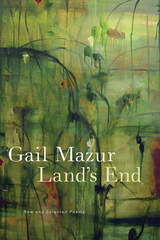 Land's End: New and Selected Poems
Gail Mazur
University of Chicago Press, 2020 With her latest poetry collection, Gail Mazur once again shows her mastery of the descriptive-meditative narrative, powerfully evoking the past while writing from the firm ground of the present. In Land’s End, we see Mazur writing with the kind of lyric authority, ever-deepening emotional range, and intellectual and social scope that her readers have come to expect in her poetry. Beautifully crafted elegies meet with reflections on her own life, her family, and artists who have come and gone. In the title poem, she leads readers through a garden, where new and old growth twists together in an “almanac of inheritances” that conjures the rich memory of poets who have passed on. In this space of remembrance, Mazur also charges us with the responsibility of nurturing art and artists of the future, especially in the face of the disheartening absurdities of contemporary politics. Contemplating the growth and decay so entwined in life, these poems invite us to consider both inevitable brokenness and necessary hope, writing “My work now: to continue learning to absorb the loss, / and live.” Through tidal creeks and the weightless scenes of ukiyo-e woodcuts, in artists’ studios and along the frozen Charles River, Mazur connects passionately with the world around her. Carrying with her the undeniable presence of loss and of time past, she engages deeply with the present, her historic memory informing a deep concern for contemporary life. Reading Land’s End, we find ourselves with the poet: as if here at land’s end, here on the coast, urgent,
together we’d have energies to do battle forever.
As if we could rescue the guttering world….
Lands of Likeness: For a Poetics of Contemplation
Kevin Hart
University of Chicago Press, 2023 An original and profound exploration of contemplation from philosopher, theologian, and poet Kevin Hart.
In Lands of Likeness, Kevin Hart develops a new hermeneutics of contemplation through a meditation on Christian thought and secular philosophy. Drawing on Kant, Schopenhauer, Coleridge, and Husserl, Hart first charts the emergence of contemplation in and beyond the Romantic era. Next, Hart shows this hermeneutic at work in poetry by Gerard Manley Hopkins, Marianne Moore, Wallace Stevens, and others. Delivered in its original form as the prestigious Gifford Lectures, Lands of Likeness is a revelatory meditation on contemplation for the modern world.
Land-Saving Action
Edited by Russell Brenneman and Sarah Bates
Island Press, 1984 Land-Saving Action presents 35 articles from 29 of the foremost practitioners of land conservation nationwide. Case studies, detailed references, and a complete index make this volume unsurpassed in its usefulness to everyone who is concerned with saving land.
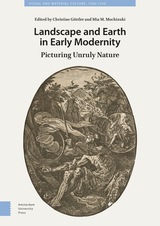 Landscape and Earth in Early Modernity: Picturing Unruly Nature
Christine Göttler
Amsterdam University Press, 2023 Early modern views of nature and the earth upended the depiction of land. Landscape emerged as a site of artistic exploration at a time when environments and ecologies were reshaped and transformed. This volume historicizes the contingency of an ever-changing elemental world, reframing and reimagining landscape as a mediating space in the interplay between the natural and the artificial, the real and the imaginary, the internal and the external. The lens of the “unruly” reveals the latent landscapes that undergirded their conception, the elemental resources that resurfaced from the bowels of the earth, the staged topographies that unsettled the boundaries between nature and technology, and the fragile ecologies that undermined the status quo of human environs. Landscape and Earth in Early Modernity: Picturing Unruly Nature argues for an art history attentive to the vicissitudes of circumstance and attributes the regrounding of representation during a transitional age to the unquiet landscape.
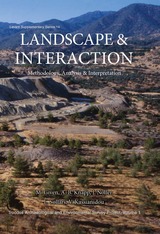 Landscape and Interaction. The Troodos Archaeological and Environmental Survey Project, Cyprus. Volume 1. Methodology, Analysis and Interpretation
Michael Given
Council for British Research in the Levant, 2013 The Troodos Mountain range in central Cyprus is a region of great physical and cultural diversity. The landscapes range from fertile, cultivated plains to narrow, dry valleys and forested mountain regions and this physical topography is overlain by a rich human cultural landscape of farming, mining, industry, settlement, burial and ritual behaviour. Over six field seasons, a team of specialists and fieldwalkers from the Troodos Archaeological and Environmental Survey Project (TAESP) investigated the northern edge of this region and explored the complex and dynamic relationship between landscape and people over 12,000 years. The results of their integrated and interpretative approach are presented here, in the first of two volumes. Beginning with a considered overview of the context, research aims and methodology of the project, Volume 1 provides detailed accounts of the archaeology, material culture, geography and environmental record of the entire survey area. This wealth of information is then bought together to produce a series of chronological and thematic analyses of the interaction between people and landscape in this region of Cyprus from the Prehistoric through to the Modern period.
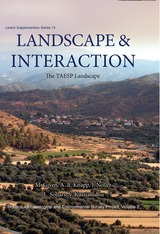 Landscape and Interaction. The Troodos Archaeological and Environmental Survey Project, Cyprus. Volume 2. The TAESP Landscape
Michael Given
Council for British Research in the Levant, 2013 The TAESP Landscape, the second of two volumes, presents an area-by-area analysis of the fieldwork and research undertaken by the Troodos Archaeological and Environmental Survey Project (TAESP) in the Troodos Mountains of Cyprus. Covering four regions of the survey area (The Plains, Karkotis Valley, Upper Lagoudhera Valley and The Mountains) the volume focuses on explicit research questions appropriate to each region. Organised geographically, chronologically and thematically, each region is investigated from the Neolithic to the present day and, through ‘Intensive Survey Zones’ – selected to give a representative range of the physical and cultural terrain – many notable new discoveries are made. These include the pattern of Bronze Age Settlement in the Plains, Archaic rural sanctuaries and cemeteries, the scope of Late Roman copper-mining and isolated Medieval mountain settlements. The TAESP Landscape provides a fully integrated and data-rich analysis of the material from a wide range of contrasting archaeological perspectives. Taken together, these wide-ranging and interdisciplinary perspectives give a nuanced and sensitive approach to a strikingly multi-faceted landscape.
Landscape and Land Use in First Millennium BC Southeast Italy: Planting the Seeds of Change
Daphne Lentjes
Amsterdam University Press, 2016 This book offers a comprehensive overview of landscape and land use in southeast Italy in the first millennium BCE. Using the most up-to-date techniques, it combines archaeobotanical and archaeozoological data with information from excavations, field surveys, and ancient written texts to place the relationship between people and landscapes in a broad geographical and chronological framework. It also confronts questions of food habits, the scale and organisation of agricultural production, the influx of Greek and Roman colonists, and the effects of globalisation on local and regional land use.
Landscape and Power, Second Edition
Edited by W. J. T. Mitchell
University of Chicago Press, 2002 The classic, groundbreaking work that reshaped landscape studies and continues to guide the field today
The first edition of this book, published in 1994, reshaped the direction of landscape studies by considering landscape not simply as an object to be seen or a text to be read, but as an instrument of cultural force, a central tool in the creation of national and social identities. This second edition adds not only a new preface, but five new essays—from Edward Said, W. J. T. Mitchell, Jonathan Bordo, Michael Taussig, and Robert Pogue Harrison—extending the scope of the book in remarkable ways.
Landscape and Power continues to be a central text for students and scholars who want to understand the importance of landscape to the making of our social, political, and cultural world.
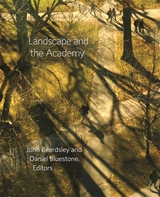 Landscape and the Academy
John Beardsley
Harvard University Press Universities are custodians of some of the most significant designed landscapes in the world.
The planning of the academic campus has historically underscored the relationship between an institution’s faculty and its students. The campus creates spaces for sharing traditions and reinforces the aspirations of a community of learning that stewards knowledge, provokes reflection, and shapes citizenship. Landscape and the Academy complements the growing body of literature in architectural history, cultural geography, and education by examining the role of landscape in creating academic communities.
The volume looks beyond the central campus, to the gardens, arboreta, farms, forests, biotic reserves, and far-flung environmental research stations managed by universities. In these landscapes, the university’s project of fostering research and exploration is made explicit; these spaces reflect the broader research and scholarly mission of the university, its striving for understanding and enlightenment. The essays examine how and why universities have come to be responsible for so many different kinds of landscapes, as well as the role these landscapes play in academic life, pedagogy, and cultural politics today.
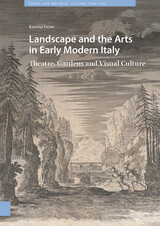 Landscape and the Arts in Early Modern Italy: Theatre, Gardens and Visual Culture
Katrina Grant
Amsterdam University Press, 2022 Landscape and the Arts in Early Modern Italy: Theatre, Gardens and Visual Culture argues that theatre, and the new genre of opera in particular, played a key role in creating a new vision of landscape during the long seventeenth century in Italy. It explores how the idea of gardens as theatres emerged at the same time as opera was developed in Italian courts around the turn of the seventeenth century. During this period landscape painting emerged as a genre and the aesthetic of designed landscapes and gardens was wholly transformed, which resulted in a reconceptualization of the relationship between humans and landscape. The importance of theatre as a key cultural expression in Italy is widely recognised, but the visual culture of theatre and its relationship to the broader artistic culture is still being untangled. This book argues that the combination of narratives playing out in natural settings (Arcadia, Parnassus, Alcina), the emotional responses elicited by sets and special effects (the apparent magical manipulation of the laws of nature), and, the way that garden theatres were used for displays of power and to enact princely virtue and social order, all contributed to this shifting idea of landscape in the seventeenth century.
Landscape and the Science Fiction Imaginary
John Timberlake
Intellect Books, 2018 There has been plenty of scholarship on science fiction over the decades, but it has left one crucial aspect of the genre all but unanalyzed: the visual. Ambitious and original, Landscape and the Science Fiction Imaginary corrects that oversight, making a powerful argument for science fiction as a visual cultural discourse. Taking influential historical works of visual art as starting points, along with illustrations, movie matte paintings, documentaries, artist’s impressions, and digital environments, John Timberlake focuses on the notion of science fiction as an “imaginary topos,” one that draws principally on the intersection between landscape and historical/prehistorical time. Richly illustrated, this book will appeal to scholars, students, and fans of science fiction and the remarkable visual culture that surrounds it.
Landscape Archaeology between Art and Science: From a Multi- to an Interdisciplinary Approach
Edited by Sjoerd J. Kluiving and Erika Guttmann-Bond
Amsterdam University Press, 2012 This volume contains thirty-five papers from a 2010 conference on landscape archaeology focusing on the definition of landscape as used by processual archaeologists, earth scientists, and most historical geographers, in contrast to the definition favored by postprocessual archaeologists, cultural geographers, and anthropologists. This tension provides a rich foundation for discussion, and the papers in this collection cover a variety of topics including: how do landscapes change; how to improve temporal, chronological, and transformational frameworks; how to link lowlands with mountainous areas; applications of scale; new directions in digital prospection and modeling techniques; and the future of landscape archaeology.
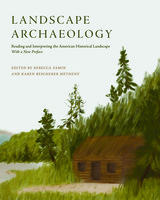 Landscape Archaeology: Reading and Interpreting the American Historical Landscape
Rebecca Yamin
University of Tennessee Press, 1996 The essays collected in this volume represent exciting new directions in the study of America’s landscapes. Written from a post-processualist viewpoint, these analyses go beyond directly observable phenomena to explain the particular significance that people have attached to the environments they create for themselves. As the editors note, “This volume includes many searching looks at the landscape, not just to understand ourselves, but to understand the context for other peoples’ lives in other times, to unravel the landscapes they created and explain the meanings embedded in them.”
The book’s overall approach is interpretive and interdisciplinary, drawing not simply on archaeological evidence but on oral history, written sources, ethnographic data, and human experience. The contributors examine a variety of questions and methods for recovering and interpreting past landscapes. How, for example, did an elite family in eighteenth-century New Jersey express its status and values through its manipulation of the landscape and how, indeed, do archaeologists derive that information from remains in the ground? What do the ruins left standing in a rural landscape say about attitudes toward time and family? How do the fields and yards of small farms reveal sociopolitical forces affecting the society at large?
The essays in Part I study gardens belonging to elite men and women—including those of American presidents whose houses have become important patriotic symbols. The essays in Part II look beyond the confines of single properties to reveal broader patterns in the historical landscape. The preface and introductory essay provide a theoretical framework for the volume and an overview of the current state of research in the field. The result is a book that will interest not only historical archaeologists but all students of the landscape.
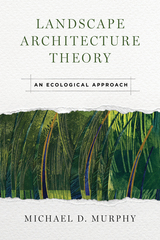 Landscape Architecture Theory: An Ecological Approach
Michael D. Murphy
Island Press, 2016 For decades, landscape architecture was driven solely by artistic sensibilities. But in these times of global change, the opportunity to reshape the world comes with a responsibility to consider how it can be resilient, fostering health and vitality for humans and nature. Landscape Architecture Theory re-examines the fundamentals of the field, offering a new approach to landscape design.
Drawing on his extensive career in teaching and practice, Michael Murphy begins with an examination of influences on landscape architecture: social context, contemporary values, and the practicalities of working as a professional landscape architect. He then delves into systems and procedural theory, while making connections to ecosystem factors, human factors, utility, aesthetics, and the design process. He concludes by showing how a strong theoretical understanding can be applied to practical, every-day decision making and design work to create more holistic, sustainable, and creative landscapes.
Students will take away a foundational understanding of the underpinnings of landscape architecture theory, as well as how it can be applied to real-world designs; working professionals will find stimulating insights to infuse their projects with a greater sense of purpose.
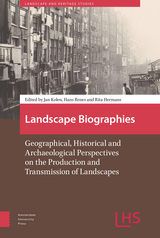 Landscape Biographies: Geographical, Historical and Archaeological Perspectives on the Production and Transmission of Landscapes
Edited by Jan Kolen, Hans Renes, and Rita Hermans
Amsterdam University Press, 2015 Landscape Biographies explores the long and complex histories of landscapes from personal and social perspectives. As an essential part of human life-worlds, landscapes have the potential to absorb something of people's lives, works, and thoughts. But landscapes also shape their own life-histories at different timescales, transcending human life-cycles and generating their own temporalities and rhythms. It comes as no surprise, therefore, that the co-scripting of landscapes and people figures prominently in the (auto-)biographical works of writers and attracts the interest of geographers, archaeologists, historians, and anthropologists. This has even resulted in a new genre in landscape research, rapidly gaining in popularity, under the heading of 'landscape biography'.
In Landscape Biographies, twenty geographers, archaeologists, historians, and anthropologists investigate the diverse ways in which landscapes and monuments have been constructed, transmitted, and transformed from prehistory up to the present, from Manhattan to Shanghai, from Iceland to Portugal, and from England to Estonia. Among the authors are distinguished scholars like Gísli Pálsson, Cornelius Holtorf, Joshua Pollard, and Mark Gillings.
'this rich book offers a way of creating fresh and engaging narratives of our landscapes' - Graham Fairclough, Bulletin KNOB
Landscape Body Dwelling: Charles Simonds at Dumbarton Oaks
John Beardsley
Harvard University Press, 2011 Landscape Body Dwelling documents and offers reflections on Charles Simond’s inaugural installation for Dumbarton Oaks’ contemporary art series, which launched in spring 2009. This volume demonstrates how contemporary culture connects us with the past, reinvigorating historical tropes while enlivening the institutions that continue to speak them.
 Landscape Ecology and Resource Management: Linking Theory with Practice
Edited by John A. Bissonette and Ilse Storch
Island Press, 2002 Landscape Ecology and Resource Management bridges the gap between the science of landscape ecology and on-the-ground land and resource management, relating the theory and empirical research within landscape ecology to the practical needs of resource managers. It offers both a conceptual foundation of applicable and operational theory and case-study examples that address ways in which political, economic, and social factors influence the use of landscape ecology and other data-based science around the world.Contributors focus on links between theory and practice, between small-scale and large-scale, and between humans and nature. Specific linkages examined include:landscape patterns and biological realitytop-down effects and organismsthe indicator species concept and conservation effortsthe concept of fitness landscapes and the behavior and distribution of animalsbody mass patterns and wildlife conservationChapters feature examples of interactions between people and landscapes in boreal, central, and Mediterranean Europe; northern Australia; and Eastern Africa; along with case studies from central Europe, North America, and South America that show how theory and application can be linked in a variety of situations with varying management constraints.Landscape Ecology and Resource Management is the first book of its kind to focus on the linkages between the theory of landscape ecology and the practice of resource management, and will play an important role both in advancing landscape ecology as a science and in incorporating its ideas into management efforts.
Landscape Ecology Principles in Landscape Architecture and Land-Use Planning
Wenche E. Dramstad, James D. Olson, and Richard T.T. Forman; Harvard University Graduate School of Design
Island Press, 1996 Landscape ecology has emerged in the past decade as an important and useful tool for land-use planners and landscape architects. While professionals and scholars have begun to incorporate aspects of this new field into their work, there remains a need for a summary of key principles and how they might be applied in design and planning. This volume fills that need. It is a concise handbook that lists and illustrates key principles in the field, presenting specific examples of how the principles can be applied in a range of scales and diverse types of landscapes around the world. Chapters cover: - patches -- size, number, and location
- edges and boundaries
- corridors and connectivity
- mosaics
- summaries of case studies from around the world
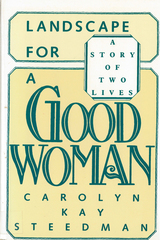 Landscape for a Good Woman: A Story of Two Lives
Carolyn Kay Steedman
Rutgers University Press, 1987 This book is about lives lived out on the borderlands, lives for which the central interpretative devices of the culture don't quite work. It has a childhood at its centre - my childhood, a personal past - and it is about the disruption of that fifties childhood by the one my mother had lived out before me, and the stories she told about it.' Intricate and inspiring, this unusual book uses autobiographical elements to depict a mother and her daughter and two working-class childhoods (Burnley in the 1920s, South London in the 1950s) and to find a place for their stories in history and politics, in psychoanalysis and feminism. 'Provocative and quite dazzling in its ambitions. . . Beautifully written, intellectually compelling'.' Judith Walkowitz 'Carolyn Steedman's 1950s South London childhood was shaped by her mother's longing: "What she actually wanted were real things, real entities, things she materially lacked, things that a culture and a social system withheld from her... When the world didn't deliver the goods, she held the world to blame." When Carolyn Steedman grows up and begins to look for reflections of her and her mother's lives in history, theory, and literature, she finds that "the tradition of cultural criticism that has employed working-class lives, and their rare expression in literature, has made solid and concrete the absence of psychological individuality - of subjectivity." Through an in-depth comparison of personal experience and prevailing political and social science theory on the psychology and attitudes of working-class people, Landscape for a Good Woman challenges an intellectual tradition that denies "its subjects a particular story, a personal history, except when that story illustrates a general thesis." In this poignantly written and thoroughly researched work, the common theoretical conclusion that the survival struggles of working-class people precludes the time necessary for more genteel "elaboration of relationships" is shot full of delightfully life-affirming holes.' -
--From 500 Great Books by Women; review by Jesse Larsen.
Landscape in the Longue Durée: A History and Theory of Pebbles in a Pebbled Heathland Landscape
Christopher Tilley
University College London, 2017 Pebbles are typically found only on beaches, in the liminal spaces between land and sea. But what happens when pebbles extend inland? The East Devon Pebblebed heathlands of the United Kingdom has a bedrock composed entirely of water-rounded pebbles. Using archaeological and anthropological perspectives, Christopher Tilley’s new book explores this region, from the Mesolithic to the Iron Ages, concluding with a twenty-first-century analysis. Tilley examines how the first early pebble structures built here still inform our contemporary culture, demonstrating how exceptional landscapes allow us to rethink continuity and change.
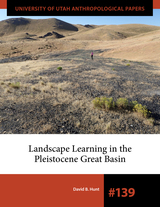 Landscape Learning in the Pleistocene Great Basin
David B. Hunt
University of Utah Press, 2025 As pioneering hunter-gatherer populations moved into unfamiliar regions, they faced the challenge of locating critical resources like food, water, and raw materials for tools, shelter, and clothing. While their descendants would eventually benefit from the accumulation of this knowledge over time, these first colonizers were forced to learn a new landscape from scratch. In Landscape Learning in the Pleistocene Great Basin, David B. Hunt proposes a quantitative model to explain the adaptive behaviors of the first groups of humans to settle in a particular area, a concept known as “landscape learning.”
Hunt seeks insight into the initial development of adaptive strategies related to the procurement of essential resources within a region. Incorporating data from archaeological investigation at the Old River Bed Delta in Utah and focusing specifically on the lithics recovered, Hunt develops what he terms the Discoverability Model. He proposes this model as a way for archaeologists to begin quantifying the qualitative aspects of colonization and landscape learning models.
Landscape Linkages and Biodiversity
Edited by Wendy Hudson; Foreword by M. Rupert Cutler; Defenders of Wildlife
Island Press, 1991 In Landscape Linkages and Biodiversity experts explain biological diversity conservation, focusing on the need for protecting large areas of the most diverse ecosystems, and connecting those ecosystems with land corridors to allow species to move among them more easily.
 Landscape, Memory and History: Anthropological Perspectives
Edited by Pamela J. Stewart and Andrew Strathern
Pluto Press, 2003 How do people perceive the land around them, and how is that perception changed by history? The contributors explore this question from an anthropological angle, assessing the connections between place, space, identity, nationalism, history and memory in a variety of different settings around the world. Taking historical change and memory as key themes, they offer a broad study that will appeal to a readership across the social sciences.
Contributors from North America, Australia, New Zealand, Taiwan, and Europe explore a wide variety of case studies that includes seascapes in Jamaica; the Solomon Islands; the forests of Madagascar; Aboriginal and European notions of landscape in Australia; place and identity in 19th century maps and the bogs of Ireland; contemporary concerns over changing landscapes in Papua New Guinea; and representations of landscape and history in the poetry of the Scottish Borders.
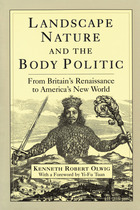 Landscape, Nature, and the Body Politic: From Britain's Renaissance to America's New World
Kenneth Robert Olwig
University of Wisconsin Press, 2002 Landscape, Nature, and the Body Politic explores the origins and lasting influences of two contesting but intertwined discourses that persist today when we use the words landscape, country, scenery, nature, national. In the first sense, the land is a physical and bounded body of terrain upon which the nation state is constructed (e.g., the purple mountain majesties above the fruited plain, from sea to shining sea). In the second, the country is constituted through its people and established through time and precedence (e.g., land where our fathers died, land of the Pilgrims’ pride). Kenneth Robert Olwig’s extended exploration of these discourses is a masterful work of scholarship both broad and deep, which opens up new avenues of thinking in the areas of geography, literature, theater, history, political science, law, and environmental studies.
Olwig tracks these ideas though Anglo-American history, starting with seventeenth-century conflicts between the Stuart kings and the English Parliament, and the Stuart dream of uniting Scotland with England and Wales into one nation on the island of Britain. He uses a royal production of a Ben Jonson masque, with stage sets by architect Inigo Jones, as a touchstone for exploring how the notion of "landscape" expands from artful stage scenery to a geopolitical ideal. Olwig pursues these contested concepts of the body politic from Europe to America and to global politics, illuminating a host of topics, from national parks and environmental planning to theories of polity and virulent nationalistic movements.
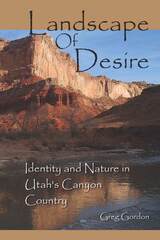 Landscape Of Desire
Greg Gordon
Utah State University Press, 2003 Landscape of Desire powerfully documents and celebrates a place and the evolutions that occur when human beings are intimately connected to their surroundings. Greg Gordon accomplishes this with a tapestry of writing that interweaves land use history, natural history, experiential education, and personal reflection. He tracks the geomorphology of southern Utah as well as the creatures and plants his student group encounters, the history lessons (planned and unplanned), the trials and joys of gathering so many individuals into a cohesive will, and his own personal epiphanies, restraints, insights, and disillusionments. Landscape of Desire examines the plight of the western landscape. It discusses a wide range of issues, including mining, grazing, dams, recreation, wilderness, and land management. Since recreation has replaced extraction industries as the primary use of wilderness, especially in southern Utah, Gordon addresses its impactful qualities. He overviews the history of the conflict between preservation and development and places these issues in a cultural context. The text is presented in a narrative format, following the individuals of one field course Gordon lead that explored Muddy Creek and the Dirty Devil River from Interstate 70 to Lake Powell. Though each chapter focuses on the geologic formation the group is traveling through, the plants, animals, ecology, and human impacts are all tightly woven into the narrative. Not only does the land affect the members of the field course, but their attitudes and insights affect the land. In Landscape of Desire Gordon achieves a vision of wholeness of this popular and contested region of Utah that centers around the implications of being human and also stewards of the wild.
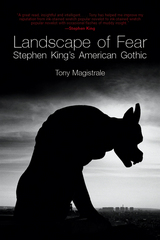 Landscape of Fear: Stephen King's American Gothic
Tony Magistrale
University of Wisconsin Press, 1988 One of the very first books to take Stephen King seriously, Landscape of Fear (originally published in 1988) reveals the source of King's horror in the sociopolitical anxieties of the post-Vietnam, post-Watergate era. In this groundbreaking study, Tony Magistrale shows how King's fiction transcends the escapism typical of its genre to tap into our deepest cultural fears: "that the government we have installed through the democratic process is not only corrupt but actively pursuing our destruction, that our technologies have progressed to the point at which the individual has now become expendable, and that our fundamental social institutions-school, marriage, workplace, and the church-have, beneath their veneers of respectability, evolved into perverse manifestations of narcissism, greed, and violence."
Tracing King's moralist vision to the likes of Twain, Hawthorne, and Melville, Landscape of Fear establishes the place of this popular writer within the grand tradition of American literature. Like his literary forbears, King gives us characters that have the capacity to make ethical choices in an imperfect, often evil world. Yet he inscribes that conflict within unmistakably modern settings. From the industrial nightmare of "Graveyard Shift" to the breakdown of the domestic sphere in The Shining, from the techno-horrors of The Stand to the religious fanaticism and adolescent cruelty depicted in Carrie, Magistrale charts the contours of King's fictional landscape in its first decade.
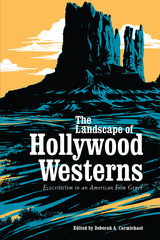 The Landscape of Hollywood Westerns: Ecocriticism in an American Film Genre
Carmichael, Deborah A
University of Utah Press, 2006 Films located in the American West and the Western as a cinematic genre have endured throughout the history of moviemaking. Today, this tradition of battles between good versus evil, populists versus profiteers, and man versus nature may have been largely assimilated and transformed into action adventures with car chases replacing mounted posses, yet the genre remains popular with audiences. In studies of the Hollywood Western, the importance of landscape itself, the idyllic or treacherous environment portrayed in these films, often receives supporting-role status. Without the land, however, American national mythmaking would not exist.
The essays in this volume scrutinize the special place of nature and landscape in films—including silent, documentary, and feature length film—that are specifically American and Western. The films discussed here go beyond the stereotypical sagebrush setting. Although many of the films closely fit the standard conventions of the Western, others demonstrate the fluidity of the genre. The wildness of the western environment as a central fact of the American mythos encompasses far more than a brief period of national history or a specific geographical location.
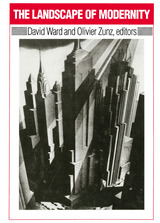 Landscape of Modernity: Essays on New York City, 1900-1940
David Ward
Russell Sage Foundation, 1992 New York City stands as the first expression of the modern city, a mosaic of disparate neighborhoods born in 1898 with the amalgamation of the five boroughs and shaped by the passions of developers and regulators, architects and engineers, politicians and reformers, immigrant entrepreneurs and corporate builders. Through their labor, their ideals, and their often fierce battles, the physical and social dimensions—the landscape—of the modern city were forged. The original essays in The Landscape of Modernity tell the compelling story of the growth of New York City from 1900 to 1940, from the beginnings of its skyscraper skyline to the expanding reaches of suburbanization. At the beginning of the century, New York City was already one of the world's leading corporate and commercial centers. The Zoning Ordinance of 1916, initially proposed by Fifth Avenue merchants as a means of halting the uptown spread of the garment industry, became the nation's first comprehensive zoning law and the proving ground for a new occupation—the urban planner. During the 1920s, frenzied development created a vertical metamorphosis in Manhattan's booming business district, culminating in its most spectacularly modern icon, the Empire State Building. The city also spread laterally, with the controversial development of subway systems and the creation of the powerful Port of New York Authority, whose new bridges and tunnels decentralized the population and industry of New York. New York's older ethnic enclaves were irrevocably altered by this new urban landscape: the Lower East Side's Jewish community was nearly dismantled by the flight of the garment industry and the attractiveness of new suburbs, while Little Italy fought government forces eager to homogenize commercial use of the streets by eliminating the traditional pushcart peddlers. Illustrated with striking photographs and maps, The Landscape of Modernity links important scenes of growth and development to the larger political, economic, social, and cultural processes of the early twentieth century.
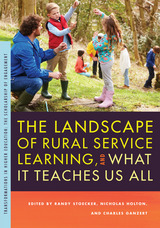 The Landscape of Rural Service Learning, and What It Teaches Us All
Randy Stoecker
Michigan State University Press, 2016 Up until now, the majority of literature about service learning has focused on urban areas, while comparatively little attention has been paid to activities in rural communities. The Landscape of Rural Service Learning, and What It Teaches Us All is designed to provide a comprehensive look at rural service learning. The practices that have developed in rural areas, partly because of the lack of nonprofits and other services found in urban settings, produce lessons and models that can help us all rethink the dominant forms of service learning defined by urban contexts. Where there are few formal organizations, people end up working more directly with one another; where there is a need for services in locations where they are unavailable, service learning becomes more than just an academic exercise or assignment. This volume includes theoretical frameworks that are informed by the rural, concrete stories that show how rural service learning has developed and is now practiced, practical strategies that apply across service learning contexts, and points to ponder as we all consider our next steps along the path of meaningful service learning.
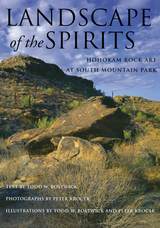 Landscape of the Spirits: Hohokam Rock Art at South Mountain Park
Text by Todd W. Bostwick; Photographs by Peter Krocek; Illustrations by Todd W. Bostwick and Peter Krocek
University of Arizona Press, 2002 High above the noise and traffic of metropolitan Phoenix, Native American rock art offers mute testimony that another civilization once thrived in the Arizona desert. In the city's South Mountains, prehispanic peoples pecked thousands of images into the mountains' boulders and outcroppings—images that today's hikers can encounter with every bend in the trail.
Todd Bostwick, an archaeologist who has studied the Hohokam for more than twenty years, and Peter Krocek, a professional photographer with a passion for archaeology, have combed the South Mountains to locate nearly all of the ancient petroglyphs found in the canyons and ridges. Their years of learning the landscape and investigating the ancient designs have resulted in a book that explores this wealth of prehistoric rock art within its natural and cultural contexts, revealing what these carvings might mean, how they got there, and when they were made.
Landscape of the Spirits is the first book to cover these ancient images and is one of the most comprehensive treatments of a rock art location ever published. It conveys the range of different rock art elements and compositions found in the South Mountains—animals, humans, and geometric shapes, as well as celestial and calendrical markings at key sites—through accurate descriptions, drawings, and photographs. Interpretations of the petroglyphs are based on Native American ethnographic accounts and consider the most recent theories concerning shamanism and archaeoastronomy.
Written in a simple and accessible style, Landscape of the Spirits is an indispensable volume for anyone exploring the South Mountains, and for rock art enthusiasts everywhere who wish to broaden their understanding of the prehistoric world. It is both an authoritative overview of these ancient wonders and an unprecedented benchmark in southwestern rock art research at a single geographic location.
Landscape Portrait Figure Form
Dean Rader
Omnidawn, 2014 A frog and a toad walk into a book of poems. They meet Paul Klee, Hieronymus Bosch, Adrienne Rich, Sesshu Toyo, Mark Twain, all of them escorted by Dean Rader. There are adventure poems, landscapes, assassins, self portraits, there are what some might call “ideas” mixed with some very funny moments, and what we might quite seriously call “emotions.” This collection will engage those interested in innovative, arresting, humorously engaging poetry.
Landscape with Bloodfeud
Wendy Barnes
University of Massachusetts Press, 2022 Scarred by nuclear smokestacks, oil wells, and surging floodwaters, and haunted by the legacies of slavery, racism, and French rule, the Louisiana of Landscape with Bloodfeud is disenchanted but still exerts an undeniable pull. Reckoning with displacement, ancestral guilt, and centuries of human and environmental exploitation, Wendy Barnes dissects the state’s turbulent past—as a microcosm of colonial oppression, westward expansion, and the birth of global capitalism. With an expat’s detachment, our Louisiana-born speaker contemplates her fraught relationship with her home culture and her white working-class roots, raising questions about complicity and shame, as history “bleeds us all for its tax, some for more, / digging down into every wet wound, / digging down among the taproots, under old folks’ / marble tombs or unmarked graves.”
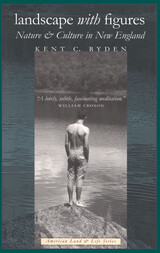 Landscape With Figures: Nature & Culture New England
Kent C. Ryden
University of Iowa Press, 2001 Kent Ryden does not deny that the natural landscape of New England is shaped by many centuries of human manipulation, but he also takes the view that nature is everywhere, close to home as well as in more remote wilderness, in the city and in the countryside. InLandscape with Figures he dissolves the border between culture and nature to merge ideas about nature, experiences in nature, and material alterations of nature. Ryden takes his readers from the printed page directly to the field and back again-. He often bypasses books and goes to the trees from which they are made and the landscapes they evoke, then returns with a renewed appreciation for just what an interdisciplinary, historically informed approach can bring to our understanding of the natural world. By exploring McPhee's The Pine Barrens and Ehrlich's The Solace of Open Spaces, the coastal fiction of New England, surveying and Thoreau's The Maine Woods,Maine's abandoned Cumberland and Oxford Canal, and the natural bases for New England's historical identity, Ryden demonstrates again and again that nature and history are kaleidoscopically linked.
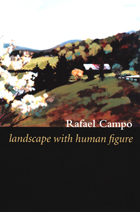 Landscape with Human Figure
Rafael Campo
Duke University Press, 2002 In Landscape with Human Figure, his fourth and most compelling collection of poetry, Rafael Campo confirms his status as one of America’s most important poets. Like his predecessor William Carlos Williams, who was also a physician, Campo plumbs the depths of our capacity for empathy. Campo writes stunning, candid poems from outside the academy, poems that arise with equal beauty from a bleak Boston tenement or a moonlit Spanish plaza, poems that remain unafraid to explore and to celebrate his identity as a doctor and Cuban American gay man. Yet no matter what their unexpected and inspired sources, Campo’s poems insistently remind us of the necessity of poetry itself in our increasingly fractured society; his writing brings us together—just as did the incantations of humankind’s earliest healers—into the warm circle of community and connectedness. In this heart-wrenching, haunting, and ultimately humane work, Rafael Campo has painted as if in blood and breath a gorgeously complex world, in which every one of us can be found.
Landscape with Smokestacks: The Case of the Allegedly Plundered Degas
Howard J. Treinens
Northwestern University Press, 2000 The dispute over Edgar Degas’s Landscape with Smokestacks was featured in newspapers and on television. But because the suit was settled before trial, the story behind the headlines was never publicly presented. Howard J. Trienens, a lawyer for the defendant collector, traces the landscape’s travels from its prewar home to its current location in the Art Institute of Chicago, laying out the mystery surrounding the work and demonstrating the legal complexities that plague Holocaust restitution cases, yet are seldom examined in depth by the media.
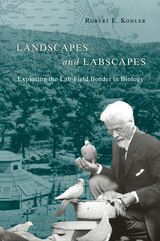 Landscapes and Labscapes: Exploring the Lab-Field Border in Biology
Robert E. Kohler
University of Chicago Press, 2002 What is it like to do field biology in a world that exalts experiments and laboratories? How have field biologists assimilated laboratory values and practices, and crafted an exact, quantitative science without losing their naturalist souls?
In Landscapes and Labscapes, Robert E. Kohler explores the people, places, and practices of field biology in the United States from the 1890s to the 1950s. He takes readers into the fields and forests where field biologists learned to count and measure nature and to read the imperfect records of "nature's experiments." He shows how field researchers use nature's particularities to develop "practices of place" that achieve in nature what laboratory researchers can only do with simplified experiments. Using historical frontiers as models, Kohler shows how biologists created vigorous new border sciences of ecology and evolutionary biology.
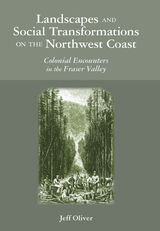 Landscapes and Social Transformations on the Northwest Coast: Colonial Encounters in the Fraser Valley
Jeff Oliver
University of Arizona Press, 2010 The Fraser Valley in British Columbia has been viewed historically as a typical setting of Indigenous-white interaction. Jeff Oliver now reexamines the social history of this region from pre-contact to the violent upheavals of nineteenth and early twentieth century colonialism to argue that the dominant discourses of progress and colonialism often mask the real social and physical process of change that occurred here—change that can be more meaningfully tied to transformations in the land.
The Fraser Valley has long been a scene of natural resource appropriation—furs and fish, timber and agriculture—with settlement patterns and land claims centering on the use of these materials. Oliver demonstrates how social change and cultural understanding are tied to the way that people use and remake the landscape. Drawing on ethnographic texts, archaeological evidence, cartography, and historical writing, he has created a deep history of the valley that enables us to view how human entanglements with landscape were creative of a variety of contentious issues. By capturing the multiple dynamics that were operating in the past, Oliver shows us not only how landscape transformations were implicated in constructing different perceptions of place but also how such changes influenced peoples’ understanding of history and identity.
This groundbreaking work examines engagement between people and the environment across a variety of themes, from aboriginal appropriation of nature to colonists’ reworking of physical and conceptual geographies, demonstrating the consequences of these interactions as they permeated various social and cultural spheres. It offers a new lens for viewing a region as it provides fresh insight into such topics as landscape change, perceptions of place, and Indigenous-white relations.
 Landscapes for Sport: Histories of Physical Exercise, Sport, and Health
Sonja Dümpelmann
Harvard University Press Sport is deeply embedded in human nature and culture, and it is central to human well-being. Outdoor sport and physical exercise have had considerable impact on how we design, live in, and understand landscapes. Landscapes and environments have, in turn, contributed to the formation and development of new sport activities as well as cultures of movement and the body. How have perceptions and politics of the body played a role in the evolution of different landscapes for sport? What do they tell us about their inherent culture and use, and how do landscapes for sport embody constructions of race, gender, and place? What are the interrelationships between more and less agonistic sport and body cultures, their politics, and the sites and spaces that accommodate them?
Landscapes for Sport explores these intersections from multiple perspectives in different parts of the world. They focus on outdoor spaces that have been designed, built, and used for physical exercise and various competitive and non-competitive sports since the early modern period. Frequently overlooked and taken for granted, these landscapes for sport often constitute significant areas of open space in and outside our cities. This volume uncovers their relevance and meanings.
 Landscapes in the Making
Stephen Daniels and Dell Upton
Harvard University Press How are landscapes created? Landscapes in the Making goes beyond professional design and planning to examine the social range of knowledge, technique, and imagination in the making and meaning of landscapes—from the work of quarrying and construction to that of cultivation, maintenance, stewardship, salvage, reclamation, ritual, and remembrance. Deploying an array of documentary, visual, and field sources, this volume brings to life the agency and skill of diverse and often disregarded peoples, in a range of periods and places, working in often demanding, precarious, and coercive conditions. Chapters focus on the physical and social worlds of trash dumps, gravel pits, and abandoned canneries as well as on construction sites for churches, palaces, parks, gardens, and government buildings. In addition to addressing local place-making, the volume surveys wider regional and international geographies of movement, both of people and materials. The landscapes described are far from finished—they are provisional, and always in the making.
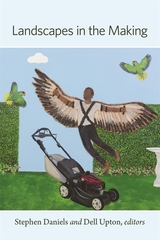 Landscapes in the Making
Stephen Daniels and Dell Upton
Harvard University Press How are landscapes created? Landscapes in the Making goes beyond professional design and planning to examine the social range of knowledge, technique, and imagination in the making and meaning of landscapes—from the work of quarrying and construction to that of cultivation, maintenance, stewardship, salvage, reclamation, ritual, and remembrance. Deploying an array of documentary, visual, and field sources, this volume brings to life the agency and skill of diverse and often disregarded peoples, in a range of periods and places, working in often demanding, precarious, and coercive conditions. Chapters focus on the physical and social worlds of trash dumps, gravel pits, and abandoned canneries as well as on construction sites for churches, palaces, parks, gardens, and government buildings. In addition to addressing local place-making, the volume surveys wider regional and international geographies of movement, both of people and materials. The landscapes described are far from finished—they are provisional, and always in the making.
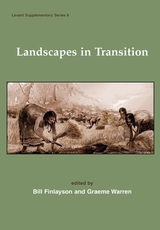 Landscapes in Transition
B. Finlayson
Council for British Research in the Levant, 2010 This volume presents a collection of papers focusing on archaeological approaches to landscape in the context of the adoption of agriculture in Southwest Asia and Northwest Europe. Case studies are presented from these contrasting regions, one where the transition to farming is indigenous, and the other where the transformation is initiated externally. This allows us to consider to what extent hunter-gatherer and farmer landscapes may be different, or the degree to which apparent differences have been constructed by our expectations and traditions of interpretation. While the concept 'landscape' enjoys considerable popularity in archaeological interpretation, it is somewhat ill-defined and inconsistently used. Some have suggested that this fluidity allows landscape to be a 'usefully ambiguous concept' but at times there is a danger that this very ambiguity affords imprecision in our narratives. This is particularly important where differing traditions of archaeological interpretation meet, as, for example, in the transition from hunting and gathering to farming. The transition has been understood as a major division in archaeological practice and attitudes to 'landscape' across the transition reflect this dichotomy. The results of these debates are illuminating, and raise questions beyond the immediate geographical scope of the volume. The contrast between the two regions provides valuable comparisons between traditions of archaeological theory and interpretation and the bodies of evidence.
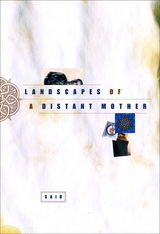 Landscapes of a Distant Mother
SAID
University of Chicago Press, 2004 Your smile.
There wasn't one.
You never smiled.
Born in Tehran but living in Germany, the eminent writer SAID has suffered two forms of exile. Forced to leave Iran for political reasons, he was also separated from his mother shortly after his birth when his parents divorced. At the age of forty-three, however, SAID received word that his mother was traveling abroad and wanted to see him. Landscapes of a Distant Mother is the account of their wrenching reunion. A memoir of longing and loss, the book offers a haunting portrait of a son's broken relationship with his mother and the Islamic dictatorship that shadows both their lives.
Landscapes of a Distant Mother gives English-speaking readers an introduction to one of Europe's most important immigrant writers. Unsentimental and spare, the book chronicles the discomfiting sensation of viewing one's mother as a stranger and all the psychological implications of their mutual disappointment. SAID's distance from his mother—whom he describes almost clinically, with her "particular way of speaking, the style laced with religious formulas, inclined to emotionalism, self-pity and expletives"—becomes a measure of the alienation he feels from everything around him. His book gives voice to the full meaning of modern exile—its political force, profound sadness, and perpetual yearning.
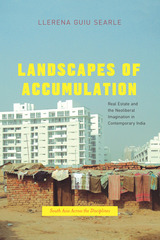 Landscapes of Accumulation: Real Estate and the Neoliberal Imagination in Contemporary India
Llerena Guiu Searle
University of Chicago Press, 2016 Over the past few decades, India has experienced a sudden and spectacular urban transformation. Gleaming business complexes encroach on fields and villages. Giant condominium communities offer gated security, indoor gyms, and pristine pools. Spacious, air-conditioned malls have sprung up alongside open-air markets.
In Landscapes of Accumulation, Llerena Guiu Searle examines India’s booming developments and offers a nuanced ethnographic treatment of late capitalism. India’s land, she shows, is rapidly transforming from a site of agricultural and industrial production to an international financial resource. Drawing on intensive fieldwork with investors, developers, real estate agents, and others, Searle documents the new private sector partnerships and practices that are transforming India’s built environment, as well as widely shared stories of growth and development that themselves create self-fulfilling prophecies of success. As a result, India’s cities are becoming ever more inaccessible to the country’s poor. Landscapes of Accumulation will be a welcome contribution to the international study of neoliberalism, finance, and urban development and will be of particular interest to those studying rapid—and perhaps unsustainable—development across the Global South.
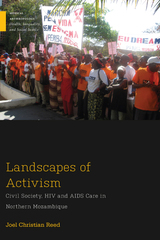 Landscapes of Activism: Civil Society, HIV and AIDS Care in Northern Mozambique
Reed, Joel Christian
Rutgers University Press, 2018 AIDS activists are often romanticized as extremely noble and selfless. However, the relationships among HIV support group members highlighted in Landscapes of Activism are hardly utopian or ideal. At first, the group has everything it needs, a thriving membership, and support from major donors. Soon, the group undergoes an identity crisis over money and power, eventually fading from the scene. As government and development institutions embraced activist demands—decentralizing AIDS care through policies of health systems strengthening—civil society was increasingly rendered obsolete. Charting this transition—from subjects, to citizens, and back again—reveals the inefficacy of protest, and the importance of community resilience. The product of in-depth ethnography and focused anthropological inquiry, this is the first book on AIDS activists in Mozambique. AIDS activism’s strange decline in southern Africa, rather than a reflection of citizen apathy, is the direct result of targeted state and donor intervention.
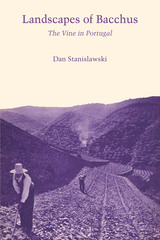 Landscapes Of Bacchus: The Vine in Portugal
By Dan Stanislawski
University of Texas Press, 1970 In a country of disparate parts and of long, unbroken historical experience, there may be one dominant feature, a clue to the character of its regions. In Portugal the vine serves as this clue. The vine has been an important aspect of the Iberian landscape since prehistoric times, and farmers still use Roman methods of cultivation that have been adapted to regional physical conditions and to socioeconomic structure. Southern Portugal today is almost vineless, but in the north three areas can be distinguished by their vine forms and their products. Dan Stanislawski examines these areas in detail. High tree-vines surround plots of grain in the Minho Province. The grains and the slightly acid Green Wines provide subsistence and cash for the densely settled area of owner-operated small farms. In the hanging garden terrace of the Douro, vines grown on tawny, baked schist slopes yield world-famous Port Wine, a product that must conform to strict quantity and quality controls supervised by the central government. Mature table wines are produced in the Dão, an isolated cul-de-sac where cordons of vines are planted on small, individually owned plots. Control of wine-making is exercised by a central governing group and by producers’ cooperatives. Various wines originate in central Portugal. The lesser demarcated zones of Setubal, Colares, Carcavelos, and Bucelas yield fine wines. In other parts of the central region several wine types are produced in bulk. Some are used for blending and some for aging into quality table wines, but none is distinguished as a wine whose character is derived from its geographical location. Dan Stanislawski demonstrates that vine form differences—and differences in the resulting product, wine—mirror the Portuguese historical experience and indicate regional distinctions in Portuguese life styles.
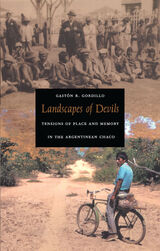 Landscapes of Devils: Tensions of Place and Memory in the Argentinean Chaco
Gastón R. Gordillo
Duke University Press, 2004 Landscapes of Devils is a rich, historically grounded ethnography of the western Toba, an indigenous people in northern Argentina’s Gran Chaco region. In the early twentieth century, the Toba were defeated by the Argentinean army, incorporated into the seasonal labor force of distant sugar plantations, and proselytized by British Anglicans. Gastón R. Gordillo reveals how the Toba’s memory of these processes is embedded in their experience of “the bush” that dominates the Chaco landscape. As Gordillo explains, the bush is the result of social, cultural, and political processes that intertwine this place with other geographies. Labor exploitation, state violence, encroachment by settlers, and the demands of Anglican missionaries all transformed this land. The Toba’s lives have been torn between alienating work in sugar plantations and relative freedom in the bush, between moments of domination and autonomy, abundance and poverty, terror and healing. Part of this contradictory experience is culturally expressed in devils, evil spirits that acquire different features in different places. The devils are sources of death and disease in the plantations, but in the bush they are entities that connect with humans as providers of bush food and healing power. Enacted through memory, the experiences of the Toba have produced a tense and shifting geography. Combining extensive fieldwork conducted over a decade, historical research, and critical theory, Gordillo offers a nuanced analysis of the Toba’s social memory and a powerful argument that geographic places are not only objective entities but also the subjective outcome of historical forces.
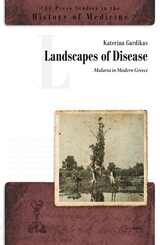 Landscapes of Disease: Malaria in Modern Greece
Katerina Gardikas
Central European University Press, 2018 Malaria has existed in Greece since prehistoric times. Its prevalence fluctuated depending on climatic, socioeconomic and political changes. The book focuses on the factors that contributed to the spreading of the disease in the years between independent statehood in 1830 and the elimination of malaria in the 1970s. By the nineteenth century, Greece was the most malarious country in Europe and the one most heavily infected with its lethal form, falciparum malaria. Owing to pressures on the environment from economic development, agrarian colonization and heightened mobility, the situation became so serious that malaria became a routine part of everyday life for practically all Greek families, further exacerbated by wars. The country’s highly fragmented geography and its variable rainfall distribution created an environment that was ideal for sustaining and spreading of diseases, which, in turn, affected the tolerance of the population to malaria. In their struggle with physical suffering and death, the Greeks developed a culture of avid quinine consumption and were likewise eager to embrace the DDT spraying campaign of the immediate post WW II years, which, overall, had a positive demographic effect.
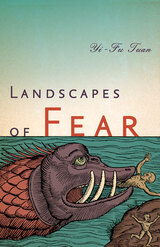 Landscapes of Fear
Yi-Fu Tuan
University of Minnesota Press, 2013
To be human is to experience fear, but what is it exactly that makes us fearful? Landscapes of Fear—written immediately after his classic Space and Place—is renowned geographer Yi-Fu Tuan’s influential exploration of the spaces of fear and of how these landscapes shift during our lives and vary throughout history.
In a series of linked essays that journey broadly across place, time, and cultures, Tuan examines the diverse manifestations and causes of fear in individuals and societies: he describes the horror created by epidemic disease and supernatural visions of witches and ghosts; violence and fear in the country and the city; fears of drought, flood, famine, and disease; and the ways in which authorities devise landscapes of terror to instill fear and subservience in their own populations. In this groundbreaking work—now with a new preface by the author—Yi-Fu Tuan reaches back into our prehistory to discover what is universal and what is particular in our inheritance of fear. Tuan emphasizes that human fear is a constant; it causes us to draw what he calls our “circles of safety” and at the same time acts as a foundational impetus behind curiosity, growth, and adventure.
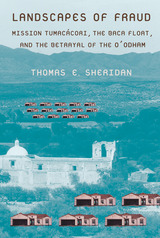 Landscapes of Fraud: Mission Tumacácori, the Baca Float, and the Betrayal of the O’odham
Thomas E. Sheridan
University of Arizona Press, 2006 From the actions of Europeans in the seventeenth century to the real estate deals of the modern era, people making a living off the land in southern Arizona have been repeatedly robbed of their way of life. History has recorded more than three centuries of speculative failures that never amounted to much but left dispossessed people in their wake. This book seeks to excavate those failures, to examine the new social spaces the schemers struggled to create and the existing social spaces they destroyed.
Landscapes of Fraud explores how the penetration of the evolving capitalist world-system created and destroyed communities in the Upper Santa Cruz Valley of Arizona from the late 1600s to the 1970s. Thomas Sheridan has melded history, anthropology, and critical geography to create a penetrating view of greed and power and their lasting effect on those left powerless.
Sheridan first examines how O’odham culture was fragmented by the arrival of the Spanish, telling how autonomous communities moving across landscapes in seasonal rounds were reduced to a mission world of subordination. Sheridan then considers the fate of the Tumacácori grant and Baca Float No. 3, another land grant. He tells the unbroken story of land fraud from Manuel María Gándara’s purchase of the “abandoned” Tumacácori grant at public auction in 1844 through the bankruptcy of the shady real estate developers who had fraudulently promoted housing projects at Rio Rico during the 1960s and ’70s.
As the Upper Santa Cruz Valley underwent a wrenching transition from a landscape of community to a landscape of fraud, the betrayal of the O’odham became complete when land, that most elemental form of human space, was transformed from a communal resource into a commodity bought and sold for its future value. Today, Mission Tumacácori stands as a romantic icon of the past while the landscapes that supported it lay buried under speculative schemes that continue to haunt our history.
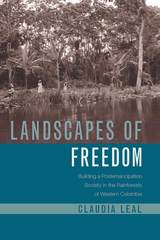 Landscapes of Freedom: Building a Postemancipation Society in the Rainforests of Western Colombia
Claudia Leal
University of Arizona Press, 2018 2019 Winner, Colombia Section, Michael Jiménez Prize, Latin American Studies Association
After emancipation in 1851, the African descendants living in the extra-humid rainforests of the Pacific coast of Colombia attained levels of autonomy hardly equaled anywhere else in the Americas. This autonomy rested on their access to a diverse environment—including small strips of fertile soils, mines, forests, rivers, and wetlands—that contributed to their subsistence and allowed them to procure gold, platinum, rubber, and vegetable ivory for export.
Afro-Colombian slave labor had produced the largest share of gold in the colony of New Granada. After the abolishment of slavery, some free people left the mining areas and settled elsewhere along the coast, making this the largest area of Latin America in which black people predominate into the present day. However, this economy and society, which lived off the extraction of natural resources, was presided over by a very small white commercial elite living in the region’s ports, where they sought to create an urban environment that would shelter them from the jungle.
Landscapes of Freedom reconstructs a nonplantation postemancipation trajectory that sheds light on how environmental conditions and management influenced the experience of freedom. It also points at the problematic associations between autonomy and marginality that have shaped the history of Afro-America. By focusing on racialized landscapes, Leal offers a nuanced and important approach to understanding the history of Latin America.
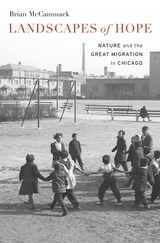 Landscapes of Hope: Nature and the Great Migration in Chicago
Brian McCammack
Harvard University Press, 2017 Winner of the Frederick Jackson Turner Award
Winner of the George Perkins Marsh Prize
Winner of the John Brinckerhoff Jackson Book Prize
“A major work of history that brings together African-American history and environmental studies in exciting ways.”
—Davarian L. Baldwin, Journal of Interdisciplinary History
Between 1915 and 1940, hundreds of thousands of African Americans left the rural South to begin new lives in the urban North. In Chicago, the black population quintupled to more than 275,000. Most historians map the integration of southern and northern black culture by looking at labor, politics, and popular culture. An award-winning environmental historian, Brian McCammack charts a different course, considering instead how black Chicagoans forged material and imaginative connections to nature.
The first major history to frame the Great Migration as an environmental experience, Landscapes of Hope takes us to Chicago’s parks and beaches as well as to the youth camps, vacation resorts, farms, and forests of the rural Midwest. Situated at the intersection of race and place in American history, it traces the contours of a black environmental consciousness that runs throughout the African American experience.
“Uncovers the untold history of African Americans’ migration to Chicago as they constructed both material and immaterial connections to nature.”
—Teona Williams, Black Perspectives
“A beautifully written, smart, painstakingly researched account that adds nuance to the growing field of African American environmental history.”
—Colin Fisher, American Historical Review
“If in the South nature was associated with labor, for the inhabitants of the crowded tenements in Chicago, nature increasingly became a source of leisure.”
—Reinier de Graaf, New York Review of Books
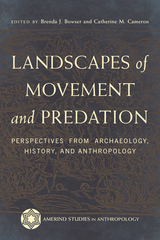 Landscapes of Movement and Predation: Perspectives from Archaeology, History, and Anthropology
Brenda J. Bowser and Catherine M. Cameron
University of Arizona Press, 2024 Landscapes of Movement and Predation is a global study of times and places where people were subject to brutality, displacement, and loss of life, liberty, livelihood, and possessions. Extensive landscapes of predation emerged in the colonial era when Europeans expanded across much of the world, appropriating land and demanding labor from Indigenous people, resulting in the enslavement of millions of Africans and Indigenous Americans.
Landscapes of predation also developed in precolonial times in places where people were subjected to repeated ruthless attacks and dislocation. With contributions from archaeologists and a historian, the book provides a startling new perspective on an aspect of the past that is often overlooked: the role of violence in shaping where, how, and with whom people lived. Using ethnohistoric, ethnographic, historic, and archaeological data, the authors explore the actions of both predators and their targets and uncover the myriad responses people took to protect themselves.
Contributors
Fernando Almeida
Thomas John Biginagwa
Brenda J. Bowser
Catherine M. Cameron
Charles Cobb
Robbie Ethridge
Thiago Kater
Richard M. Leventhal
Lydia Wilson Marshall
Cliverson Pessoa
Neil Price
Ben Raffield
Andrés Reséndez
Samantha Seyler
Fabíola Andréa Silva
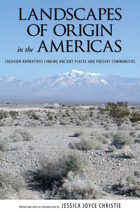 Landscapes of Origin in the Americas: Creation Narratives Linking Ancient Places and Present Communities
Edited and with an introduction by Jessica Joyce Christie
University of Alabama Press, 2009 Landscape is a powerful factor in the operation of memory because of the associations narrators make between the local landscape and the events of the stories they tell. Ancestors and mythological events often become fixed in a specific landscape and act as timeless reference points.
In conventional anthropological literature, "landscape" is the term applied to the meaning local people bestow on their cultural and physical surroundings. In this work, the authors explore the cultural and physical landscapes an individual or cultural group has constructed to define the origins or beginnings of that cultural group as revealed through shared or traditional memory. The cultural landscapes of origins in diverse sites throughout the Americas are investigated through multidisciplinary research, not only to reveal the belief system and mythologies but also to place these origin beliefs in context and relationship to each other. In a continual interaction between the past, present, and future, time is subordinate to place, and history, as defined in Western academic terms, does not exist.
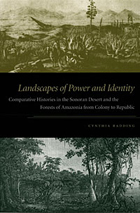 Landscapes of Power and Identity: Comparative Histories in the Sonoran Desert and the Forests of Amazonia from Colony to Republic
Cynthia Radding
Duke University Press, 2005 Landscapes of Power and Identity is a groundbreaking comparative history of two colonies on the frontiers of the Spanish empire—the Sonora region of northwestern Mexico and the Chiquitos region of eastern Bolivia’s lowlands—from the late colonial period through the middle of the nineteenth century. An innovative combination of environmental and cultural history, this book reflects Cynthia Radding’s more than two decades of research on Mexico and Bolivia and her consideration of the relationships between human societies and the geographic landscapes they inhabit and create. At first glance, Sonora and Chiquitos are quite different: one a scrub-covered desert, the other a tropical rainforest of the greater Amazonian and Paraguayan river basins. Yet the regions are similar in many ways. Both were located far from the centers of colonial authority, organized into Jesuit missions and linked to the principal mining centers of New Spain and the Andes, and then absorbed into nation-states in the nineteenth century. In each area, the indigenous communities encountered European governors, missionaries, slave hunters, merchants, miners, and ranchers. Radding’s comparative approach illuminates what happened when similar institutions of imperial governance, commerce, and religion were planted in different physical and cultural environments. She draws on archival documents, published reports by missionaries and travelers, and previous histories as well as ecological studies and ethnographies. She also considers cultural artifacts, including archaeological remains, architecture, liturgical music, and religious dances. Radding demonstrates how colonial encounters were conditioned by both the local landscape and cultural expectations; how the colonizers and colonized understood notions of territory and property; how religion formed the cultural practices and historical memories of the Sonoran and Chiquitano peoples; and how the conflict between the indigenous communities and the surrounding creole societies developed in new directions well into the nineteenth century.
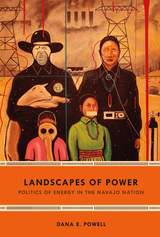 Landscapes of Power: Politics of Energy in the Navajo Nation
Dana E. Powell
Duke University Press, 2018 In Landscapes of Power Dana E. Powell examines the rise and fall of the controversial Desert Rock Power Plant initiative in New Mexico to trace the political conflicts surrounding native sovereignty and contemporary energy development on Navajo (Diné) Nation land. Powell's historical and ethnographic account shows how the coal-fired power plant project's defeat provided the basis for redefining the legacies of colonialism, mineral extraction, and environmentalism. Examining the labor of activists, artists, politicians, elders, technicians, and others, Powell emphasizes the generative potential of Navajo resistance to articulate a vision of autonomy in the face of twenty-first-century colonial conditions. Ultimately, Powell situates local Navajo struggles over energy technology and infrastructure within broader sociocultural life, debates over global climate change, and tribal, federal, and global politics of extraction.
 Landscapes of Preindustrial Urbanism
Georges Farhat
Harvard University Press As the world’s population continues to urbanize, the extensive reshaping and ecological transformation of the regions where cities develop have become mainstream concerns. Even the phrase “urban landscape” has evolved from modernist paradox to commonsense category. Yet what exactly does it cover? When did the phenomenon it denotes emerge, and how did it evolve across time and space? Could past dynamics of urban landscapes help reveal their present nature and anticipate future developments?
Answers to such questions are far from evident. While industrial pasts and postindustrial transitions of cities and their landscapes seem to be well charted, preindustrial conditions are only starting to be explored in a few, rapidly expanding fields of archaeology, historical geography, and heritage studies. These areas of study have benefited, over the past three decades, from tremendous advances and renewal in technologies, research methods, and conceptual frameworks. As a result, a wealth of knowledge is unearthed and landscapes turn out to be the very stuff of preindustrial urbanism. In fact, a paradigm shift is underway, according to which, during preindustrial times, landscapes and urbanism were formed in reciprocal relation. Landscapes of Preindustrial Urbanism seeks to introduce such a paradigm shift to landscape scholars and designers while offering alternative visions to urban historians and planners.
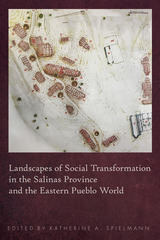 Landscapes of Social Transformation in the Salinas Province and the Eastern Pueblo World
Edited by Katherine A. Spielmann
University of Arizona Press, 2017 In the 1100s most Pueblo peoples lived in small, dispersed settlements and moved frequently, but by the mid-1400s they had aggregated into large villages. The majority of these villages were still occupied at Spanish contact and conquest, by which time most Pueblo peoples had completely transformed their perception and experience of village life. Other changes were taking place on a broader regional scale, and the migrations from the Colorado Plateau and the transformation of Chaco initiated myriad changes in ritual organization and practice.
Landscapes of Social Transformation in the Salinas Province and the Eastern Pueblo World investigates relationships between diverse regional and local changes in the Rio Grande and Salinas areas from 1100 to 1500 C.E. The contributing authors draw on the results of sixteen seasons of archaeological survey and excavation in the Salinas Province of central New Mexico. The chapters offer cross-scale analyses to compare broad perspectives in well-researched southwestern culture changes to the finer details of stability and transformation in Salinas. This stability—which was unusual in the Pueblo Southwest—from the 1100s until its abandonment in the 1670s provides an interesting contrast to migration-based transformations studied elsewhere in the Rio Grande region.
CONTRIBUTORS
Patricia Capone
Matthew Chamberlin
Tiffany C. Clark
William M. Graves
Cynthia L. Herhahn
Deborah Huntley
Keith Kintigh
Ann Kinzig
Jeannette L. Mobley-Tanaka
Alison E. Rautman
Jonathan Sandor
Grant Snitker
Julie Solometo
Katherine A. Spielmann
Colleen Strawhacker
Maryann Wasiolek
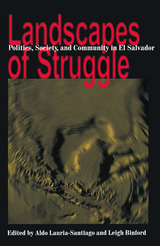 Landscapes Of Struggle: Politics Society And Community In El Salvador
Aldo Lauria-Santiago
University of Pittsburgh Press, 2004
During the 1980s, El Salvador's violent civil war captured the world's attention. In the years since, the country has undergone dramatic changes. Landscapes of Struggle offers a broad, interdisciplinary assessment of El Salvador from the late nineteenth century to the present, focusing on the ways local politics have shaped the development of the nation.
Proceeding chronologically, these essays-by historians, political scientists, sociologists, and anthropologists-explore the political, social, and cultural dynamics governing the Salvadoran experience, including the crucial roles of land, the military, and ethnicity; the effects of the civil war; and recent transformations, such as the growth of a large Salvadoran diaspora in the United States. Taken together, they provide a fully realized portrait of El Salvador's troublesome past, transformative present, and uncertain future.
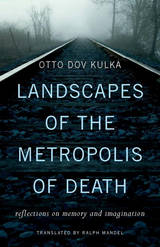 Landscapes of the Metropolis of Death: Reflections on Memory and Imagination
Otto Dov Kulka
Harvard University Press, 2013 Historian Otto Dov Kulka has dedicated his life to studying and writing about Nazism and the Holocaust. Until now he has always set to one side his personal experiences as a child inmate at Auschwitz. Breaking years of silence, Kulka brings together the personal and historical, in a devastating, at times poetic, account of the concentration camps and the private mythology one man constructed around his experiences.
Auschwitz is for the author a vast repository of images, memories, and reveries: “the Metropolis of Death” over which rules the immutable Law of Death. Between 1991 and 2001, Kulka made audio recordings of these memories as they welled up, and in Landscapes of the Metropolis of Death he sifts through these fragments, attempting to make sense of them. He describes the Family Camp’s children’s choir in which he and others performed “Ode to Joy” within yards of the crematoria, his final, indelible parting from his mother when the camp was liquidated, and the “black stains” along the roadside during the winter death march. Amidst so much death Kulka finds moments of haunting, almost unbearable beauty (for beauty, too, Kulka says, is an inescapable law).
As the author maps his interior world, readers gain a new sense of what it was to experience the Shoah from inside the camps—both at the time, and long afterward. Landscapes of the Metropolis of Death is a unique and powerful experiment in how one man has tried to understand his past, and our shared history.
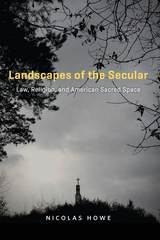 Landscapes of the Secular: Law, Religion, and American Sacred Space
Nicolas Howe
University of Chicago Press, 2016 “What does it mean to see the American landscape in a secular way?” asks Nicolas Howe at the outset of this innovative, ambitious, and wide-ranging book. It’s a surprising question because of what it implies: we usually aren’t seeing American landscapes through a non-religious lens, but rather as inflected by complicated, little-examined concepts of the sacred.
Fusing geography, legal scholarship, and religion in a potent analysis, Howe shows how seemingly routine questions about how to look at a sunrise or a plateau or how to assess what a mountain is both physically and ideologically, lead to complex arguments about the nature of religious experience and its implications for our lives as citizens. In American society—nominally secular but committed to permitting a diversity of religious beliefs and expressions—such questions become all the more fraught and can lead to difficult, often unsatisfying compromises regarding how to interpret and inhabit our public lands and spaces. A serious commitment to secularism, Howe shows, forces us to confront the profound challenges of true religious diversity in ways that often will have their ultimate expression in our built environment. This provocative exploration of some of the fundamental aspects of American life will help us see the land, law, and society anew.
 Landscapes of Warfare: Urartu and Assyria in the Ancient Middle East
Tiffany Earley-Spadoni
University Press of Colorado, 2025 Landscapes of Warfare offers an in-depth exploration of the Urartian empire, which occupied the highlands of present-day Turkey, Armenia, and Iran in the early first millennium BCE. Lesser known than its rival, the Neo-Assyrian empire, Urartu presents a unique case of imperial power distributed among mountain fortresses rather than centralized in cities. Through spatial analysis, the book demonstrates how systematic warfare, driven by imperial ambitions, shaped Urartian and Assyrian territories, creating symbolically and materially powerful landscapes.
Tiffany Earley-Spadoni challenges traditional views by emphasizing warfare’s role in organizing ancient landscapes, suggesting that Urartu’s strength lay in its strategic optimization of terrain through fortified regional networks. Using an interdisciplinary approach that includes GIS-enabled studies and integrates archaeological, historical, and art-historical evidence, she illustrates how warfare was a generative force in structuring space and society in the ancient Middle East. Landscapes of Warfare situates Urartu’s developments within the broader context of regional empires, providing insights into the mechanisms of warfare, governance, and cultural identity formation.
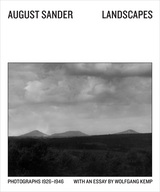 Landscapes: Photographs 1926-1946
August Sander
University of Chicago Press, 2016 In 1975, German readers were introduced to the Rheinlandschaften, a collection of stunning images of the Rhineland captured in the first half of the twentieth century by photographer August Sander (1876–1964). This fresh edition, now in English, brings Sander’s work to a new audience and into our own time.
These photographs showcase a variety of scenes, from a sunrise over Cologne to the slopes of the Rhine valley. The Rhine River flows through many of these pictures, its dynamic curves and lively current leading the eye through an intriguing mix of natural and urban landscapes. A new essay by art historian Wolfgang Kemp provides context for Sander’s work while introducing his contemporaries, including the writer Hans Ludwig Mathar and the painter Franz M. Jansen. Also explored are the ties between Sander’s landscapes and his portrait photography, which is celebrated worldwide. Crucially, Kemp highlights the need to consider the Rhineland’s unique political situation in the 1920s and 1930s for any discussion of Sander’s artistic approach.
Shining welcome light on the full range of Sander’s practice, this book offers a glorious journey through the landscapes that most affected him.
Landscapes: Selected Writings of J.B. Jackson
J. B. Jackson
University of Massachusetts Press, 1970 The author views landscaping as an expression of a way of life. This collection of essays is written for the general reader and features articles without footnotes. The subject matter ranges from disquisitions on ordinary houses, yards, farms, and farmsteads to notes on ecology and from the impact of automobile use, mobile homes, shopping centers, and rural and urban planning to philosophical arguments about the meaning of human space and arguments for and against preservation.
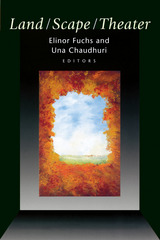 Land/Scape/Theater
Elinor Fuchs and Una Chaudhuri, Editors
University of Michigan Press, 2002 Land/Scape/Theater proposes landscape as a necessary paradigm for understanding modern theater's increasingly spatialized aesthetic as well as its engagement with the cultural meanings of place and space.
Embracing subjects as diverse as the "landscape dramaturgy" of Suzan-Lori Parks, Artaud's trip to the Sierra Madre,Gertrude Stein's landscape theory and practice, Guillermo Gomez-Peña's "border subjects," and Bayreuth and Disneyland as cultic sites, Land/Scape/Theater draws on a broad range of theory, dramatic texts, and performance. All aspects of modern theater, these essays suggest, including the bedrock Aristotelian constituents of plot and character, have a landscape dimension that often goes unrecognized.
With its broad theoretical range and cross-disciplinary reach, Land/Scape/Theater will interest theater theorists and practitioners and cultural studies specialists, including historians of landscape. Theater students, scholars, teachers, directors, designers, and actors will find here a new framework and a new vocabulary for understanding both theater and the larger culture.
 Landscaping Indigenous Mexico: The Liberal State and Capitalism in the Purépecha Highlands
Fernando Pérez Montesinos
University of Texas Press, 2025 A history of the Purépecha people's survival amid environmental and political changes. Landscapes are more than geological formations; they are living records of human struggles. Landscaping Indigenous Mexico unearths the history of Juátarhu, an Indigenous landscape shaped and nurtured by the Purépecha—a formidable Mesoamerican people whose power once rivaled that of the Aztecs. Although cataclysmic changes came with European contact and colonization, Juátarhu’s enduring agroecology continued to sustain local life through centuries of challenges. Contesting essentialist narratives of Indigenous penury, Pérez Montesinos shows how Purépechas thrived after Mexican independence in 1821, using Juátarhu’s diverse agroecology to negotiate continued autonomy amid waves of national economic and political upheaval. After 1870, however, autonomy waned under the pressure of land privatization policies, state intervention, and industrial logging. On the eve of the Mexican Revolution in 1910, Purépechas stood at a critical juncture: Would the Indigenous landscape endure or succumb? Offering a fresh perspective on a seemingly well-worn subject, Pérez Montesinos argues that Michoacán, long considered a peripheral revolutionary region, saw one of the era’s most radical events: the destruction of the liberal order and the timber capitalism of Juátarhu.
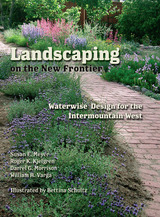 Landscaping on the New Frontier: Waterwise Design for the Intermountain West
Susan E. Meyer, Roger K. Kjelgren, Darrel G. Morrison, and William A. Varga
Utah State University Press, 2009 A practical volume for the home or business owner on landscaping with native, drought-tolerant plants in the Rocky Mountain West. Filled with color illustrations, photos, and design sketches, over 100 native species are described, while practical tips on landscape design, water-wise irrigation, and keeping down the weeds are provided.
In this book you will learn how to use natural landscapes to inspire your own designed landscape around your business or home and yard. Included are design principles, practical ideas, and strong examples of what some homeowners have already done to convert traditional "bluegrass" landscapes into ones that are more expressive of theWest. Landscaping on the new Frontier also offers an approach to irrigation that minimizes the use of supplemental water yet ensures the survival of plants during unusually dry periods. You will learn how to combine ecological principles with design principles to create beautiful home landscapes that require only minimal resources to maintain.
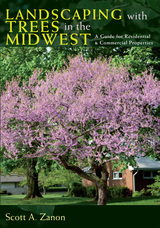 Landscaping with Trees in the Midwest: A Guide for Residential and Commercial Properties
Scott A. Zanon
Ohio University Press, 2014 Trees not only add beauty and value to property but also enhance the physical environment by providing shade, reflecting heat, and blocking wind. Choosing the right trees for the right location and conditions, however, is not always easy: each species has its own requirements for sunlight, water, drainage, and protection. Landscaping with Trees in the Midwest: A Guide for Residential and Commercial Properties describes sixty-five desirable tree species, their characteristics, and their uses. More than 325 color photographs illustrate the appearance of each species through the seasons—including height, shape, bark, flowers, and fall colors—as well as other factors that influence selection and siting in order to help the landscape professional or homeowner make informed choices. This guidebook also considers trees as a factor in overall environmental health and gives special consideration to the effects of the emerald ash borer, which continues to wreak havoc in wooded areas of the Midwest, offering replacement alternatives for vulnerable areas. In addition to the text and photos, the book includes a table of growth rates and sizes, a map of hardiness zones, and other valuable reference tools.
Landsickness
Leigh Lucas
Tupelo Press, 2024 A lyric essay about young love and loss and the aftermath of a former lover’s suicide.
Landsickness explores the inelegant progress of grief and pursues a relentless search for evidence of the beloved’s presence through the physics of splashes, the history of seasickness, and the science of depression. While full of tenderness, the poems employ humor and honesty to observe the ugliness of grief and the failure of elegy to restore the dead.
From the funeral to the office of her dead-end job to navigating the streets of New York, the speaker experiences a series of false starts as she learns to cope with her new life. Still, there is a real sense of progression in the collection’s end, even as the speaker continues to ask herself: “Why am I obsessed with the physics of his fall?"
Lanford Wilson: Early Stories, Sketches, and Poems
David Crespy
University of Missouri Press, 2026 Before Lanford Wilson became a Pulitzer Prize–winning playwright, with such celebrated productions as The Hot l Baltimore, Fifth of July, Talley’s Folly, and Burn This, he wrote dozens of short stories and poems, many of which take place in the 1950s, small-town Missouri where he grew up. This selection of Wilson’s early work, written between 1955 and 1967 when he was between the ages of 18 and 30, provides a rare look at a young writer developing his style. The stories explore many of the themes Wilson later took up in the theater, such as sexual identity and the rupture of societies and families. These never-before-published works—part of the manuscript collection donated by Wilson to the University of Missouri—shed light on the roots of some of America’s best-loved plays and are accomplished and evocative works in their own right.
Langston Hughes and the Blues
Steven C. Tracy
University of Illinois Press, 2024 The shades and structures of the blues had an immense impact on the poetry of Langston Hughes. Steven C. Tracy provides a cultural context for Hughes’s work while revealing how Hughes mined Black oral and literary traditions to create his poetry. Comparing Hughes’s poems to blues texts, Tracy reveals how Hughes’s experimental forms reflect the poetics, structures, rhythms, and musical techniques of the music. Tracy also offers a discography of recordings by the artists--Bessie Smith, Ma Rainey, Blind Lemon Jefferson, and others--who most influenced the poet.
|
|


